Watch CBS News

The best (and worst) original "Star Trek" episodes
By David Morgan
September 3, 2016 / 10:46 AM EDT / CBS News

Premiering on September 8, 1966, "Star Trek" was on the air for just three years on NBC, but the series about the crew of the Starship Enterprise, starring William Shatner and Leonard Nimoy, lived long and prospered in syndication, before making the jump to the big screen.
Only 79 episodes were created for the original series, with many gems of sci-fi entertainment (and some, not-so-much).
Click though our gallery to check out - in chronological order - the 20 best "Star Trek" episodes (and the 10 worst).
By CBSNews.com senior producer David Morgan
Watch original "Star Trek" episodes on CBS All Access
New series, "Star Trek" Discovery," debuts on CBS All Access in September 2017

“The Naked Time”
First aired: September 29, 1966
The camaraderie of the Enterprise crew was one of the show’s greatest selling points, and was evident fairly early in its run. But this episode showed when the starship crew was falling apart - blighted by a virus that provokes irrational and highly emotional behavior among those infected, putting the entire ship in jeopardy. Most memorable was Sulu’s turn as a swashbuckling fencer, foiled by a Vulcan nerve pinch.
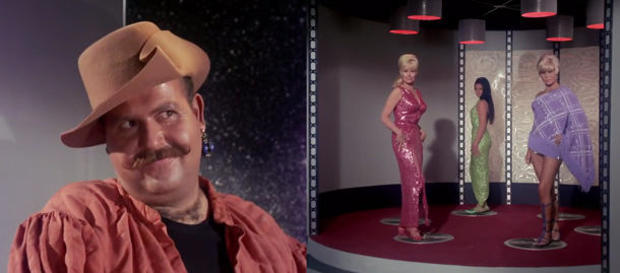
“Mudd’s Women”
First aired: October 13, 1966
A con man, Harcourt Fenton Mudd (Roger C. Carmel), is brought on board the Enterprise along with his human cargo: three voluptuous women who, it turns out, are made staggeringly beautiful thanks to an illegal “Venus drug.” So why are they opting for lives as mail-order brides to settlers on a distant planet? While the plot is not all that great, Mudd, as played by Carmel, is a delight - so much so that he returned in a later episode, on a planet filled with beautiful female robots.
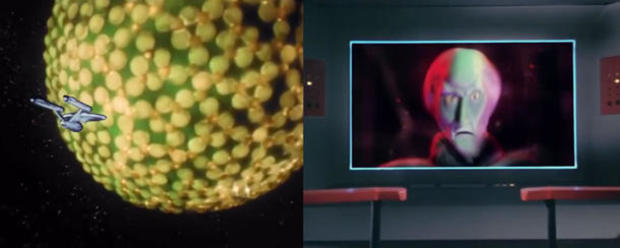
“The Corbomite Maneuver”
First aired: November 10, 1966
In the uncharted regions of space, a good and resourceful ship’s caption must also be good at poker - calling the bluff of your adversary. That is especially important when confronted by a gigantic (and I mean GIGANTIC) spaceship whose captain threatens you with annihilation.
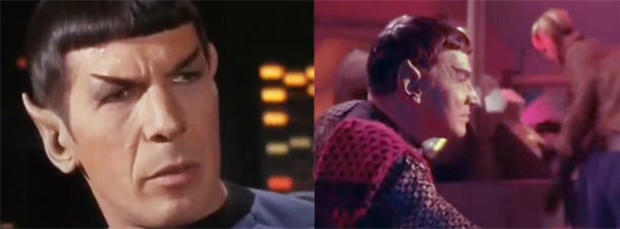
“Balance of Terror”
First aired: December 15, 1966
It was in this episode (inspired by a World War II submarine thriller, “The Enemy Below”) that we learn a bit of Vulcan history, with the Enterprise encountering a Romulan warship. The Romulans have attacked several Federation outposts near the Neutral Zone, but have never been seen, before a transmission is intercepted, revealing that Romulans look just like Vulcans! As crewmembers question the loyalty of First Officer Spock (whose ancestors have blood ties to Romulans), Kirk must play cat-and-mouse with the alien ship (which is hidden by a cloaking device) before it can retreat back into Romulan territory.
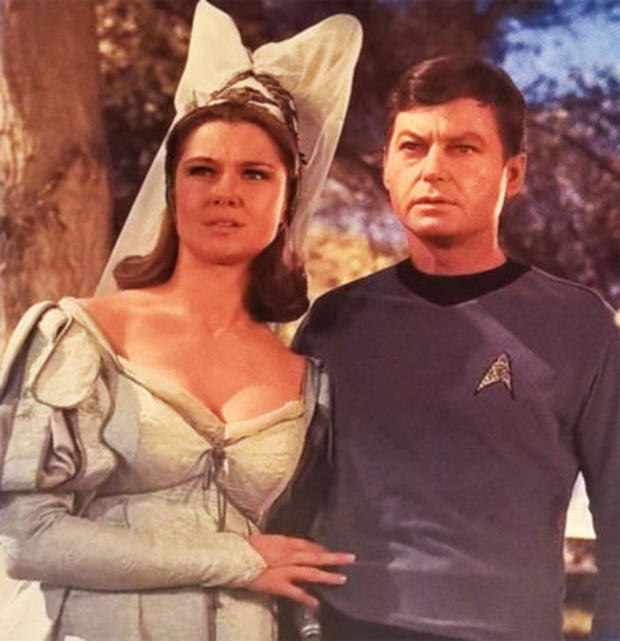
“Shore Leave”
First aired: December 29, 1966
Sci-fi author Theodore Sturgeon penned this memorable tale of a planet where people’s thoughts and memories suddenly appear in the flesh. Alice and the White Rabbit? A samurai? A knight on horseback? A World War II fighter plane? When crewmembers on shore leave start dying, Kirk has to get to the bottom of it. The answer? As Spock would say, “fascinating.”

“Tomorrow Is Yesterday”
In “The Naked Time” an experiment involving anti-matter threw the Enterprise back in time, by a matter of days. In this episode, an encounter with a black hole plunges the Enterprise back to 20th century Earth, where it is seen by an Air Force pilot scrambled to track the UFO. Beamed aboard the Enterprise, Captain John Christopher (Roger Perry) is distraught that he can’t be returned (he’s already seen too much). But then the effects of potentially changing future history by his absence have to be weighed - and Kirk finds there is no easy solution.
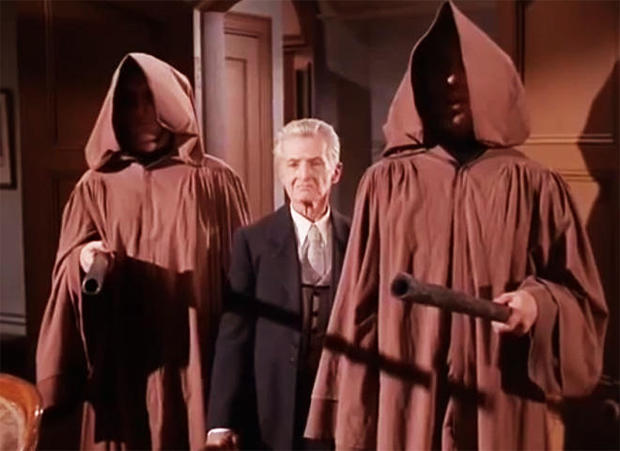
“The Return of the Archons”
First aired: February 9, 1967
A community on planet Beta III exhibits the characteristics of a hive mind, when the townspeople en masse attack Kirk and crew. They are in thrall to their omniscient leader, Landru, and seek to absorb anyone who is “not of the body.” The climactic reveal became something of a tired fixture in “Star Trek” (in which an all-powerful being is shown to actually be a robot, a computer, or a testy little kid). But a shot of the townspeople collectively stooping to pick up rocks - the better to “greet” their visitors - is chilling.
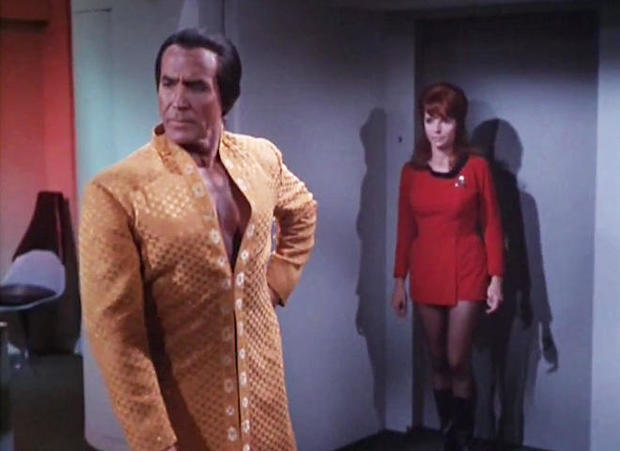
“Space Seed”
First aired: February 16, 1967
The Enterprise comes across a derelict ship, the SS Botany Bay, which carries the hibernating bodies of dozens of humans from late 20th century Earth. Turns out they are genetically-modified beings responsible for Earth’s Eugenics War. Their leader, Khan Noonien Singh (Ricardo Montalban), is awakened from hibernation, which is a bad idea - he frees his followers and tries to take over the Enterprise.
What was a nifty one-off episode would inspire the best of the “Star Trek” movies, 1982’s “Star Trek II: The Wrath of Khan,” when Khan and his people, living in exile on a desert planet, commandeer a passing ship and hunt down the man responsible for their plight: James T. Kirk!

“The Devil in the Dark”
First aired: March 9, 1967
“Star Trek” did not go in much for horror, and used the ugly-alien-monster-that-must-be-killed trope less than other sci-fi series. But this tale of a mining colony where workers are attacked and killed by a mysterious creature was both an engrossing encounter with an unknown threat, and a story of learning to co-exist with other creatures, even those whose appearance may be repellent (and that’s how the alien Horta views humans).

“The City on the Edge of Forever”
First aired: April 6, 1967
The hands-down best episode of “Star Trek” is a riveting tale of time travel and altered history. When McCoy steps through a time portal back to Depression-era Earth, he saves the life of a peace activist in a traffic accident. That good deed unfortunately allows the Nazis to triumph during World War II, altering the course of history, and threatening the very existence of the Enterprise crew. Following McCoy, Kirk realizes that to set things right, the very woman he has fallen for back in the 1930s must die.
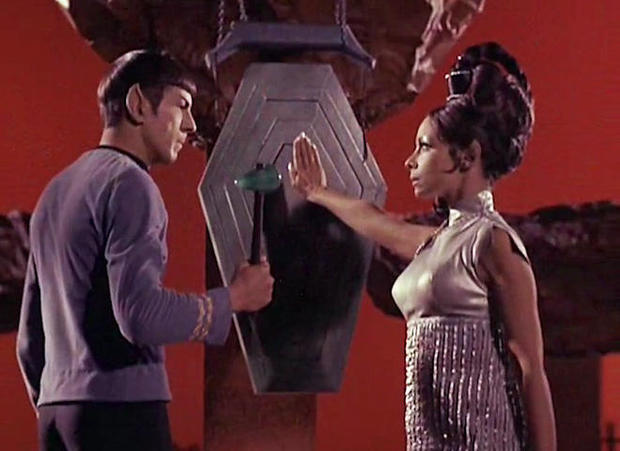
“Amok Time”
First aired: September 15, 1967
Vulcan biology - as in the need to mate every seven years, or die - makes it imperative for Kirk to risk his professional career to get Spock back to his home planet, and to the young bride to whom his first officer had been betrothed. But Vulcan traditions about marriage and procreation are much more complicated, especially when the bride is allowed to choose a champion to fight her intended to the death - a contest that pits Spock against Kirk!
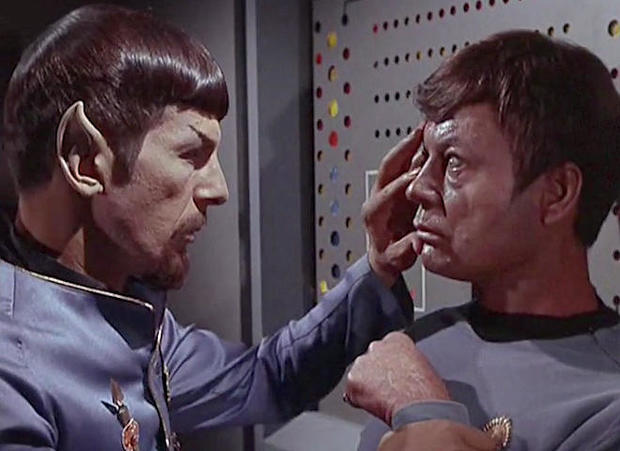
“Mirror, Mirror”
First aired: October 6, 1967
“Evil twins” became a mainstay of TV pop culture, allowing actors to play “bad” versions of their characters. Here, a transporter malfunction sends Kirk, McCoy, Uhuru and Scotty into a parallel universe, but one in which the Federation is an evil empire, with starship crews employing assassination as a form of career advancement. Will Kirk, etc. survive, or will “evil Spock” have the last laugh?

“The Doomsday Machine”
First aired: October 20, 1967
Guest star William Windom gives a terrific performance as Commodore Matt Decker, commander of the USS Constellation, who witnessed his entire crew destroyed by a giant, planet-eating machine. Like Ahab hunting the white whale, Decker commandeers the Enterprise and engages in a suicidal mission to destroy the machine once and for all.
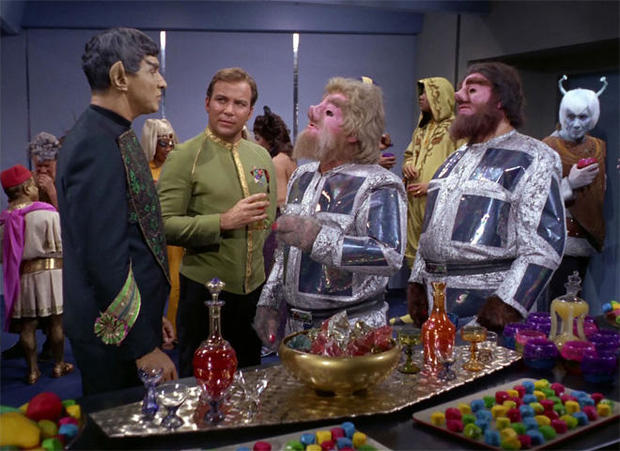
“Journey to Babel”
First aired: November 17, 1967
The difficult family dynamics of Spock - whose father was Vulcan and mother human - are explored in this story featuring Mark Lenard as Sarek, a Vulcan ambassador en route to a diplomatic conference. When an assassin murders one of the traveling dignitaries, the investigation opens the wounds of a father-son relationship, leading to a kind of reconciliation.
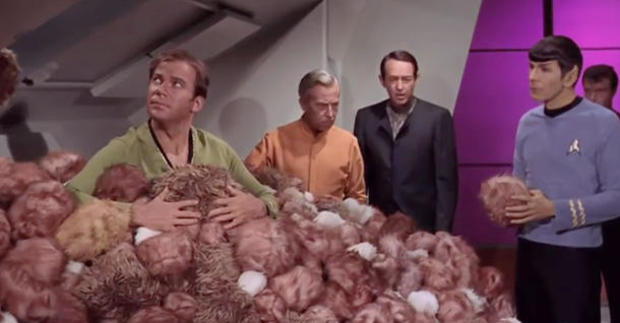
“The Trouble With Tribbles”
First aired: December 29, 1967
A fan favorite, this was the first “Trek” episode played for laughs. An interstellar salesman’s pet tribbles - purring balls of fur that love to multiply - become a real pain for Kirk, who also has to deal with Klingon saboteurs, obnoxious space diplomats, and crew members who brawl in bars.
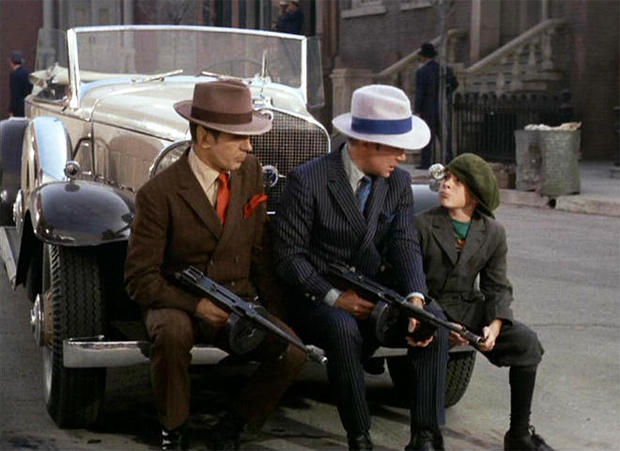
“A Piece of the Action”
First aired: January 12, 1968
Another humorous episode - and it is heartening to know that old gangster movies would be familiar to 23rd century space travelers like Kirk, who spouts the patois of James Cagney. Unlike other developing alien worlds which must be protected from knowledge about the Federation via the Prime Directive (so as not to taint them), the “gangsters” on Sigma Iotia II are fully aware of outside civilizations - they’ve designed their entire culture on a book, “Chicago Mobs of the Twenties,” brought there by an Earth ship 100 years earlier. When Kirk, Spock and McCoy beam down to the planet, they find a mob boss who wants to trade up from Tommy guns to phasers, leaving Kirk to sell the Federation’s protection racket. After all, Sigma Iotia II is a nice planet - you wouldn’t want something to happen to it.

“The Immunity Syndrome”
An entire ship manned by Vulcans is destroyed, creating a psychic blow that hits Spock hard. But he recovers enough to then investigate the cause of that destruction: a giant, single-cell organism that is eating away at space, destroying worlds and threatening the entire galaxy. It was one threat that didn’t have to be reasoned with, tricked, negotiated with, seduced or tackled in a fistfight - just destroyed (if possible).
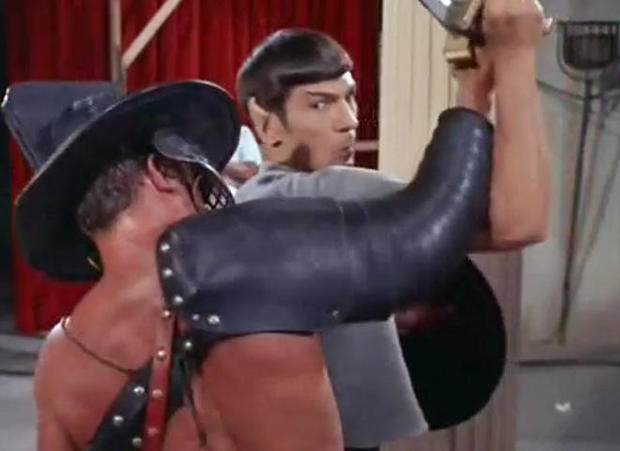
“Bread and Circuses”
First aired: March 15, 1968
What is that member of the crew of the SS Beagle doing in a mysterious TV broadcast, engaged in a deadly gladiatorial fight in a Rome that never fell? Kirk, Spock and McCoy investigate, and find the society on the planet Magna Roma mirroring the glories of ancient Rome, but with the technological advances of 20th century Earth, such as color television. Some clever satire on the fickleness of TV programming, as the Enterprise officers are forced to fight before the cameras, but also a “Twilight Zone”-like twist, when the rebellious Children of the Sun are revealed to worship something other than that star in the sky.
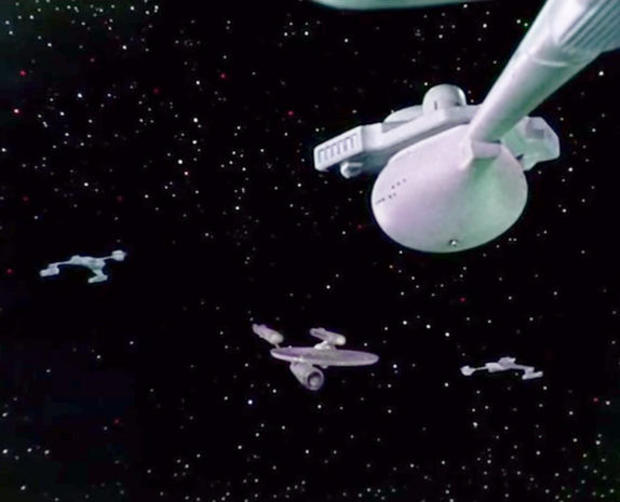
“The Enterprise Incident”
First aired: September 27, 1968
In a deft bit of intergalactic espionage and military brinkmanship, the Enterprise enters the Neutral Zone, only to be surrounded by three Romulan ships. Kirk and Spock are brought before the Romulan commander, whereupon Spock outs Kirk as having intentionally intruded on Romulan space. Or did he?
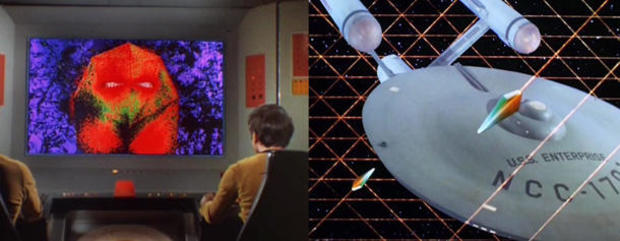
“The Tholian Web”
First aired: November 15, 1968
Engaged in a rescue mission when Captain Kirk is stranded in a space-time rift, Spock must also contend with the Tholians, whose entrance has further distorted the inter-dimensional rift, jeopardizing Kirk and putting the entire crew at risk. The alien not only looks cool; their ships’ energy field - a criss-cross web entrapping the Enterprise - is one of the most memorable visuals in the series.

“Arena”
First aired: January 19, 1967
Fond memories of Kirk’s one-on-one battle with a Gorn, adapted from Fredric Brown’s classic short story, collide with the realization that this episode doesn’t make much sense. Never mind the monotony of their faceoff as the Enterprise crew watches, helpless, to see whether Kirk will be victorious, sparing their lives from the alien referee forcing the two ships’ captains to duke it out, ‘cause he can. Kirk ultimately downs the slow-moving Gorn by mixing mineral deposits he comes across to make gunpowder, conveniently recalling the chemical composition of something which had been out of use for at least 200 years. And when Kirk refuses to kill the Gorn, everyone’s lives are spared, proving humans are more compassionate than the higher life forms that toy with us for their own amusement.

“The Alternative Factor”
First aired: March 30, 1967
The Enterprise picks up a man, named Lazarus, who claims to have pursued his enemy across centuries and into a parallel universe. The “anti-Lazarus,” possibly a form of anti-matter, spells disaster for both universes should the two ever come into contact. A plethora of plot holes and ridiculous dialogue (“He’ll kill us all if you don’t kill him first! Kill! Kill! Kill! Kill! Kill!”) bring this one under.

“Return to Tomorrow”
First aired: February 9, 1968
A disembodied consciousness that lives in a sphere within a long-dead planet enters the body of Captain Kirk, and then conscripts the Enterprise’s crew to construct humanoid robots that his fellow intangible beings can inhabit, ‘cause who doesn’t prefer a flesh-and-blood body to a glowing orb?

“Patterns of Force”
First aired: February 16, 1968
One of the lesser “Trek” episodes in which Kirk and Spock explore an alien world that resembles Earth’s past. On the planet Ekos, a Starfleet academic named John Gill has replicated a society mimicking Nazi Germany, on the rich assumption that the nastier elements of Hitler’s Third Reich - genocide, oppression, war-mongering - can be avoided. Tell that to the people of neighboring planet Zeon, whose population is threatened with a “final solution” brought by Gill’s adherents. Oh, and that Prime Directive? Once it’s been broken, apparently Federation crew members are free to up and join a local resistance, interfering just enough to bring down the regime and save Zeon.

“The Omega Glory”
First aired: March 1, 1968
Yes, this aired during the Cold War. And a similar conflict was also taking place light-years away, on the planet Omega IV, where a long-ago parallel Cold War led to the near-annihilation of “Yangs” and “Kohms.” (Yankees and Communists, get it?) Kirk and crew discover remnants of the Yang society carrying Old Glory and honoring faded documents that read exactly like the United States’ Constitution. Because in a universe with potentially millions of habitable planets, why wouldn’t one of them also develop a system of representative democracy that mirrors ours, word for word, right down to the Preamble?
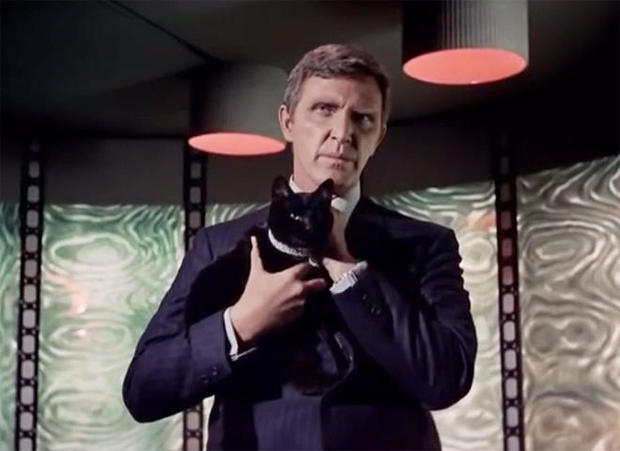
“Assignment: Earth”
First aired: March 29, 1968
Gene Roddenberry’s pilot for a proposed series about an alien secret agent on 1960s Earth wasn’t helped by shoehorning it into the “Star Trek” universe, forcing Kirk and Spock to travel back in time to the ‘60s. There they basically watched helplessly as Gary Seven (Robert Lansing), his ditsy secretary (Teri Garr), and a cat engage in some subterfuge that would - Seven claims - prevent World War III. One rocket explosion later, all is fine, and Seven’s cat is revealed to be a voluptuous woman, making Garr appropriately jealous.
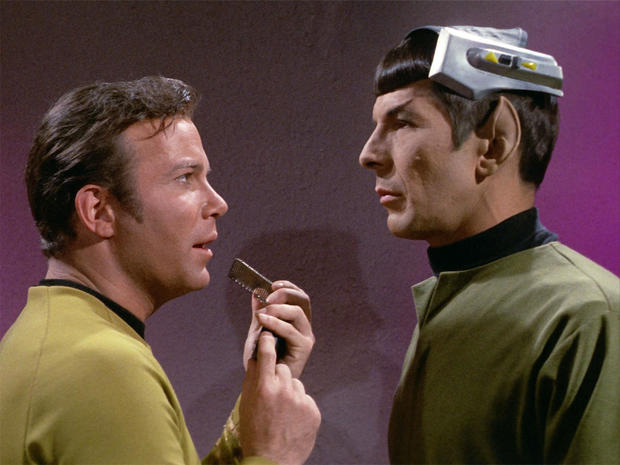
“Spock’s Brain”
First aired: September 20, 1968
“Star Trek” was cancelled after two seasons, but a letter-writing campaign by passionate fans helped persuade NBC to bring it back. The gratification of the cast at having their jobs again must have been met with downcast expressions once they read the script for this third season episode, in which a pretty female alien beams aboard the Enterprise and steals the brain out of Spock’s head. Why? To run her planet’s infrastructure, naturally. After retrieving the errant organ, and with the body of Spock offering guidance, Dr. McCoy performs a “reverse brain transplant,” and all is well. The worst “Trek” episode of all time.
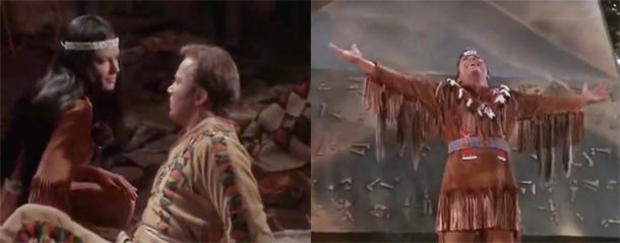
“The Paradise Syndrome”
First aired: October 4, 1968
Yet another “alien planet mimics Earth’s past” episode, this time featuring a civilization which resembles Native American tribes, except for that strange metallic obelisk. Kirk is “kidnapped” by the obelisk, suffering amnesia and waking up as “Kirok,” whose strange space-man ways lead him to be accepted as the tribe’s medicine man. And while he may have forgotten who he is, Kirok is still Kirk, getting a comely native girl pregnant. Meanwhile, an asteroid is about to destroy the entire planet. Will Kirk get his memory back in time to save everyone?
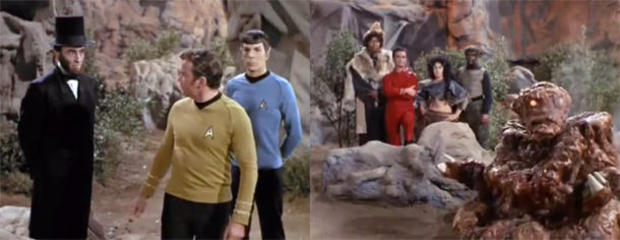
“The Savage Curtain”
First aired: March 7, 1969
“Star Trek” would often tie figures from Earth’s past to characters of the future (one list of history’s failed despots included Alexander, Caesar, Napoleon, Hitler and “Krotus”). “The Savage Curtain” takes this one step further, by bringing to life our greatest president, Abraham Lincoln, and Surak, “the father of Vulcan civilization,” to join Kirk and Spock in a cage match to the death against exemplars of evil: Genghis Khan, 21st century Earth warlord Colonel Green, the Klingon Kahless, and Zora, a woman not to be trusted. The talking rock that officiates the experiment in good vs. evil figures the better philosophy will vanquish their rivals, but ultimately the bad guys just quit and run away. Boooo!

“Turnabout Intruder”
First aired: June 3, 1969
The last new episode of the Original Series, alas, saw the show off on a down note, and a surprisingly anti-feminist one at that. An old flame of Kirk’s, Dr. Janice Lester (Sandra Smith), believing that being a woman has kept her from breaking the glass ceiling of starship command, goes bonkers and decides to steal Kirk’s body and take over the Enterprise. As her mind is transferred to Kirk’s body, his mind enters hers. Fortunately a Vulcan mind meld contradicts the old saw that men can never understand what’s on a woman’s mind, when Spock discovers his captain inside Lester’s head.
Star Trek: The Original Series
- View history
Star Trek: The Original Series (referred to as Star Trek prior to any spin-offs) is the first Star Trek series. The first episode of the show aired on 6 September 1966 on CTV in Canada, followed by a 8 September 1966 airing on NBC in America. The show was created by Gene Roddenberry as a " Wagon Train to the Stars". Star Trek was set in the 23rd century and featured the voyages of the starship USS Enterprise under Captain James T. Kirk .
Star Trek was later informally dubbed The Original Series , or TOS, after several spin-offs aired. The show lasted three seasons until canceled in 1969 . When the show first aired on TV, and until lowering budget issues in its third season resulted in a noticable drop in quality episodes and placed in a 10 pm Friday night death slot by the network, Star Trek regularly performed respectably in its time slot. After it was canceled and went into syndication , however, its popularity exploded. It featured themes such as a Utopian society and racial equality, and the first African-American officer in a recurring role.
Ten years later, Star Trek: The Motion Picture reunited the cast on the big screen aboard a refurbished USS Enterprise . They appeared in five subsequent films, ending with Star Trek VI: The Undiscovered Country in 1991, during production of the spin-off series Star Trek: The Next Generation and shortly before Gene Roddenberry's death. Several original series characters also appeared in the seventh movie, Star Trek Generations , and in other Star Trek productions.
- 1 Opening credits
- 2.1 Starring
- 2.2 Also starring
- 3 Production crew
- 4.1 First pilot
- 4.2 Season 1
- 4.3 Season 2
- 4.4 Season 3
- 5.1 Concept
- 5.2 The first pilot
- 5.3 The second pilot
- 5.4 The series begins
- 5.5 The first season
- 5.6 Syndication
- 5.7 Reception
- 5.8 Remastered
- 6 Related topics
- 8 External links
Opening credits [ ]
- Main Title Theme (Season 1) file info (composed by Alexander Courage )
- Main Title Theme (Season 2-3) file info (composed by Alexander Courage )
Main cast [ ]
Starring [ ].
- William Shatner as Captain Kirk
Also starring [ ]
- Leonard Nimoy as Mr. Spock
- DeForest Kelley as Dr. McCoy ( 1967 - 1969 ; co-star 1966 - 1967 )
In addition, the following regulars were listed in the end credits as co-stars:
- James Doohan as Scotty
- Nichelle Nichols as Uhura
- George Takei as Sulu
- Walter Koenig as Chekov ( 1967 - 1969 )
- Majel Barrett-Roddenberry as Christine Chapel
- Grace Lee Whitney as Janice Rand
Production crew [ ]
- Gene Roddenberry – Creator, Writer, Producer, Executive Producer
- Gene L. Coon – Writer, Producer
- John Meredyth Lucas – Writer, Producer, Director
- Fred Freiberger – Producer (1968-69)
- Robert H. Justman – Associate Producer (Season 1-2), Co-Producer (Season 3), First Assistant Director (two pilots)
- D.C. Fontana – Writer, Script Consultant (1967-68)
- Steven W. Carabatsos – Writer, Story Consultant (1966)
- John D.F. Black – Associate Producer, Writer, Story Editor (1966)
- Arthur H. Singer – Story Consultant (1968-69)
- Byron Haskin – Associate Producer (first pilot)
- Walter "Matt" Jefferies – Production Designer, Art Director
- William E. Snyder – Director of Photography (first pilot)
- Ernest Haller – Director of Photography (second pilot)
- Jerry Finnerman – Director of Photography (61 episodes, 1966-1968)
- Keith Smith – Director of Photography (1 episode, 1967)
- Al Francis – Director of Photography (16 episodes, 1968-1969), Camera Operator (61 episodes, 1966-1968)
- Jim Rugg – Supervisor of Special Effects
- Rolland M. Brooks – Art Director (34 episodes, 1965-1967)
- Fred B. Phillips – Make-up Artist
- Robert Dawn – Make-up Artist (second pilot)
- William Ware Theiss – Costume Designer
- Gregg Peters – First Assistant Director (Season 1), Unit Production Manager (Season 2-3), Associate Producer (Season 3)
- Claude Binyon, Jr. – Assistant Director (third season)
Episode list [ ]
- List of TOS episodes by airdate
- List of TOS remastered episodes by airdate
First pilot [ ]
Season 1 [ ].
TOS Season 1 , 29 episodes:
Season 2 [ ]
TOS Season 2 , 26 episodes:
Season 3 [ ]
TOS Season 3 , 24 episodes:
Behind the scenes [ ]
Concept [ ].
Star Trek was created by Gene Roddenberry, whose interest in science fiction dated back to the 1940s when he came into contact with Astounding Stories . Roddenberry's first produced science fiction story was The Secret Weapon of 117 , which aired in 1956 on the Chevron Theatre anthology show. By 1963 Roddenberry was producing his first television series, The Lieutenant , at MGM .
In 1963, MGM was of the opinion that "true-to-life" television dramas were becoming less popular and an action-adventure show would be more profitable (this prediction turned out to be right, and led to series such as The Man from U.N.C.L.E ). Roddenberry had already been working on a science fiction concept called Star Trek since 1960 , and when he told MGM about his ideas, they were willing to take a look at them. As the production of The Lieutenant came to an end, Roddenberry delivered his first Star Trek draft to MGM. The studio was, however, not enthusiastic about the concept, and a series was never produced.
Roddenberry tried to sell his " wagon train to the stars " format to several production studios afterward, but to no avail. In 1964 , it was rumored that Desilu was interested in buying a new television series. Desilu was a much smaller company than MGM, but Roddenberry took his chances, greatly aided with the help of Desilu Executive Herb Solow . This led to a three-year deal with Desilu in April 1964 .
The first attempt to sell the Star Trek format to broadcasting network CBS (Desilu had a first proposal deal with the network) failed. CBS chose another science fiction project, Irwin Allen 's more family-oriented Lost in Space instead of Roddenberry's more cerebral approach. But in May 1964 , NBC 's Vice-President of Programming Mort Werner agreed to give Roddenberry the chance to write three story outlines, one of which NBC would select to turn into a pilot.
One of the submitted story lines, dated 29 June 1964 , was an outline for " The Cage ", and this was the story picked up by NBC. Now, the daunting task that Roddenberry and his crew faced was to develop the Star Trek universe from scratch. Roddenberry recruited many people around him to help think up his version of the future. The RAND Corporation's Harvey P. Lynn acted as a scientific consultant, Pato Guzman was hired as art director, with Matt Jefferies as an assisting production designer. This phase of creativity and brainstorming lasted throughout the summer, until in the last week of September 1964 the final draft of the "The Cage" script was delivered to NBC, after which shooting of the pilot was approved.
The first pilot [ ]
In early October, preparations for shooting "The Cage" began. A few changes in the production crew were made: Roddenberry hired Morris Chapnick , who had worked with him on The Lieutenant , as his assistant. Pato Guzman left to return to Chile and was replaced by Franz Bachelin . Matt Jefferies finalized the design for the Enterprise and various props and interiors. By November 1964 , the sets were ready to be constructed on stages Culver Studios Stage 14 , 15 , and 16 . Roddenberry was not happy with the stages, since they had uneven floors and were not soundproof, as Culver Studios had been established in the silent movie era when soundproofing had not been an issue to consider. Eventually, in 1966 , the rest of the series was shot on Paramount stages 9 and 10 , which were in better shape.
Casting of the characters was not a problem, apart from the lead role of Captain Pike (still known as "Captain April " at this point, later renamed "Captain Winter" before finally choosing "Pike") who Roddenberry convinced Jeffrey Hunter to play. Leonard Nimoy ( Spock ) had worked with Roddenberry on The Lieutenant . Majel Barrett , also a familiar face from The Lieutenant , got the part of the ship's female first officer, Number One . Veteran character actor John Hoyt , who had worked on many science fiction and fantasy projects before, was chosen to play the role of Doctor Phil Boyce . Young Peter Duryea and Laurel Goodwin were hired as José Tyler and Yeoman J.M. Colt , respectively. The extras were cast from a diversity of ethnic groups, which was significant because integration was not a usual occurrence in 1960s television, and segregation was still a reality in the United States.
To produce the pilot episode, Robert H. Justman was hired as assistant director; he had worked on The Outer Limits shortly before. Makeup artist Fred Phillips was brought in as well, whose first job it was to create Spock's ears. Another veteran from The Outer Limits was producer-director Byron Haskin , who joined as associate producer. On 27 November 1964 , the first scenes of "The Cage" (or "The Menagerie," as it was briefly known), were shot. Filming was scheduled to be eleven days, however the production went highly over budget and over schedule, resulting in sixteen shooting days and US$164,248 plus expenses.
But there were still a lot of visual effects to be made. An eleven-foot filming model of the USS Enterprise , designed by Matt Jefferies, was built by Richard Datin , Mel Keys , and Vern Sion in Volmer Jensen 's model shop , and was delivered to the Howard Anderson Company on 29 December 1964 .
In February 1965 , the final version of "The Cage" was delivered at NBC and screened in New York City. NBC officials liked the first pilot. Desilu's Herb Solow says that NBC was surprised by how realistic it looked, and that it was "the most fantastic thing we've ever seen." The reason the pilot was rejected was because it was believed that it would attract only a small audience, and they wanted more action and adventure. They also had problems with the "satanic" Spock and the female first officer (Number One). However, NBC was convinced that Star Trek could be made into a television series, and that NBC itself had been at fault for choosing the "The Cage" script from the original three stories pitched. Also, after spending US$630,000 on "The Cage" (the most expensive TV pilot at the time), they didn't want to have their money wasted. NBC then made the unprecedented move to order a second pilot.
The second pilot [ ]
For the second pilot, NBC requested three story outlines again. These were " Where No Man Has Gone Before " by Samuel A. Peeples , and " Mudd's Women " and " The Omega Glory " by Roddenberry. Although it was the most expensive of the three, NBC chose " Where No Man Has Gone Before ", as it had the most action and most outer space spectacle. However, the other two premises were also made into episodes of the series later.
Filming the second pilot began in July 1965 , and took nine days to complete. The entire cast of " The Cage " was replaced except Spock. Jeffrey Hunter chose not to reprise his role as Captain Pike, mostly by the advice of his wife, who felt that "science fiction ruins her husband's career". Roddenberry wanted both Lloyd Bridges and Jack Lord for the role of the new captain, however both declined. Finally William Shatner , who had previous science fiction experience acting in episodes of The Twilight Zone and The Outer Limits , was chosen. The new captain was named James R. Kirk (later renamed James T. Kirk).
For the role of the chief medical officer, Roddenberry chose veteran actor Paul Fix . Canadian actor James Doohan got the role of chief engineer Scott , and young Japanese-American George Takei was featured as ship's physicist Sulu . The latter two reprised their roles in the upcoming series, though Sulu was a helmsman in the series. Other actors considered for being regulars were Lloyd Haynes as communications officer Alden and Andrea Dromm as Yeoman Smith , but neither of them were re-hired after the pilot.
Many of the production staff were replaced. Robert Dawn served as head make-up artist, however Fred Phillips returned to the position in the series itself. Academy Award winner cinematographer Ernest Haller came out of semi-retirement to work as the director of photography. Associate producer Byron Haskin was replaced by Robert H. Justman , who now shared double duties as producer and assistant director.
The Enterprise model was updated for the second pilot, and many new outer space effects shots were made, most of which were reused in the series itself. The sets were also updated a bit, most notably the main bridge and the transporter room. Most of the uniforms, props, and sets were reused from " The Cage ", however some new props (including the never-seen-again phaser rifle ) and a brand new matte painting (the planet Delta Vega ) were made specially for this episode.
" Where No Man Has Gone Before " was accepted by NBC and the first season of a regular series was ordered for broadcasting in the 1966-67 television season. History was made.
The series begins [ ]
Preparation for the first regular season began in early 1966 . All the Enterprise interior sets were updated, as well as the introduction of brand new uniforms. The look of the show became more colorful and more vivid. The Enterprise model was also updated once more. Also, the entire production was moved from Desilu's Culver City studios to the main Gower Street studio's Stage 9 and 10 ( Paramount Stage 31 and 32 from 1967 onward) in Hollywood.
Kirk (Shatner) and Spock (Nimoy) were kept as the series stars, with Grace Lee Whitney joining the two as Yeoman Janice Rand (replacing Andrea Dromm as Yeoman Smith). Whitney had worked with Roddenberry a year before on an unsold pilot titled Police Story . Publicity photos promoting the new series were made at this time, with the three of them, mostly using props left from the two pilots (most notably the aforementioned phaser rifle). Shatner and Nimoy wore their new uniforms on these photographs, while Whitney had to wear an old, pilot version.
Scott (Doohan) and Sulu (Takei) were also kept, the latter becoming the ship's helmsman instead of physicist. Two additions made the Enterprise main crew complete: DeForest Kelley was hired to play the new chief medical officer, Leonard McCoy , as Roddenberry had known him from previous projects, including the aforementioned Police Story . Actress Nichelle Nichols got the role of communications officer Uhura , who became a symbol of the racial and gender diversity of the show. Nichols was a last minute addition, weeks before filming began on the first regular episode.
Jerry Finnerman became the new director of photography, while Fred Phillips, Matt Jefferies, and Rolland M. Brooks returned to their former positions. Writer John D.F. Black was brought in as the second associate producer (next to Justman). While Roddenberry and Black handled the script and story issues, Justman was in charge of the physical aspects of production.
Filming of the first regular episode, " The Corbomite Maneuver " began on 24 May 1966 . Finally Star Trek debuted on NBC with a "Sneak Preview" episode at 8:30 pm (EST) on 8 September 1966 . NBC chose " The Man Trap " (the fifth episode in production order) to air first, mainly because they felt it was more of a "traditional monster story" and featured more action.
The first season [ ]
In August 1966 , several changes were made in the Star Trek production staff. Roddenberry stepped down as line producer and became the executive producer. His replacement was Gene L. Coon , who also regularly contributed to the series as a writer. While Black had also left the series, story editor Steven W. Carabatsos came in, sharing story duties with Roddenberry and Coon. To handle post-production, Edward K. Milkis was brought in by Justman. Carabatsos had left Star Trek near the end of the season, and was replaced by D.C. Fontana , formerly Roddenberry's secretary and a writer for the series.
Syndication [ ]
- See : Syndication
Due to the overall length of the episodes of The Original Series , several minutes of each episode are frequently cut during the show's reruns, notably on the Sci-Fi Channel . Starting in April 2006 , the G4 network began airing the full length episodes in "Uncut Marathons" on Saturdays. G4 stopped airing these full-length versions in November 2006, and has discontinued its run of Star Trek 2.0 , which was a trivia-oriented and interactive version of the show for the viewers.
For current airings see Where to watch .
Reception [ ]
The Original Series has been nominated for and won a number of awards over the years. Some of the awards include:
- The series was nominated for thirteen Emmy Awards during its run, but did not win any.
- It was nominated eight times for the "Best Dramatic Presentation" Hugo Award , sweeping the nominees in 1968. It won twice, and Roddenberry won a special award in 1968.
- The 2003 "Pop Culture Award" in the TV Land Awards .
- The 2005 Saturn Award for "Best DVD Retro Television Release."
Aaron Harberts and James Frain cited TOS as their favorite Star Trek series. ( AT : " O Discovery, Where Art Thou? ")
Remastered [ ]
On 31 August 2006 , CBS Paramount Television announced that, in celebration of the 40th anniversary of Star Trek , the show would return to broadcast syndication for the first time in sixteen years. The series' 79 episodes were digitally remastered with all new visual effects and music. The refurbished episodes have been converted from the original film to high-definition video, making it on par with modern television formats.
Related topics [ ]
- TOS directors
- TOS performers
- TOS recurring characters
- TOS writers
- Character crossover appearances
- Undeveloped TOS episodes
- Desilu Stage 9
- Desilu Stage 10
- Star Trek Writers/Directors Guide
- Star Trek: The Original Series novels
- Star Trek: The Original Series comics (DC)
- Star Trek: The Original Series comics (IDW)
- Star Trek: The Original Series soundtracks
- Star Trek: The Original Series on VHS
- Star Trek: The Original Series on Betamax
- Star Trek: The Original Series on CED
- Star Trek: The Original Series on LaserDisc
- Star Trek: The Original Series on DVD
- Star Trek: The Original Series on Blu-ray
External links [ ]
- Star Trek: The Original Series at Wikipedia
- Star Trek: The Original Series at Memory Beta , the wiki for licensed Star Trek works
- Star Trek: The Original Series at StarTrek.com
- Star Trek: The Original Series at the Internet Movie Database
- Star Trek: The Original Series at the Movie and TV Wiki
- Public Radio Special: The Peace Message in Star Trek
The 21 Best Star Trek Original Series Episodes, Ranked
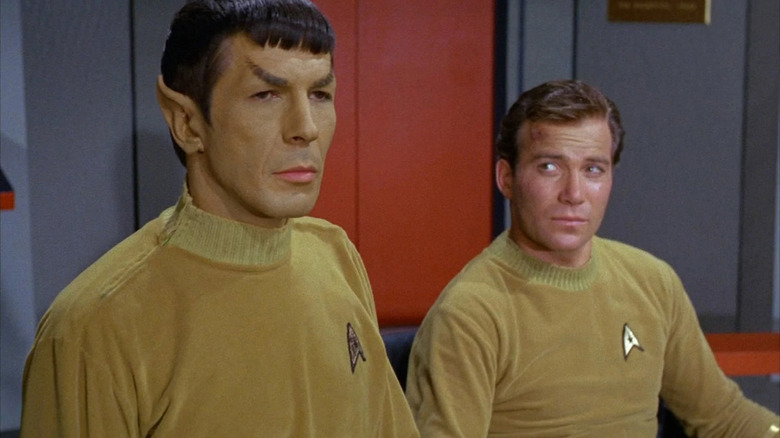
"You know. 1966? 79 episodes, about 30 good ones," said Philip J. Fry of "Futurama" to the jarred, floating head of Leonard Nimoy. This is his animated opinion, of course, but a better question isn't how many are good, but how many of the original "Star Trek" episodes are great. Would you believe 21?
Determining greatness is subjective of course. Popularity isn't a fair indicator of quality, and some fan favorites are guilty pleasures, while others are fun but defective in ways that knock them down from great to merely good. Any episode's overall quality depends on multiple factors: the uniqueness of the premise, the quality of the writing, the story beats, the characterization, guest stars, action, music, production values, and even visual effects.
Speaking of visual effects, we're not talking about the 15-year-old "remastered" CGI, which already look dated and cartoonish. We're going O.G. all the way. The criteria here is ranking these as the total package rather than the sum of their parts. With that in mind, here's a perhaps controversial list of the 21 greatest "Star Trek: The Original Series" episodes.
21. A Piece of the Action (Season 2, Episode 17)
Although humorous moments abound throughout the original "Star Trek," there aren't many outright comedy episodes. In fact, there are only three: "I Mudd," "A Piece of the Action," and "The Trouble with Tribbles." Most fans I know vote the straight "Tribbles" ticket, but that episode is merely cute-funny, whereas the over-the-top "A Piece of the Action," is actually genuinely funny. The script by Gene L. Coon is more absurd than "Tribbles" and features more comic business. The cherry on top was its helmer, James Komac, who was a gifted comedy writer and director of hundreds of episodes of shows including "Welcome Back, Kotter" and "Chico and the Man" (which he created).
This episode is almost a meta-commentary and spoof on the "Star Trek" schtick of "strange new worlds" which end up being monocultures thinly based on Earth's history. Here we see why the Prime Directive exists: an entire civilization has modeled itself on the popular mythos of Roaring '20s Chicago mobs. It's literally Planet Cosplay, and an unintentional spoof of fandoms then and now. Two things keep it at this end of the list: it's shamelessly riffing on "Robin and the 7 Hoods" (1964), and it's almost irredeemably dumb. Fortunately, it's dumb fun, and fun enough to be among the best. "Right?" "Riiiiight."
20. Space Seed (Season 1, Episode 22)
You might be surprised that this comes in so low in a list of greats, but that it merits inclusion at all relies solely on the sheer screen presence and magnetism of its guest star. Khan Noonien Singh is an arrogant egotist and tyrant, but Ricardo Montalbán's confident performance makes him watchable. Minus him, the story defects would relegate this episode to merely "good." Many put this in their top 10, but I suspect that's because it basks in the reflected glow of its cinematic follow-up "The Wrath of Khan."
The script is serviceable but unmemorable and commits the sin of making our heroes foolish instead of making Khan's intelligence and cunning the real danger. Kirk hands this unknown and suspicious character unfettered access to the ship's technical library on a silver platter, and historian Marla McGivers is a pushover who betrays all her shipmates because she's a fangirl of brutish dictators.
Weak story aside, the episode does have strengths. All the performances are good, and the story moves along at a brisk pace. There's memorable dialog, and McCoy really shines when he isn't cowed by Khan holding a scalpel to his neck. There's also some of the best miniature effects work on the show, going to the expense of a custom-made model of the Botany Bay . Montalbán is what makes it a best episode at all, but he alone can't elevate it.
19. The Conscience of the King (Season 1, Episode 13)
This least "Star Trek"-y of "Treks" scores points for being just that. The series premise allows it to be a semi-anthology, able to shift genres without breaking format, so one week it's a psychological drama about the duality of human nature, another time it's about cold war proxies, or planet-killing doomsday machines by way of "Moby Dick," or — as in this case — a Shakespearean tragedy about mercy and revenge. Just As Hamlet must determine whether or not his uncle Claudius murdered his father, so must Captain Kirk determine if actor Anton Karidian is the man once known as Kodos the Executioner.
Writer Barry Trivers cleverly frames his story within the play that informs it, a bit of dramaturgical license that permits a more theatrical approach. Take, for example, this bit of dialogue from Lenore Karidian: "There's a stain of cruelty on your shining armor, Captain. You could have spared him, and me. You talked of using tools. I was a tool, wasn't l? A tool to use against my father."
This episode exemplifies a shadowy aspect of Kirk's affairs rarely discussed in how he weaponizes romance to get what he wants. The ultimate irony is that he plays Karidian's daughter Lenore in order to get close to her father only to learn that she's been playing him. That it's so different is a double-edged blade that simultaneously makes it a best episode, but nowhere near the top. It was a great stretch for the show.
18. The Immunity Syndrome (Season 2, Episode 18)
This one barely edges out the not-dissimilar and more popular "The Doomsday Machine." Both feature the crew of a sister ship annihilated by a huge alien thing endangering life throughout the galaxy. But where "Doomsday" is a straightforward adventure story driven by an Ahab-like guest star, "Immunity" is more personal, as it features some great and properly motivated Spock and McCoy conflict.
Too often Bones would goad Spock for no reason, but here their back and forth is professional: two scientists vying for an opportunity to study this alien organism, each feels himself the most qualified to take on what promises to be a suicide mission, and each, perhaps, choosing to make the sacrifice rather than let the other die. But it's Kirk who has to make the final, heartbreaking choice of which of his friends to send. That's classic "Trek."
Given its budget and the visual effects tech of the time, "Star Trek" was rarely able to get across truly alien life forms, but this is a notable exception, and the conceit that the Enterprise must enter the alien entity as a virus infects a cell is a nice twist. The visual effects of the space amoeba thing are fabulous and weird, something the 2007 remastered CGI does not improve on.
17. Day of the Dove (Season 3, Episode 7)
The third season has no classic episodes, but a few come close. "Day of the Dove" is the best of the bunch. The simple premise of exploiting bigotry between our heroes and their cold-war counterparts, the Klingons, works better than it ought. If you want to look for a message, the alien entity that fuels the very hatred and violence it feeds upon can be read as a stand-in for the military-industrial complex, which fans the flames of conflict in order to sell weapons in a perpetual feedback loop. Alternatively, you can just take it for a MacGuffin.
The nefarious influence of the alien entity memorably amplifies the slightest biases of the Enterprise crew, and it's uncomfortable to hear blatant racism coming of out our noble heroes' mouths, especially Scotty's attack on Spock. Michael Ansara plays Kang as no mere mustache-twirling bad guy, but as a shrewd enemy starship commander, an honorable warrior, and a fine opposite to Kirk. By turns personable, calculating, and violent, he's a model Original Series Klingon. Frankly, I'd rather watch him than Khan; your mileage may vary. It's got action. It's got character conflict for days. It's the best the third season has to offer, but it's not as great as the first and second-season entries coming up.
16. Tomorrow Is Yesterday (Season 1, Episode 19)
The original "Star Trek" didn't play with time travel much, and when it did the results were either very good or they were horrid, with the backdoor pilot "Assignment: Earth" being the low point. "Tomorrow Is Yesterday" features the most offbeat teaser of the series, following an Air Force F-104 interceptor, with the visual punchline that the bogie it's after is the USS Enterprise.
What follows is illogical as all get out, but the gimmick of the Enterprise being tracked as a UFO and having to undo the temporal damage it's done by being photographed and accidentally crushing that Air Force interceptor is great and the story milks it for all it's worth. No real depth here, but the fun is all in the plot events and reactions of the crew.
There's some great in-character stuff in the episode, including Spock's statement that he too doesn't believe in "little green men," and his one-star ranking of the Air Force film of the Enterprise as "bad photography." Kirk's playfully resigned responses to his Air Force interrogator are great, too. And, hey, Sulu even gets to get off the bridge. The main weakness is the "how does that work?" ending gimmick of beaming people back into their own bodies. Great, but not a classic.
15. Balance of Terror (Season 1, Episode 14)
A fan favorite for good reason, the episode depicts the loneliness of command as Kirk tries to seek and destroy a marauding alien vessel without triggering an outright war. Seeing some of the "lower decks" types makes the Enterprise feel more real and lived in and sells that Kirk's every decision has repercussions beyond the bridge. But it's Mark Lenard's perfectly pitched turn as the unnamed Romulan commander that's most memorable here. Torn over the ramifications of the performance of his duty, he's Kirk's equal in every way, and you can believe that he loses this battle not by dint of any personal failings but merely because his ship is outmatched by the much quicker and faster-firing Enterprise.
For 1966 the effects are great and largely still hold up. The Romulan ship is simple and distinctive, and the music is spot on. The main thing keeping it out of the top 10 is that it so baldly swipes elements of the films "Run Silent Run Deep" and "The Enemy Below," slapping pointed ears on the German Kriegsmarine story from the latter film, borrowing its war-weary commander and a subordinate fanatically loyal to their political leader. In "Arena," the show paid for the rights of the story it was cribbed from and credited the author. No such screen credit graces this obvious lift.
14. The Ultimate Computer (Season 2, Episode 24)
Kirk's infamous for offing overzealous computers (see: Landru in "Return of the Archons," Nomad in "The Changeling," and the androids of "I Mudd"), but his personal best computer kill is in "The Ultimate Computer." Here he doesn't merely meltdown the M5 Multitronic unit by confronting its flawed logic regarding its purpose; he aims a precise surgical strike at the chink he spots in its programming armor: appealing to the morality inherent in the memory engrams its all too human creator imprinted it with, causing it to reason it must die to pay for the sin of murder.
This episode is character-driven, with Kirk confronting his own redundancy and possible irrelevancy even as Spock and McCoy make their loyalty and friendship clear. Guest star William Marshall's turn as the deranged Dr. Daystrom is a standout, ranking among the best of the show.
All this drama is supported by some fine action, as M5 reduces a redshirt to a puff of smoke, photon torpedoes a robot ship, and then nearly destroys four sister ships of the Enterprise, actually killing the entire crew of one. Even the light ending — which often play as callous given the events which precede them in many episodes — is acceptable here because it's about Spock and McCoy, not Kirk. But it's still Kirk vs. the Computer, and those are never "Star Trek" at the very top of their game.
13. The Cage (Original Pilot)
Forget "The Menagerie" with its paper-thin envelope around the first pilot, repetitive courtroom scenes, and forced cliffhangers, all of which render it a solid but not great installment. But on its own "The Cage" is not just a great launchpad for what "Star Trek" is and would become, but an imaginative and well-executed story in its own right. Gene Roddenberry's script is smart, with the atrophied Talosian aliens a satirical stand-in for TV audiences who might rather live other people's fantasies than experience adventures of their own. While it's a bit talky and static in places, when they're in action it's great stuff — notably the laser cannon scene and Pike's illusory fight on Rigel VII.
Visually it's terrific. This was the most expensive episode ever made , and it shows. The sets, costumes, makeups, and many special effects are top-notch for a show of the era particularly the matte shot of the Rigel VII fortress. The pacing's a bit loose, the characters don't pop due to the largely meh casting, and "THE WOMEN!" Number One and Yeoman Colt secretly wanting to bone the Captain is cringeworthy. However, guest star Susan Oliver's performance is the standout here, followed by Leonard Nimoy as Spock. Ultimately, it's just as well that the far more energetic William Shatner stepped in to replace Jeffrey Hunter's less-than-charismatic version of Captain Pike .
12. Arena (Season 1, Episode 18)
If any episode of "Star Trek" is truly iconic, this is it. The action set piece on Cestus III is the biggest of any in the series, with running and jumping and explosions galore, a redshirt vaporization, a detonating tricorder, and a photon torpedo-sque mortar. Once back on the Enterprise, Kirk's dogged determination to overtake and destroy the enemy ship demonstrates the obsessive nature of his character, but communication with his alien foe plants a seed of doubt which ultimately empowers him to practice what he preached in "A Taste of Armageddon: " We're human beings with the blood of a million savage years on our hands, but we can stop it. We can admit that we're killers, but we're not going to kill today. That's all it takes. Knowing that we won't kill today."
Kirk doesn't kill, and it saves the day. It lands here amongst the best because the story ends with the overused first-season gimmick of the godlike entity — the others being Gary Mitchell, Charlie-X Evans and his Thasian truant officers, Trelane the god-child, and the Organians — but the Metrons are more a plot device than anything. The Gorn is a great and worthy adversary, even as its slow-motion gestures are laughable. Spock hanging a lantern on Kirk's cannon-building is a bit much, but hey, he's the costar and has to do something.
11. Where No Man Has Gone Before (Season 1, Episode 3)
This might be a surprise but despite the second pilot weirdness of different uniforms, series crew regulars appearing not at all (McCoy, Uhura) or in different jobs (Sulu is an astrophysicist), and Spock's not-quite-there characterization and more severe makeup, the core "Star Trek"-ness is there in spades. Kirk makes a risky decision in the first act and must deal with the building consequences for the balance of the show, finally shouldering personal responsibility for his decision in the worst way possible: in order to save his ship and crew, he's forced to kill a subordinate shipmate and friend.
The episode looks great (being far more expensive than any regular production episode), repurposes the planet set built for the even more expensive first pilot, and features more optical effects than would be the norm for a production episode. Most importantly, William Shatner's Kirk projects leading-man charisma of the sort that's arguably what sold the show. It also delivers on Gene Roddenberry's original high-concept pitch of a "Wagon Train to the stars" where stories would focus on strong guest stars interacting with the recurring cast. The script is not without its flaws, and had Gary Mitchell been a tad more likable the drama would have played even better. Still, two thumbs way up.
10. A Taste of Armageddon (Season 1, Episode 23)
"New civilizations" planet stories rarely yielded great episodes, often setting up straw man civilizations for Kirk to knock down, but this one bucks the trend with a story smart enough to rank among the best. Kirk vs. the Computer legendarily has Kirk talk the machine to death, but now and again he goes for the direct approach. Here the computers coldly run simulations and select innocents to die, and Kirk has zero compunction about blasting them, finally forcing the two civilizations to finally attempt to negotiate peace after 500 years of a "war" where death has been made so neat and tidy they see it as a necessary evil rather than something to stop.
Goodies include Scotty's head-butting with Ambassador Fox, Kirk's arguments about war with Anan 7, and Kirk threatening to have the Enterprise rain destruction down on a planet that's not faced a real attack in centuries. The moral? Any war held at arm's length is mere statistics, something the American people had grown accustomed to until television thrust the reality of Vietnam into their living rooms each evening. That's a lesson we must learn over and over again in conflicts where we increasingly use long-range and smart weapons to strike people we never even see. It's a message as relevant today as when it was first aired.
9. The Corbomite Maneuver (Season 1, Episode 10)
Effectively the "third pilot" of "Star Trek," this was the first regular production episode to go before the cameras and it had the luxury of a rehearsal day, a solid director, and a fine script. It even ends with a quintessential "Trek" twist: our implacable foe ends up being an erstwhile friend. By rights, this should've been the first episode to air as it sets up the whole show, but it was nowhere near ready at the premiere , in part due to the sheer number of optical effects in post-production. Dr. McCoy is wonderful from his first appearance, and his camaraderie and professional conflict with Kirk set the stage for their entire relationship.
The weird flagship Fesarius is pure alien goodness, and the Balok puppet is iconic. Memorable business includes Sulu's countdown, Spock's logic and resulting lack of imagination, Scotty's comment about Spock's parents, and McCoy and Kirk's conflict over Bailey. A highlight is the briefing room scene, with its lived-in atmosphere with piles of tapes and empty cups of coffee showing instead of telling us how hard the crew has been working on their predicament. Likewise, the Enterprise feels like a real lived-in ship, with corridors bustling with the crew, something the show would lose as fixed costs increased and studio budgets didn't grow to match . It's one of the 10 best, held back only because it drags in some spots.
8. The Galileo Seven (Season 1, Episode 16)
Albeit loosely inspired by the survivor drama "Five Came Back" (1939), this episode charts its own course as Spock tries and fails to resolve a potentially lethal situation with logic alone. It's rare that adventure shows of the time would depict a lead character failing, but that's just what "The Galileo Seven" does.
As in "The Corbomite Maneuver," we are again shown that Spock's logic can serve as blinders that prevent him from seeing all the possibilities even as he tells Scott "there are always alternatives." As such, he expects the giant natives to react rationally to a show of force and brings them right down on the party. He's likewise ill-equipped to deal with the emotional frailties of the crew under his command, especially the insolent and insubordinate Lt. Boma, memorably played by Don Marshall, later of "Land of the Giants."
The B-story with Kirk desperately trying to locate the lost shuttle against a ticking clock demonstrates the sorts of no-win scenarios a ship captain must face. The production scores visually for the full-size shuttlecraft, as well as the visual effects depicting it and its sister crafts' departure and return to the Enterprise hangar deck.
7. The Naked Time (Season 1, Episode 4)
The fourth episode aired, "The Naked Time" is the foundational character-building segment of the series, peeling away the surface of Kirk and Spock and revealing a bit of what makes them tick. It's also entertaining as hell, with a slow burn as the crew is at first blissfully ignorant of the inhibition-inhibiting compound brought aboard and then having to deal with the resulting chaos. Sulu's descent into madness is charming, and George Takei was always at his most charismatic when he got to play unhinged. Sadly, neither Uhura nor Rand's secret selves get explored, and poor Chapel's reduced to pining for Spock as her primary character trait for most of the series.
The only weak spot here is that the "science" part of science fiction went out of the airlock. A collapsing planet is as preposterous an idea as the notion that the Enterprise is forced to constantly alter its orbit to study it. But guest crewman Kevin Riley is fun and Scotty gets two great lines here, the first being "I can't change the laws of physics," and the second an example of technobabble that's simple and audience-friendly: "You can't mix matter and antimatter cold!"
6. The Devil in the Dark (Season 1, Episode 25)
The episode is unique for being the only one to open with no sign of the Enterprise or her crew. Effectively a redo of series opener "The Man Trap," this episode succeeds where its predecessor fails not merely because the crew act more rationally but because a narrative twist turns the titular "Devil" into a sympathetic character. The Kirk-Spock dynamic is on fine display here as Spock first wishes to capture the creature alive and Kirk wants it dead, but Spock's feelings for his captain override his desire for scientific knowledge the instant he believes Kirk is in danger.
Spock urges his captain to "Kill it!" even as Kirk susses out that the creature may be more than a monster. This is the first instance of Spock mind-melding with a wholly alien life form, a gimmick which would be taken to preposterous extremes in "Star Trek: The Motion Picture." Leonard Nimoy's "pain!" emoting is a bit over the top even for the time and keeps the episode out of the top five. Otherwise, he and William Shatner display the chemistry that made the show work even when the scripts let them down. This script does not let them down.
5. Journey to Babel (Season 2, Episode 10)
This world-building episode fires on all cylinders and never misses a beat. If writers then or now needed a model for how to write "Star Trek," this is it, and it's hands down the best episode penned by Dorothy "D.C." Fontana. There's a story conflict as the Enterprise ferries quarrelsome ambassadors and their aides to the titular "Babel" conference over a matter of Federation business. There's an interpersonal conflict between not just Spock and his parents but also between Spock and Kirk and Bones over relinquishing command.
There's physical conflict as ambassadors brawl, one is murdered, and Kirk is ambushed and wounded. We meet lots of aliens, see a bit of galactic politics, and get a nail-biter of a finish as McCoy tries to perform delicate surgery while Kirk struggles to keep it together amidst attacks by a seemingly unstoppable, unknown ship.
Mark Lenard returns not as a Romulan but as Spock's Vulcan father, Ambassador Sarek, who picks up on Leonard Nimoy's Vulcan portrayal and crafts one uniquely his own. Memorable too is Reggie Nalder, whose burn-scarred face and Austrian accent accentuate his alienness in the role of the blue-skinned Andorian delegate Thelev, and established Andorians as Federation members , who would not be explored on TV for decades. Spock's family drama is a bit conventional for an alien culture, and just a dash more of the Vulcan alienness we got in Ted Sturgeon's "Amok Time" would have made this perfect.
4. The Enemy Within (Season 1, episode 5)
With a script that takes a pinch of "Strange Case of Dr. Jekyll and Mr. Hyde" and adds a dash of "All About Eve," "The Enemy Within" really delivers on the "Star Trek" promise to be an "adult" show by exploring the uncomfortable idea that even the noblest have a dark side, and that our shadow selves are necessary parts of being human. The scenes with Kirk, Spock, and McCoy crackle with intellectual and emotional tension, and Spock finding Kirk's condition so "fascinating" neatly propels the drama while hinting at his own duality. William Shatner's twin performances as the understated compassionate Kirk and the scenery-chewing "imposter" demonstrate his range.
A few missteps are the weird editing, where events happen out of order, such as when Spock states they have an intruder aboard long after they've established the transporter duplicated the dog-thing; Rand being expected to stand up for herself in front of her alleged attacker, Kirk; and the silliness of Spock reporting that the malfunctioning transporter duplicated the thermal heaters beamed down and not thinking to beam down blankets or other insulation to help keep the stranded Sulu and company from becoming human popsicles. Additionally, Spock's closing crack at Rand about the imposter's qualities was and remains cringeworthy.
3. Mirror Mirror (Season 2, Episode 4)
This is the poster child for episodes that manage to become classics despite the premise being as dumb as a box of rocks. Absolutely nothing about the scenario makes a lick of sense. There's a parallel universe where all the same people end up on the same ship despite having vastly different histories and a culture of assassination. The starships in both universes happen to be on the same planet and beaming the same four people at the exact same time, and our parallel-universe leaping characters and their barbaric counterparts somehow switch wardrobes — and presumably underwear — mid-transporter beam.
What saves it is the sheer entertainment value of this gaudier imperial Starfleet and the skewed versions of familiar regulars inhabiting it. Evil Sulu's a sweaty seducer, mirror Chekov is a back-stabbing opportunist, and bearded Spock was a meme before we knew we had memes. The best Uhura performance can be found here, and Nichelle Nichols should be remembered for this over that overrated and involuntary interracial kiss. The only thing that could have made it better was had Yeoman Rand been brought back as "the Captain's Woman." The big speech to mirror Spock about the illogic of waste is Kirk at his Kirkiest, and that's the perfect capper on a perfectly entertaining classic that ranks right near the top.
2. Amok Time (Season 2, Episode 1)
The Vulcan episode to rule them all is one of those rare world-building episodes of the original series, except here the strange new world is Spock's home planet. Vulcan civilization is memorably introduced in a most unexpected way by demonstrating that the cooly logical Spock is anything but when it's time to swim upstream and spawn, whereas his mate-to-be, T'Pring , employs the logic Spock adores in order to escape her obligations to him and make her own choices.
Everything about the scenes on Vulcan works splendidly, from matriarch T'Pau's officiating and T'Pring's challenge to the big Kirk-Spock battle. Okay, and the wonderful and memorable OTT music is the icing on the cake. The first half on the Enterprise has some nice comic moments as well as some solid Kirk-Spock-McCoy interaction, but, as with many episodes where a mystery is involved, the tension of the first half doesn't play quite as well on repeat viewings.
Fortunately, the drama and conflict on Vulcan are top-notch and hold up. The punchline in sickbay is a classic, because the bigger the dramatic tension, the bigger the comic release, and, given all the action on the planet, the funny tag feels totally earned for a change.
1. The City on the Edge of Forever (Season 1, Episode 28)
No surprise here, as it tops a great many lists, but "City" excels not only because the core drama is compelling but because of the care with which it was put together. The most expensive regular production episode of the series , all the money is up there on the screen, from the period costumes to the backlot shooting, new sets, stock footage, and the flashing Guardian time donut. William Shatner, Leonard Nimoy, and DeForest Kelley are all in fine form here. Guest star Joan Collins isn't great but she's fine.
Story-wise, the fish-out-of-water situation, the incredibly high stakes, and the crushing inevitable tragedy make this the exemplary segment. Even gutted by ham-fisted staff rewrites by the "Trek" staff (in my opinion), Harlan Ellison's core story premise remains moving in spite of the on-the-nose sermon by Edith, the racist joke at Spock's expense, and the complete absence of the tragic Trooper character on whom the irony of who amongst us "matters" hinged. Kirk's episode-closing "Let's get the hell out of here" was not any kind of TV first, but it was the perfect minimalist button that the story needed. What more was there to say?
Latest Tweets
- December 2023
- August 2022
- February 2021
- January 2021
- December 2020
Star Trek: The Original Series episode guides - All TOS episodes rated, reviewed
In those days before the Federation had continuity, there was Star Trek: The Original Series. Watch the TOS stories in any other you wish; it rarely matters, as essentially every single episode in TOS is a bottle episode. Ultimately, however, many TOS episodes are retconned into prequel stories (e.g. “The Menagerie”, “Space Seed”, “City on the Edge of Forever”), sequels (e.g. “Mirror Mirror”) or even crossovers (“The Trouble with Tribbles”) for the other series and movies.
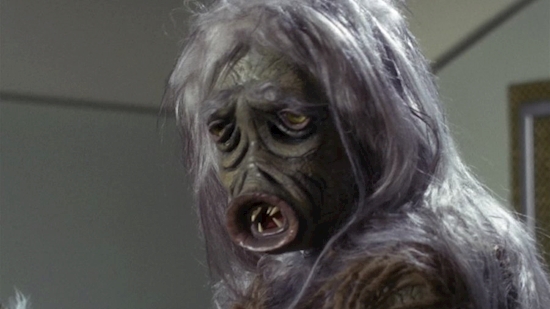
Star Trek: The Original Series – the seaons, the key episodes
Season 1 – In the 1960s, TV was a different beast. Serialization (and thus continuity) was essentially non-existent. Each story plays out over a single episode only (with one exception in three years of Star Trek), thereby not allowing for much character development each season of Star Trek’s original run is really barely indistinguishable from another – but at lest that means that season 1 isn’t filled with the “growing pains” every other ST series goes through. The biggest highlights in Star Trek’s first year has got to be “The Menagerie” (episode #s 11 and 12), an eerie story of Captain Kirk’s doomed mentor Captain Pike, and “City on the Edge of Forever” (#29), a neat twist on the traditional “preserve the past” time travel tale. Also of note: “Space Seed” (#22), the introduction of Star Trek II baddie Khan.
Season 2 – Ensign Chekov joins the bridge crew for season 2, which manages to have some fun in the explicitly comic “Trouble with Tribbles” (#15) and the absolutely bananas “Assignment: Earth” (#26). And Spock fans dig on “Amok Time” (#1) and Journey to Babel (#10) for the info doled on that wacky Vulcan culture.
Season 3 – As mentioned above, a fan campaign saved Star Trek for a third series, but NBC executives were not enthused about supporting the marginally successful series and cut the show’s operating budget in half. However, Star Trek Guide must say that tripling the budget could not save scripts like those for “Spock’s Brain” (Can all Vulcans live without a brain or just Spock?), “Specter of the Gun” (Scotty’s dead because he *thinks* he’s dead?) and “The Savage Curtain” (Kirk, Spock, Vulcan hero Surak and Abe Lincoln vs. Genghis Khan, Klingon Empire founder Kahless, 21st-century Earth dictator Mr. Green – who did it in the kitchen with a revolver – and fuzzy chick Zora?) Dude.
Personal musings, Professional Updates, and Maybe (just maybe), Useful Information
- The 11 Laws of Showrunning by Javier Grillo-Marxuach
- Have We Tried Burning it All Down?
- Finding the Right Routine
- “…Maybe the Industry Deserves to Die.”
- Different Proportional Voting Options
Every Episode of Every Star Trek Series, Ranked
As long-time readers of this blog know (all seven or nine), I am a bit of a Star Trek fan, as may be deduced from my manic series Crisis of Infinite Star Treks alone.

Where that series delves into fannish hand-wringing and minutiae, it did remind my of how much I enjoy Star Trek in its seemingly infinite combinations . I wanted to do something special for its official 50th anniversary, but life has intervened (quantum filaments, holodeck mishaps, Borg incursions… the usual).
So what better way to express rampant fandom while looking back at the history of Star Trek than to rate each of its 700+ episodes? Think of it as a gift of the pandemic (well, for those of us in Sector 001).
Regardless, doing a retrospective of previous TV Trek seemed appropriate before now… and by the time I was fully invested in rewatching and ranking everything, new TV series started appearing (and may never abate). Yes, Lower Decks , the next seasons, of Discovery and Picard , and who knows how many other series will all find their way into the rankings ’cause I’m as foolish as Stamets wanting to do one more jump .
Oh what I wouldn’t give for a fortuitous temporal anomaly right now.
Anyway: to the links! (Not great links , perhaps, but links none-the-less)

The Methodology The short version? Every TV series (even the original animated one) is in. I had to make command decisions on how to judge two-parters and continuing storyline episodes, so I did. Movies are not included.

How to Rank ‘Em Yourself Even an honest Vulcan will tell you their logic is susceptible to mortal foibles as emotions and other intangibles creep into their calculations. It could be that ranking Star Trek episodes objectively is a no-win scenario, but tell me your Kobayashi Maru solution in the comments, whether it’s the top 10, the whole list, or anything in between (be civil, please).
What if you Object, Dislike, or Outright Hate My Rankings? No self-respecting Starfleet captain nor honorable Klingon commander would take such injustice lying down. Do something about it!

Re-watching (and in some cases, watching) all 700+ episodes of Star Trek took an inordinate amount of time over the past few years, so there’s no way I wasn’t going to comment on everything, including both spoilers… and a certain amount of irreverence. If you’re not ready for potential spoilers and snark, stick to the links marked “episode names only.”
(As alluded above, these lists will be updated as new episodes premiere. The lists below include all episodes for all series before July 2020)
The Whole Enchilada (All Series) With Comments (includes possible spoilers & snark) | Episodes names only
Star Trek (The Original Series or TOS) With Comments (includes possible spoilers & snark) | Episodes names only
Star Trek (The Animated Series or TAS) With Comments (includes possible spoilers & snark) | Episodes names only
Star Trek: The Next Generation (TNG) With Comments (includes possible spoilers & snark) | Episodes names only | Viewing Guide
Star Trek: Deep Space Nine (DS9) With Comments (includes possible spoilers & snark) | Episodes names only
Star Trek: Voyager (VOY) With Comments (includes possible spoilers & snark) | Episodes names only | Viewing Guide
Enterprise (later Star Trek: Enterprise or ENT) With Comments (includes possible spoilers & snark) | Episodes names only Viewing Guide
Star Trek: Discovery (DSC) – Up through the first two seasons With Comments (includes possible spoilers & snark) | Episodes names only
Star Trek: Short Treks (ST) With Comments (includes possible spoilers & snark) | Episodes names only
Star Trek: Picard (PIC) – Up through the first season With Comments (includes possible spoilers & snark) | Episodes names only
Star Trek: Lower Decks (LD) (To be added ideally before season three.)
Star Trek: Prodigy (PRO) (Ideally, to be added in 2022)
Star Trek: Strange New Worlds (SNW) (To be added after season one completes, so… maybe 2023?)
I hope reading these lists reminds you of some of your favorites, encourages discussion, and maybe prompts you to a check out an episode –or a series– you may have overlooked.
In whatever you do, live long and prosper… unless it’s breeding tribbles. One way or another, that will probably end badly.
Share this:
- Click to share on Twitter (Opens in new window)
- Click to share on Facebook (Opens in new window)
- Click to share on LinkedIn (Opens in new window)
- Click to email a link to a friend (Opens in new window)
17 thoughts on “Every Episode of Every Star Trek Series, Ranked”
- Pingback: Star Trek Day – Panel Videos | Bjorn Munson
- Pingback: A Viewing Guide for Star Trek: Enterprise | Bjorn Munson
- Pingback: My 50 Favorite Films, 2020 Edition | Bjorn Munson
- Pingback: It’s Time to Rank Muppets | Bjorn Munson
- Pingback: A Singular Ranking of Five Score Sherlock Holmes Portrayals. Most Singular! | Bjorn Munson
Beautiful! the methodology, all of it! i would never have seen enterprise otherwise. & thr are gr8 stand alones in thr.
this was a truly spectacular & worthwhile endevour. thx, & nice work. -JC
may i inquire; was this a lockdown endeavor? marvelous either way. & thx again for all of your work. -JC
- Pingback: “It’s Trek Jim, but not as we know it.” | Bjorn Munson
- Pingback: It’s a Wool-Gathering Blogiversary! | Bjorn Munson
- Pingback: Infinite Ire in Infinite Combinations | Bjorn Munson
- Pingback: It’s a Bronze Blogiversary… with Salt! | Bjorn Munson
Big fan of the blog! Dying to see your rankings of SNW and the newest PICARD episodes!!!
Thanks so much! My goal is to get to seasons 2 and 3 of Picard as well as Prodigy this summer before September 8th (a natural time to debut them). I’m not sure if I’ll get to SNW as part of me will want to do season 2 which is about to warp in before we know it. The trick is actually updating the Whole Enchilada. That’s daunting and part of me feels I should do a re-sort in a few years. Argh! I’ve created a monster like the Krell from Forbidden Planet! Still, it’s fun.
- Pingback: The Promise of Star Trek: Prodigy Cut Short – Bjorn Munson
- Pingback: A Pause from Boldly Going – Jabberwocky Audio Theater
- Pingback: A Viewing Guide for Star Trek: Voyager – Bjorn Munson
- Pingback: Star Trek’s Mission Log: 58 Years & Counting – Bjorn Munson
Leave a Reply Cancel reply
Your email address will not be published. Required fields are marked *
Notify me of follow-up comments by email.
Notify me of new posts by email.
This site uses Akismet to reduce spam. Learn how your comment data is processed .
Den of Geek
Star Trek Streaming Guide: Where to Watch All the TV Shows and Movies
Find out where you can stream all the voyages of sci-fi’s longest-running franchise.

- Share on Facebook (opens in a new tab)
- Share on Twitter (opens in a new tab)
- Share on Linkedin (opens in a new tab)
- Share on email (opens in a new tab)
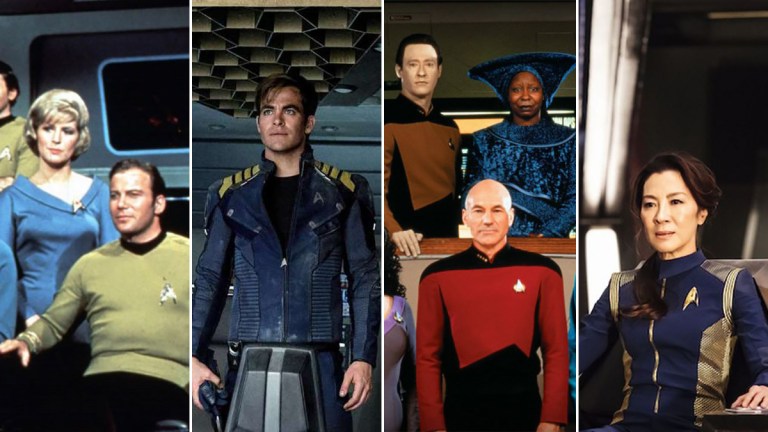
Launched on September 8, 1966 — nearly 54 years ago — the NBC-TV series Star Trek was the beginning of a new age of science fiction on television and, eventually, the big screen. The first show to echo the sophistication and vision of sci-fi literature , Star Trek was only a cult hit at the time of its initial run but refused to die even after its cancellation, with the original 79 episodes running for years in syndication.
More than five decades later, Star Trek encompasses eight TV series (a total of 764 episodes and counting) and 13 films, plus countless books, comics, games and more. It’s had its ups and downs, its high points and its misfires, but it remains one of the most beloved and durable franchises in all of pop culture.
Now, thanks to streaming, all those episodes and movies are available to watch any time (we know you diehard Trekkers have the Blu-rays and DVDs, but you don’t have to break those out anymore). Below is a handy guide to where you can stream every iteration of Trek , from The Original Series to the movies to the new Star Trek: Picard . Grab your remote and boldly go…
Star Trek TV
Star Trek: The Original Series (1966-1969)
The one that started it all, the original Star Trek came along at a time when most screen sci-fi (movies and TV) was still just monster movies or kiddie fare ( Lost in Space , anyone?). Gene Roddenberry ’s vision of an intelligent, allegorical sci-fi series, which used actual genre writers for much of its first two seasons, was groundbreaking in ways that reverberate to this day. And its cast, led by William Shatner as Captain Kirk, Leonard Nimoy as Spock and DeForest Kelley as Dr. McCoy, became iconic.
Ad – content continues below
Available in the US on Amazon , Hulu , Netflix , CBS All Access
Available in the UK on Netflix UK , Amazon UK * (*purchase only)
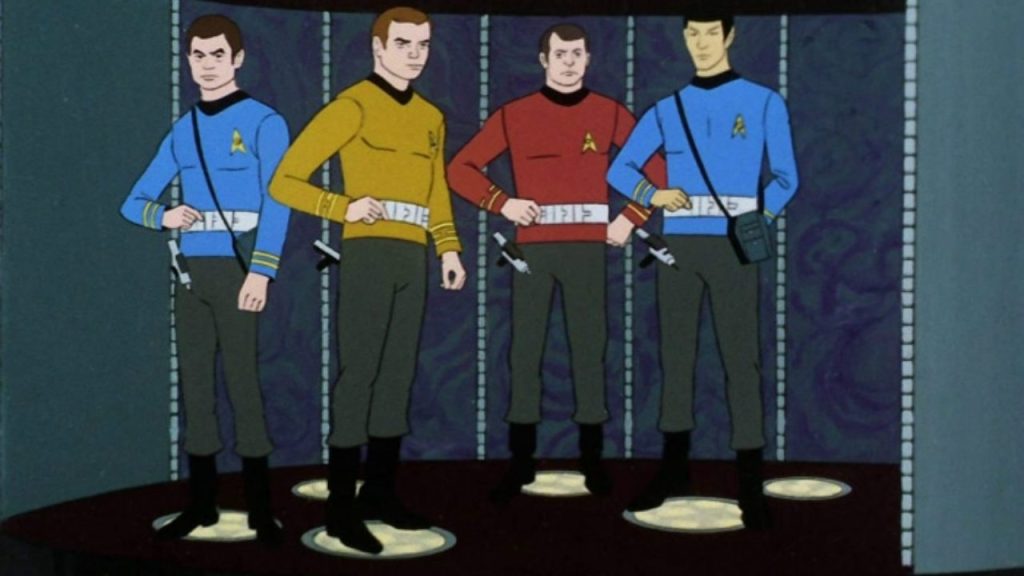
Star Trek: The Animated Series (1973-1974)
Using the voices of many of the original cast members and even employing writers from the original series, TAS had a genuine chance to extend the original show with the visual freedom animation offered. But the format turned out to be its enemy, as clunky, cheap animation and frequent reuse of shots gave the show a shoddy, amateurish reputation. Some of the stories are quite good, however.
Available in the US on Amazon , CBS All Access
Available in the UK on Netflix UK
Star Trek: The Next Generation (1987-1994)
Set nearly a century after the original series, with Gene Roddenberry mandating that conflict between the crew members be diminished by that point, ST: TNG proved to be enormously popular even with a brand new, unfamiliar crew. It took most of three seasons for the show to find its footing, but Captain Picard (a magnificent Patrick Stewart ) and company went on many captivating and genuinely outstanding adventures of their own.
Available in the US on Amazon , Netflix , CBS All Access , Hulu
Get the best of Den of Geek delivered right to your inbox!
Star Trek: Deep Space Nine (1993-1999)
Many fans consider DS9 the best Trek series ever , and they certainly can make a good argument for it: the first Trek show not set on a starship, but instead on a remote space station, DS9 addressed cultural divides, character conflict, religion and war in a bolder fashion that any Trek entry before it — while also utilizing the kind of serialized storytelling that is now the standard across the medium.
Available in the UK on Netflix UK , Amazon UK* (*purchase only)
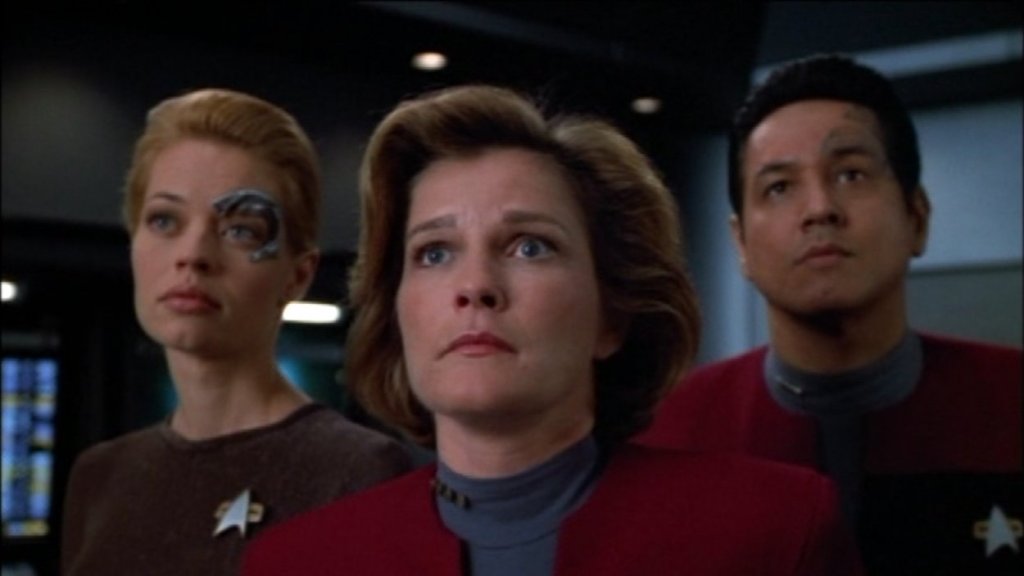
Star Trek: Voyager (1995-2001)
Voyager found members of a Federation starship and the rebel Maquis stranded together 70,000 years from Earth in the Delta Quadrant, facing a 75-year journey home. Headed by Trek ’s first female captain , Kathryn Janeway (Kate Mulgrew), Voyager encountered all kinds of interesting new races as well as old enemies the Borg during the long and often compelling journey home.
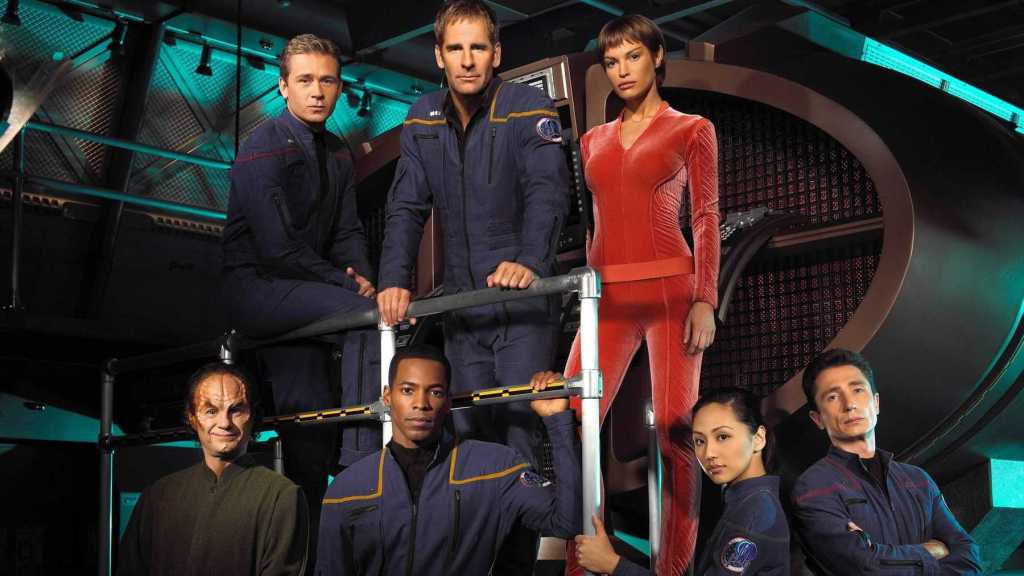
Star Trek: Enterprise (2001-2005)
The first series to act as a prequel, set a decade before the creation of what would become the United Federation of Planets, Enterprise followed the crew of the first ship to bear that name. Uneven in quality and struggling to find resonant stories, Enterprise was canceled after four seasons and ended an 18-year run for Trek on TV.
Available in the US on Amazon , Netflix , Hulu , CBS All Access
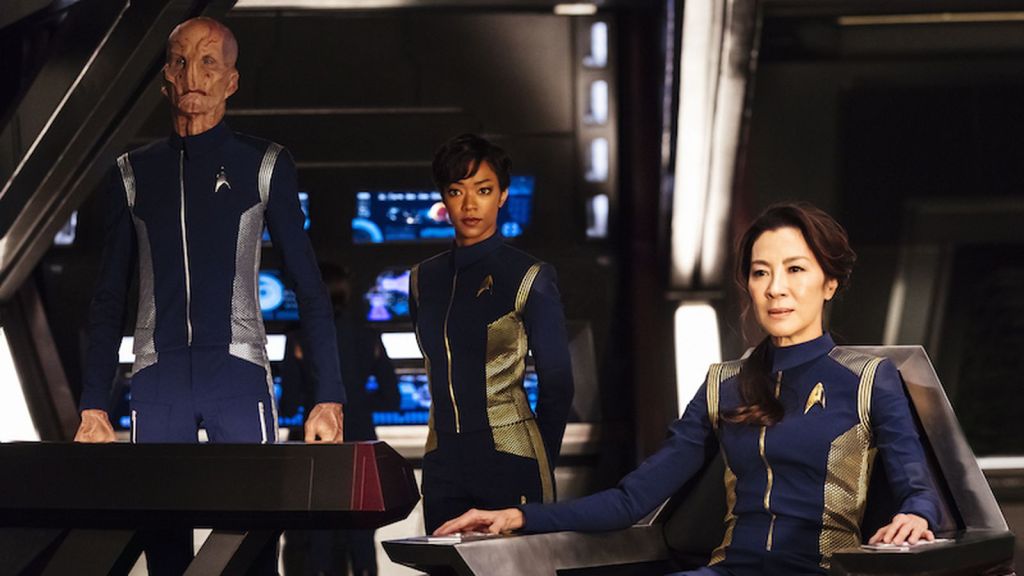
Star Trek: Discovery (2017- )
Set 10 years prior to TOS , Discovery ’s troubled birth (it went through numerous delays and several showrunners) led to the most polarizing show in the franchise to date. Focusing for once on a central character other than the captain — mutinous anthropologist Michael Burnham (Sonequa Martin-Green), who turns out to be the adopted sister of one Mr. Spock — it has often ignored or played fast and loose with Trek continuity while painting Starfleet in a more conspiratorial light. Season 3 will debut in 2020.
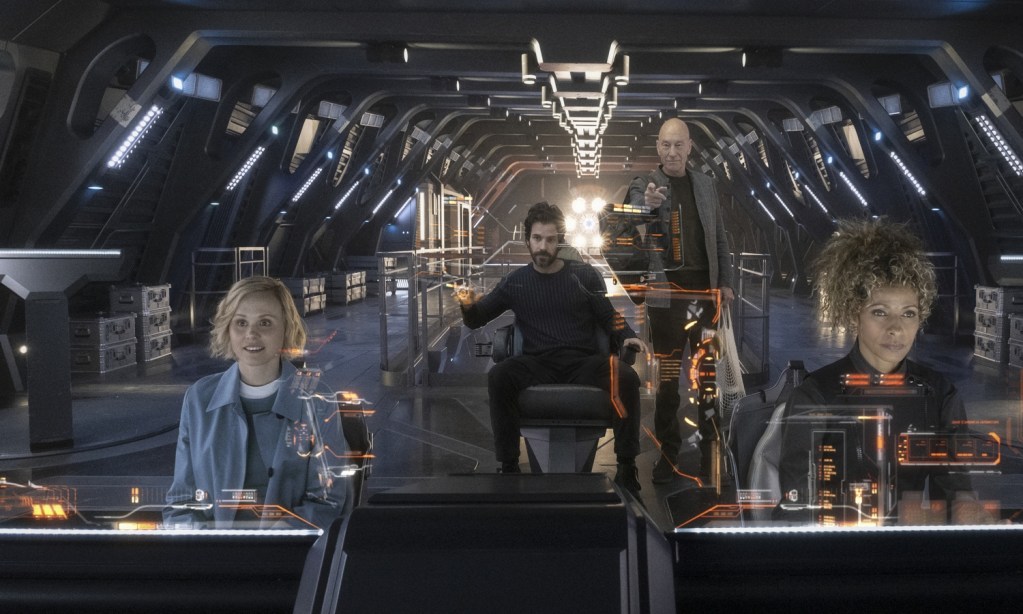
Star Trek: Picard (2020- )
Like Discovery before it, Picard has divided Star Trek fans with its depiction of a Federation in decline, marked by bigotry, deception and treachery. But there is no questioning the powerful presence of Patrick Stewart, playing an older, flawed Picard for the first time in 18 years, and the thrill of seeing old friends like Seven of Nine, Will Riker and Deanna Troi. The show has certainly had its moments ; we’ll see if more are to come in the already-announced season 2 .
Available in the UK on Amazon UK
Star Trek: 50 Best Episodes
The 15 best worst episodes of star trek: the original series, star trek movies.
Star Trek: The Motion Picture (1979)
After an aborted attempt at a second TV series ( Star Trek: Phase II ), Paramount Pictures brought Trek to the big screen in a lavish, $40 million epic (the most expensive movie of its time) that reunited the original crew in a 2001 -like encounter with a massive, mysterious space probe. Slow-moving, alternately impressive and shaky visually, ST: TMP nevertheless proved that the crew of the U.S.S. Enterprise could hold their own on the big screen — and strangely, the film has actually aged better than most.
Latest TV reviews
Red eye review: itv thriller starts silly, gets great, star trek: discovery season 5 episode 4 review – face the strange, conan o'brien must go reveals conan's natural habitat is everywhere.
Available in the US on Amazon , Hulu
Available in the UK on NOW TV , YouTube *, Amazon UK *, Sky Store * (*purchase/rent only)
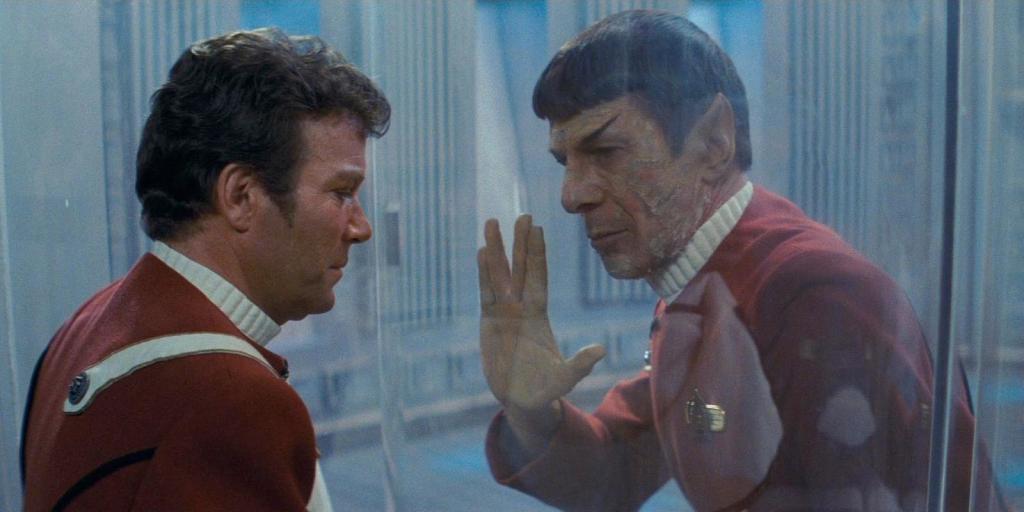
Star Trek II: The Wrath of Khan (1982)
Still considered the finest Trek movie of all , and rightfully so, The Wrath of Khan focused — like the original show — on character and story instead of visual effects and esoteric concepts. Bringing back a deadly enemy from the first season, the generic superman Khan (Ricardo Montalban), the movie was thrilling, dramatic and, with the death of Spock at the finale, incredibly moving.
Available in the UK on NOW TV , *YouTube , *Amazon UK , * Sky Store (*purchase/rent only)
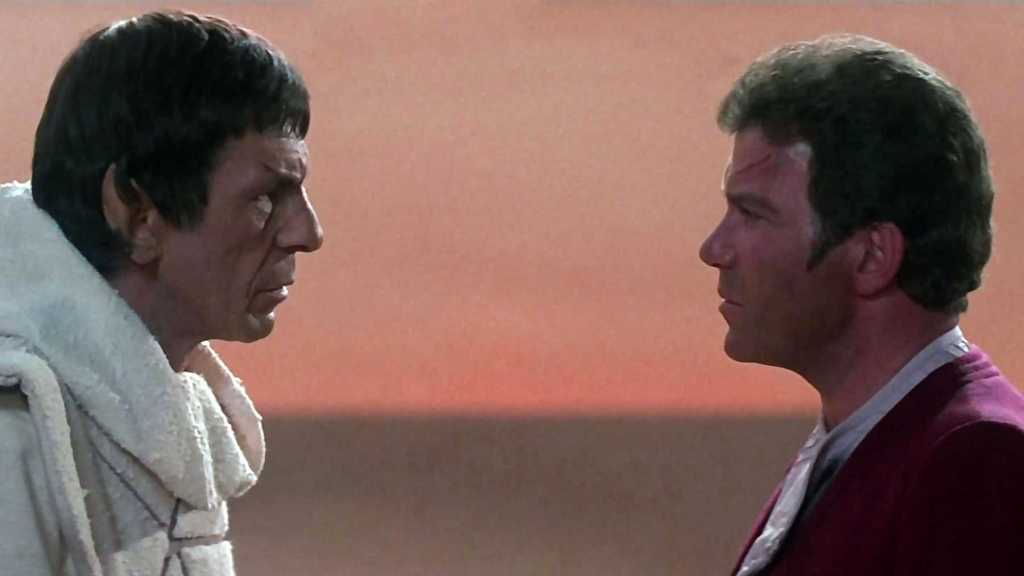
Star Trek III: The Search for Spock (1984)
Even though the end of Star Trek II strongly hinted at Spock’s return, it wasn’t a given. But Leonard Nimoy did come back for Star Trek III — as director (and yes, as Spock too in the film’s closing minutes) of this somber and often underrated entry . Captain Kirk loses almost everything — his beloved ship, his commission and his newly reconciled son — to save his friend’s life in a poignant story about friendship and loyalty. And there’s a bad-ass villain too, a Klingon captain played to the hilt by Christopher Lloyd.
Available in the UK on NOW TV , * YouTube , * Amazon UK , * Sky Store (*purchase/rent only)
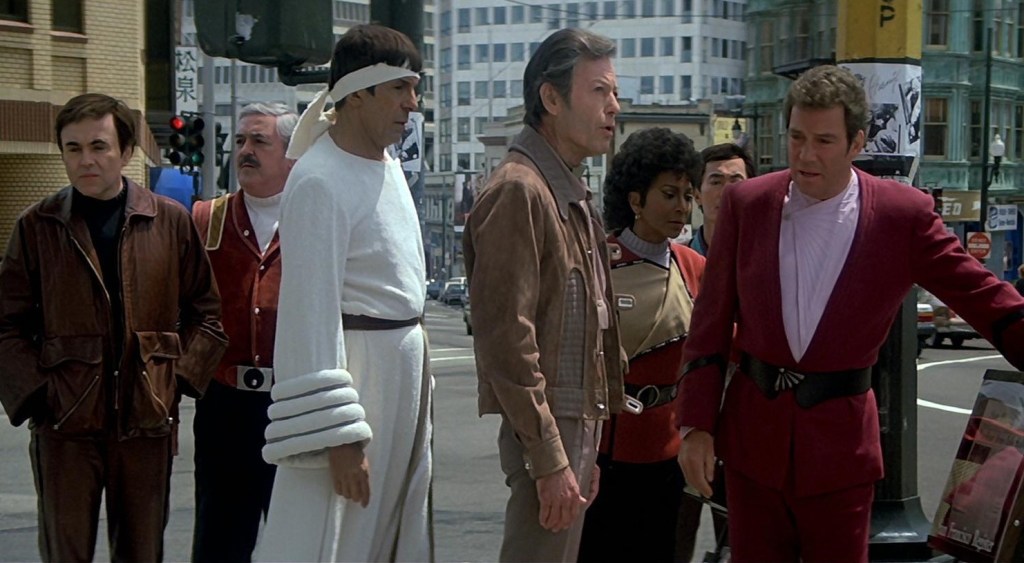
Star Trek IV: The Voyage Home (1986)
Leonard Nimoy’s second outing as director is both a comedy and an environmentally themed adventure — and it turned out to be one of the biggest hits of the franchise. This light-hearted romp sent Kirk and the gang back to 20 th century San Francisco to rescue a pair of humpback whales, and the fish-out-of-water (pun intended) antics of the crew provide plenty of laughs and a ton of heart.
Available in the US on Amazon
Available in the UK on NOW TV , * Amazon UK , * YouTube , * Sky Store (*purchase/rent only)
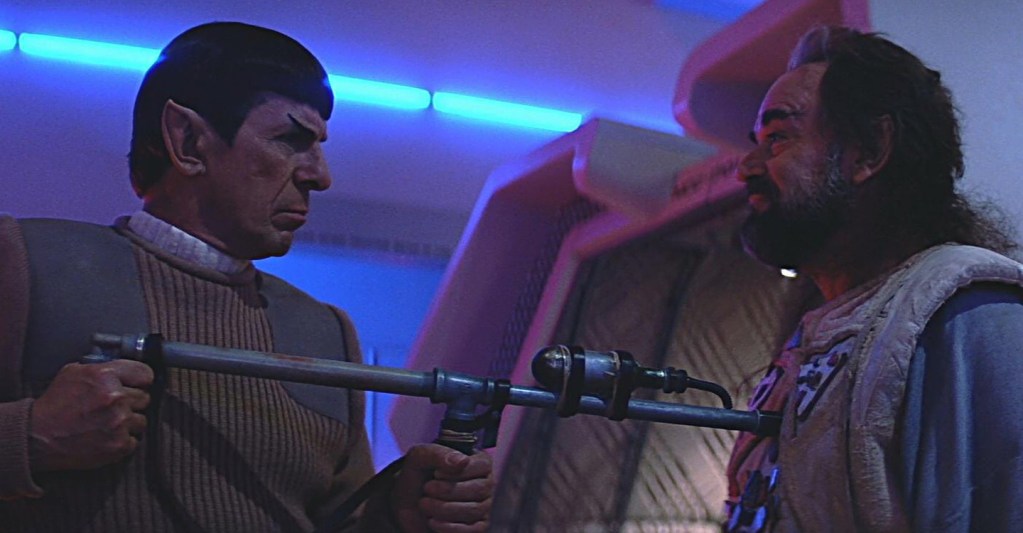
Star Trek V: The Final Frontier (1989)
Shatner got behind the camera for this turgid, unfunny mess , which regularly rates near the bottom of any Trekker’s list. The old “alien pretending to be God” trope, a long-lost brother we never knew Spock had and the other cast members acting by and large like buffoons make this perhaps the most embarrassing of the Enterprise ’s big screen voyages. There are a few nice moments — there always are — but this nowhere near first on our revisit list.
Available in the UK on NOW TV , * Amazon UK , *YouTube , * Sky Store (*purchase/rent only)
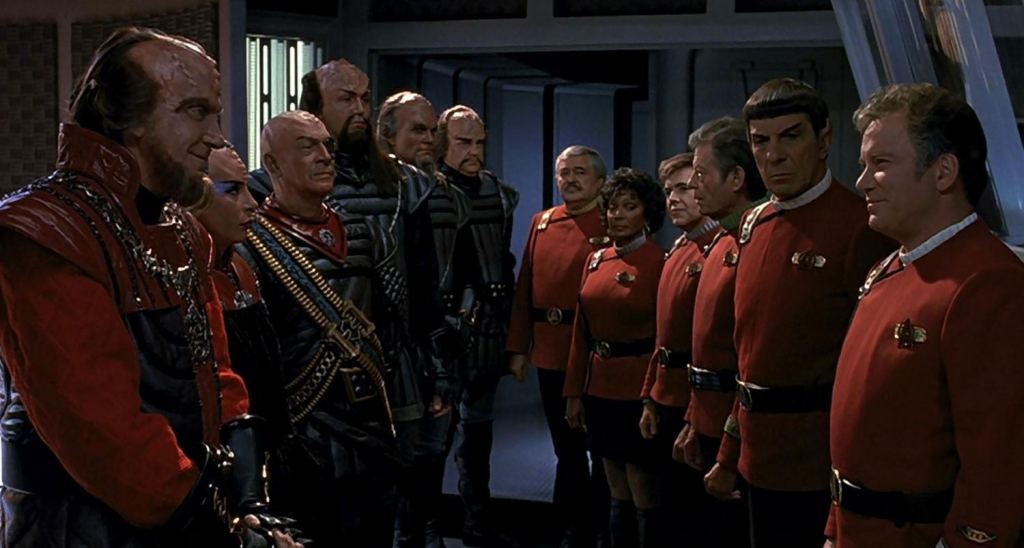
Star Trek IV: The Undiscovered Country (1991)
The classic Trek cast bounced back from Star Trek V with a final adventure that was also one of their best . A suspenseful, urgent meditation on aging, grievance and the end of the Cold War, Star Trek IV was a remarkable example of how Trek could show us at our finest even while facing down our lingering demons. Plus it ends with both a great space battle and one of the greatest cast send-offs ever (which was emulated by none other than Avengers Endgame ).
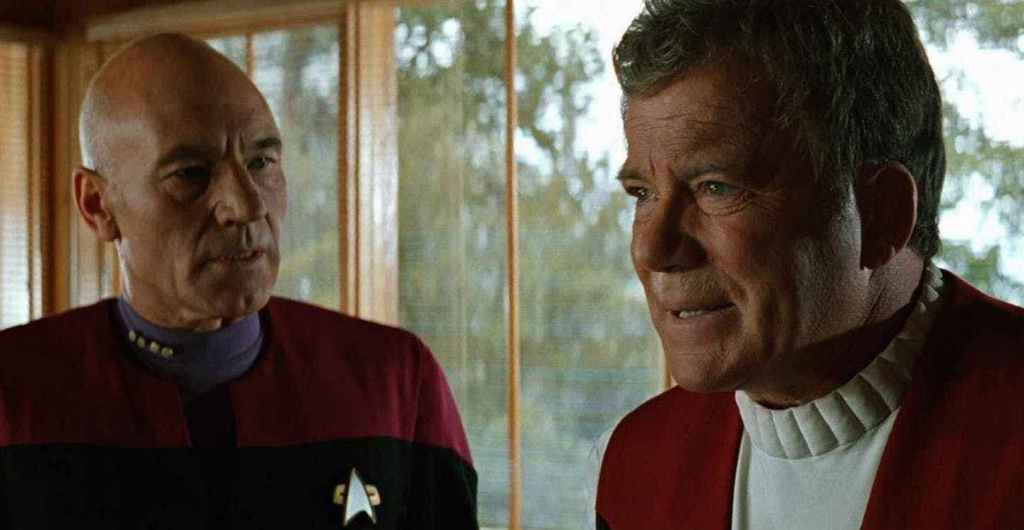
Star Trek: Generations (1994)
What could have been a magnificent passing of the torch from the classic Trek cast to the TNG crew ends up looking and feeling more like a tepid extended TNG episode with weak cameos from Kirk, Scotty (James Doohan) and Chekov (Walter Koenig). Patrick Stewart and his team are all solid, as is villain Malcolm McDowell, and the crashing of the Enterprise is a genuinely gripping setpiece. But the story and motivations are undercooked — as is most of the movie.
Available in the UK on NOW TV , * Amazon UK , * Sky Store , * YouTube (*purchase/rent only)
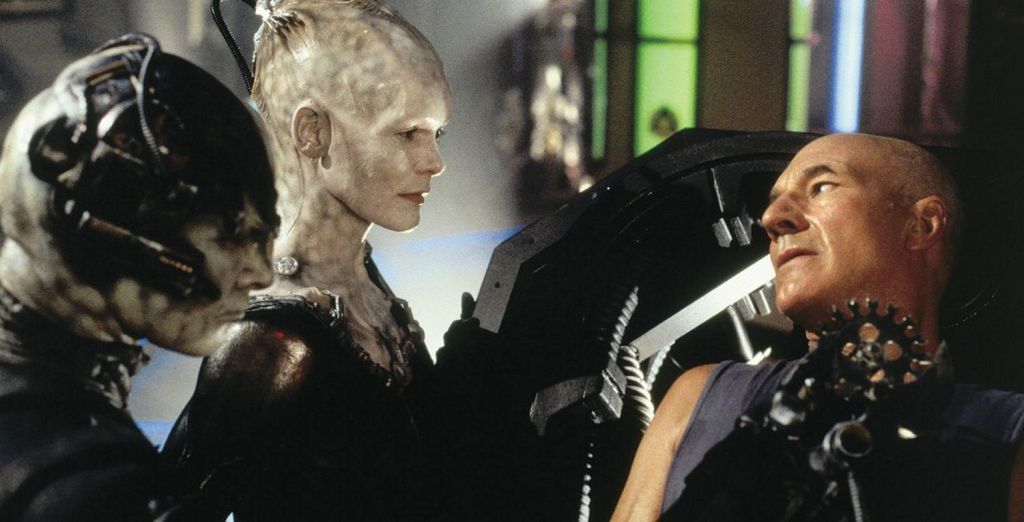
Star Trek: First Contact (1996)
Easily the best of the TNG quartet, First Contact travels back in time to the very start of Earth’s push into space, where the Borg intends to cripple humanity once and for all. The crew of the Enterprise follow them to make sure history isn’t changed, even as Picard confronts his fear and hatred of the Borg . Jonathan Frakes does a nice first-time directing job, balancing the action and character work ably, while Alice Krige steals the show as the sensual Borg Queen.
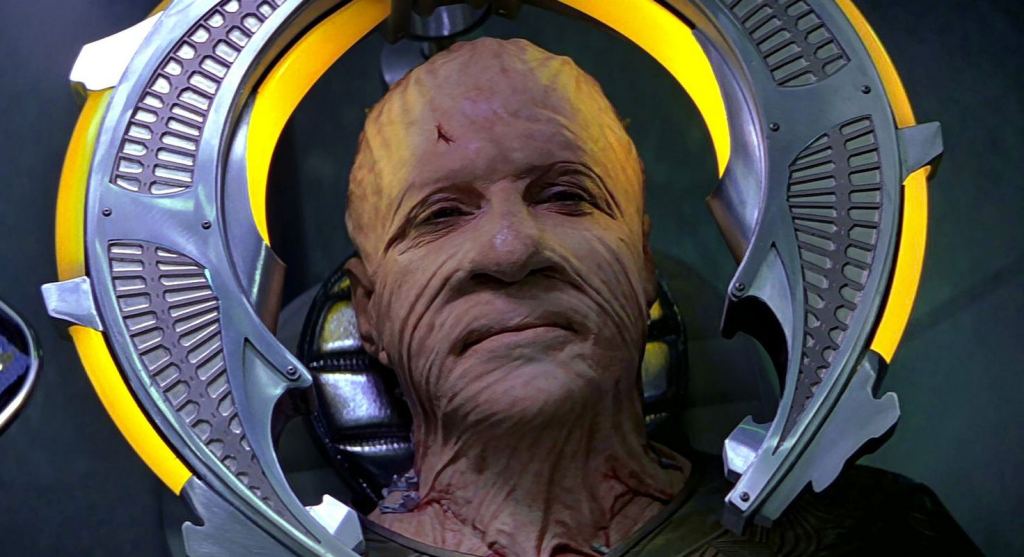
Star Trek: Insurrection (1998)
Like Generations , the third TNG theatrical outing feels like a mediocre TV segment stretched to feature length; even Frakes’ direction seems uninspired. One difference: with Picard fighting a secret plan (engineered by F. Murray Abraham, above) to uproot the natives of a “fountain of youth” planet, the seeds were planted for later Trek entries that portrayed an increasingly corrupt Federation. Otherwise, this is a forgettable, often cheesy film.
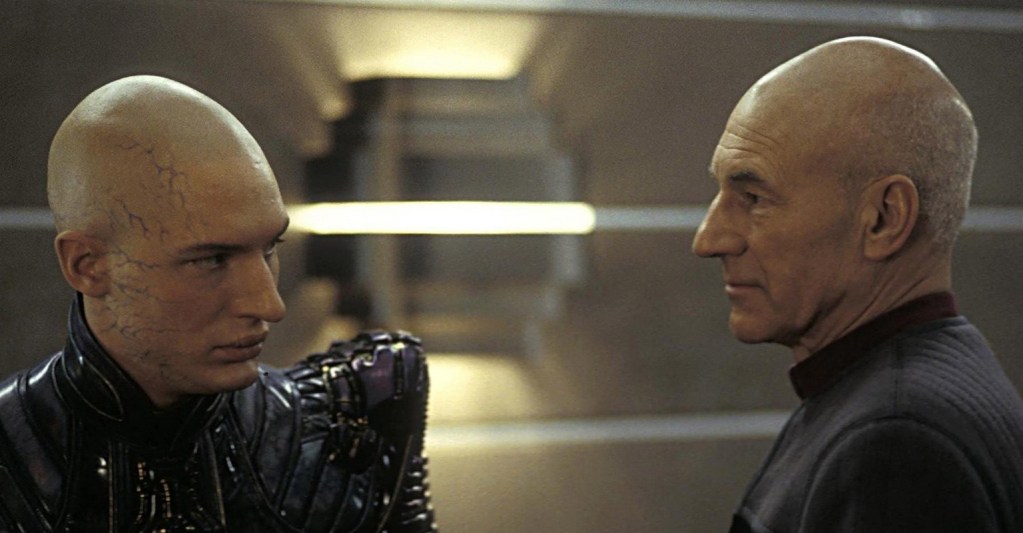
Star Trek: Nemesis (2002)
The final big-screen outing for the TNG cast is better than its reputation suggests , as Picard squares off against a renegade Romulan who happens to be his clone. Tom Hardy chews the scenery fabulously as the latter, and the climactic battle between his massive ship and the Enterprise is well handled by director Stuart Baird. There’s also a surprising emotional payoff for Data (Brent Spiner) that ends up being the hook for Star Trek: Picard 18 years later.
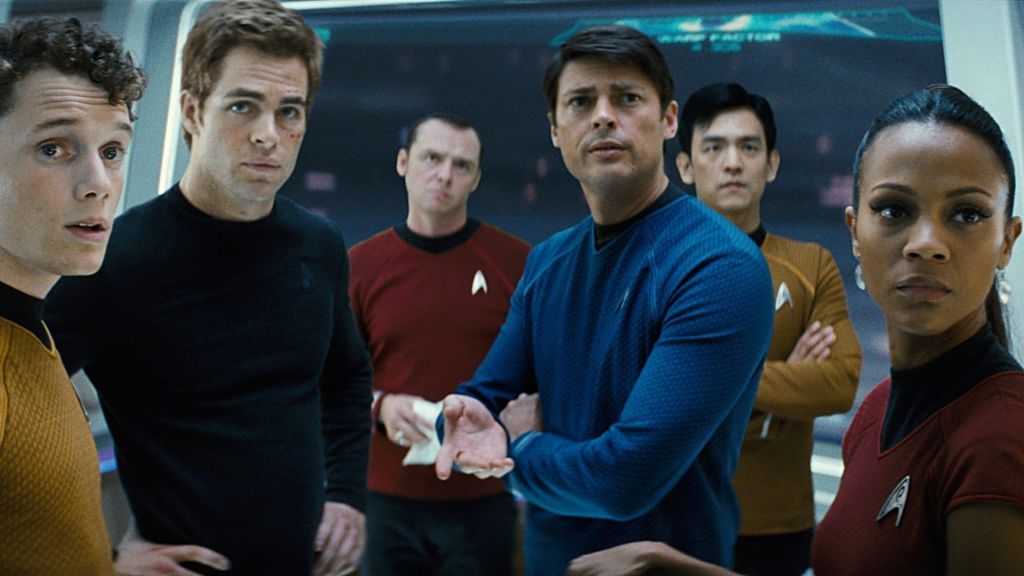
Star Trek (2009)
J.J. Abrams does what many thought couldn’t be done — he reboots Star Trek with a fresh, young cast inhabiting the original roles made iconic by Shatner, Nimoy and their crew. The new cast, led by Chris Pine as Kirk and Zachary Quinto as Spock, is the best thing about the film, which also uses a clever plot device to position this timeline just slightly to the side of the original one. The reliance on action over ideas is a bit of a letdown, and unfortunately would carry over to the next two movies.
Available in the UK on Netflix , NOW TV , * Amazon UK , * Sky Store , * YouTube (*purchase/rent only)
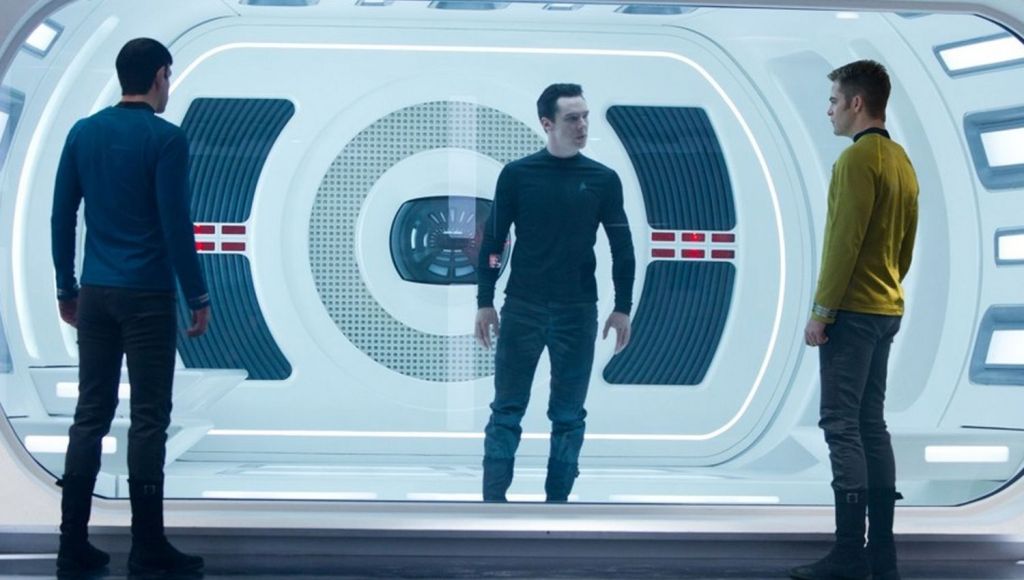
Star Trek Into Darkness (2013)
One of the worst Trek films ever , right down there with The Final Frontier . STID insults both fans and casual viewers with a brain-dead script, frantic action and massive contrivances (such as the sudden ability for someone to beam across the galaxy or the screenwriters’ well-worn “magic blood” gimmick). But its most egregious offense is turning into a half-assed remake of The Wrath of Khan that’s as dumb as it is pointless. This is what happens when people tackle Trek with no understanding of it.
Available in the UK on * Amazon UK , * Sky Store , * YouTube (*purchase/rent only)
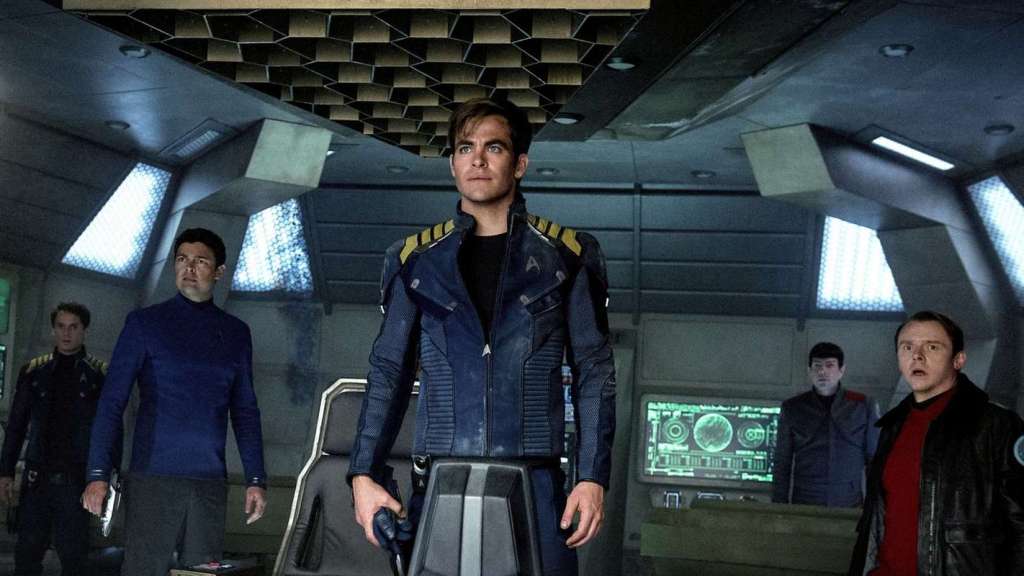
Star Trek Beyond (2016)
Still too reliant on action over depth, and featuring the third revenge-driven storyline in a row, Star Trek Beyond is nevertheless better than its predecessor . It mostly works as a standalone adventure, and once again the Pine/Quinto cast delivers with heart. But even though Beyond does occasionally capture the vibe of classic Trek , there’s a vague sense of desperation at work — like the franchise knows it’s run out of gas (and crashing the Enterprise for the third time in 13 films doesn’t help).
Available in the UK on * Sky Store , * Amazon UK , * YouTube (*purchase/rent only)

Don Kaye | @donkaye
Don Kaye is an entertainment journalist by trade and geek by natural design. Born in New York City, currently ensconced in Los Angeles, his earliest childhood memory is…
The Top 57 Episodes of ‘Star Trek,’ Ranked From Great to Perfect

First, let’s be clear: Ranking the best “Star Trek” episodes is a silly thing to do. To date, the longest-running American TV franchise has aired a gargantuan 890 episodes and counting, starting with the original series in 1966. Since then, at least one “Star Trek” TV show has aired (or streamed) every decade, totaling 11 so far (with more on the way ). Choosing the best episodes within such a boundless, occasionally contradictory storytelling galaxy seems about as wise as cheating when playing poker with a Klingon.
On the other hand, there may be no more time-honored tradition among “Star Trek” fans than a vigorous debate over what constitutes the best of the franchise. (Best series ? Best captains ? Best starships ? Best aliens ? Best uniforms ? They’ve all been ranked multiple times !)
In that spirit — and to commemorate the 57th anniversary of “Star Trek” on Sept. 8 — Variety ’s resident “Trek” geeks have ranked the top 57 episodes of all time, across the franchise.
Creating our list required some deep-dish nerdiness in its own right: We compiled a long list of episodes from each series that we felt deserved to be on the final ranking. Then we created our own individual rankings — and promptly realized our taste was quite divergent. To reconcile our lists, we adopted the approach of the great movie ranking podcast, Screen Drafts : We took alternating turns placing a pick from 57 to 1, and we each had two opportunities to veto the other’s pick (which in every case was to ensure it was placed higher on the list).
Other than the short-lived “Star Trek: The Animated Series” (1973-1974), this list reflects every other iteration of “Trek” on TV: “Star Trek: The Original Series” (1966-1969); “Star Trek: The Next Generation” (1987-1994); “Star Trek: Deep Space Nine” (1993-1999); “Star Trek: Voyager” (1995-2001); “Star Trek: Enterprise” (2001-2005); “Star Trek: Discovery” (2017-2024); “Star Trek: Picard” (2020-2023); “Star Trek: Prodigy” (2021-2022); and the ongoing “Star Trek: Lower Decks” (2020-present) and “Star Trek: Strange New Worlds” (2022-present).
The Way to Eden

“The Original Series” — Season 3, Episode 20
Look, this episode gets a lot of hate. But the fact is “TOS” is known (by today’s standards) for being very campy, and there is no episode campier than this one. A group of space hippies board the Enterprise on their journey to a mythical planet called Eden, where they can live happily forever. The episode memorably features Charles Napier (who would go on to a long career playing tough guys, villains, cops and the like) breaking out into song a bunch of times, including a jam session with Spock (Leonard Nimoy). —Joe Otterson Original airdate: Feb. 21, 1969
Terra Prime

“Enterprise” — Season 4, Episode 21 More than any other episode of “Enterprise,” “Terra Prime” made the most of the show’s mission to dramatize the beginnings of Starfleet, 100 years before the events of “TOS.” Just as a newfound coalition of planets begins to form on Earth (a precursor to the Federation), Captain Archer (Scott Bakula) and his crew must stop a xenophobic terrorist (played to the hilt by future “Star Trek Into Darkness” villain Peter Weller) bent on forcing all aliens to leave Earth. Subtle, it ain’t, but the story feels more relevant today than it did 20 years ago, and everyone in the cast gets a moment to shine. Alas, it came too late: “Enterprise” had been canceled before this episode even went into production. —Adam B. Vary Original airdate: May 13, 2005

“Prodigy” — Season 1, Episode 6
The animated “Prodigy” was the first “Star Trek” series geared toward kids, but that doesn’t mean there weren’t things for older “Trek” fans to enjoy. In particular, “Kobayashi” perfectly embodies what makes this show a worthy entry in “Trek” canon. Dal (Brett Gray) and Jankom Pog (Jason Mantzoukas) discover the holodeck aboard the Protostar, where they decide to go through the Kobayashi Maru, a.k.a. the “no-win scenario” that Capt. Kirk successfully beat during his time at the Academy. He gets help along the way from legendary characters like Spock, Dr. Crusher (Gates McFadden) and Odo (René Auberjonois). —J.O.
Original airdate: Jan. 6, 2022
Stormy Weather

“Discovery” — Season 4, Episode 6
On a mission to discover the origins of a cataclysmic gravitational anomaly, the U.S.S. Discovery enters a subspace rift and finds itself trapped inside a lethal black void that threatens to collapse in on the ship. The result is a classic race-against-time thriller (directed by “Trek” mainstay Jonathan Frakes), but what makes “Stormy Weather” stand out amid the heavily serialized episodes of “Discovery” is its emotionally resonant use of the ship’s sentient A.I. computer, Zora (Annabelle Wallis), who has to learn how to calm her mind from overwhelming stimuli in order to guide the ship out of danger. —A.B.V.
Original airdate: Dec. 23, 2021
Seventeen Seconds

“Picard” — Season 3, Episode 3
“Picard” didn’t find itself until Season 3, which reunited the core cast of “The Next Generation” — and it was really Episode 3 that sealed the deal. Riker (Frakes) is forced to take command of the Titan as Vadic (Amanda Plummer) and the Shrike hunt them. Picard (Patrick Stewart) and Dr. Crusher get an all-time great scene together as she reveals why she never told him about their son, Jack (Ed Speleers). Worf (Michael Dorn) makes his big return. We learn the Changelings are still intent on attacking the Federation. Riker and Picard end up at odds in a way we’ve never seen before. In short, epic. —J.O.
Original airdate: March 2, 2023
The Enemy Within

“The Original Series” — Season 1, Episode 5
The transporter — the cause of, and solution to, so many “Star Trek” problems — accidentally splits Capt. Kirk (William Shatner) into two people: Good Kirk, who is wracked with indecision, and evil Kirk, who is a histrionic asshole. Come for a meditation on the darkness that lies tucked inside everyone’s psyche, stay for some of William Shatner’s most deliciously hammy acting — and this was just the fifth episode of the series! —A.B.V.
Original airdate: Oct. 6, 1966
Family Business

“Deep Space Nine” — Season 3, Episode 23
The Ferengi episodes of “DS9” are always great comic relief, with this episode giving fans their first view of the home planet of Ferenginar and Ferengi culture in general. Quark (Armin Shimerman) and Rom (Max Grodénchik) must return home when their mother, Ishka (Andrea Martin), is accused of acquiring profit (gasp!), something Ferengi females are forbidden to do. Shimerman and Martin shine as they play out Quark and Ishka’s relationship, while Grodénchik really gets to put his comedic chops on display. This episode is also notable as the first appearance of Brunt (Jeffrey Combs) from the Ferengi Commerce Authority, as well as Kasidy Yates (Penny Johnson Jerald), frequent love interest of Cmdr. Sisko (Avery Brooks). —J.O.
Original airdate: May 15, 1995
Blink of an Eye

“Voyager” — Season 6, Episode 12
The Voyager gets stuck in orbit around a planet where time passes far more rapidly than in the rest of space, as the episode alternates between the bemused curiosity of Capt. Janeway (Kate Mulgrew) and her crew and the awestruck preoccupation of the expeditiously progressing populace on the planet below, for whom Voyager is a sparkling, fixed constant in the night sky. At one point, the Doctor (Robert Picard) beams down to the planet to investigate, and a delay of only a few minutes on Voyager means he spends three years on its surface. He even adopts a son! One of the great, wild what if? episodes of “Star Trek.” —A.B.V.
Original airdate: Jan. 19, 2000

“The Next Generation” — Season 3, Episode 23
Mark Lenard absolutely crushed the role of Spock’s father, Sarek, in multiple episodes across multiple “Star Trek” series and movies, but this episode is perhaps his finest performance as the character. Sarek comes to the Enterprise-D on what is meant to be his final mission, only for the crew to learn he is suffering from Bendii Syndrome. The condition leaves him prone to uncharacteristic emotional outbursts while also causing him to telepathically influence the emotions of those around him. Picard saves the day by mind melding with Sarek, allowing him to finish his mission with dignity — and provide Stewart with the chance for some powerhouse acting as he channels Sarek’s volcanic emotions. —J.O.
Original airdate: May 14, 1990

“Enterprise” — Season 3, Episode 10
“Trek” loves a moral dilemma, and this one’s a doozy: After Cmdr. Tucker (Connor Trinneer) is critically injured while the Enterprise is on a deep space mission, Dr. Phlox (John Billingsley) suggests growing a “mimetic symbiote” of Trip — effectively, a clone with a built-in two-week lifespan — in order to create the brain tissue needed to save Trip’s life. But that means the Enterprise crew must endure watching Trip’s clone rapidly age from a precocious kid to an adult man (played by Trinneer with eerie self-possession), who then pleads for his own right to live. Creepy and heartbreaking in equal measure. —A.B.V.
Original airdate: Nov. 19, 2003
Trials and Tribble-ations

“Deep Space Nine” — Season 5, Episode 6
This episode is a love letter to the original series, with the Defiant’s crew transported back in time to the events of “The Trouble With Tribbles.” A Klingon agent is planning to use a booby-trapped tribble to assassinate James T. Kirk. Thanks to digital editing, the crew is able to interact with the original Enterprise crew and keep the timeline intact. —J.O.
Original airdate: Nov. 4, 1996

“Deep Space Nine” — Season 2, Episode 23
Mirror universe episodes of “Star Trek” are (almost) always fun, if ultimately a little silly. But this one — in which Kira (Nana Visitor) and Dr. Bashir (Alexander Siddig) find themselves in an alternate reality in which Bajor, Cardassians and Klingons subjugate humans as slaves — comes closest to matching the spark of discovery in the original “TOS” episode. It’s especially fun to watch Visitor devour the role of Kira’s deliciously wicked mirror counterpart, the Intendant. —A.B.V.
Original airdate: May 16, 1994
Memento Mori

“Strange New Worlds” — Season 1, Episode 4
This episode proved “Strange New Worlds” — the newest “Star Trek” series — could be as action-packed as the very best of “Star Trek.” The Enterprise crew find themselves on the run from the Gorn, a savage enemy (first introduced on “TOS” and largely ignored in “Trek” canon) about which they know virtually nothing. They are forced to use every resource at their disposal to outwit and outrun the Gorn, including tapping into the subconscious of La’an (Christina Chong), the only crew member who has encountered the aliens and survived. —J.O.
Original airdate: May 26, 2022
Counterpoint

“Voyager” — Season 5, Episode 10
The main story is a tense, WWII allegory: Capt. Janeway and her crew hide telepathic refugees while passing through the space of the Devore, who have outlawed telepaths. But the real story is the relationship Janeway forms with the lead Devore inspector, Kashyk (Mark Harelik), who suddenly shows up alone and announces he’s defecting. As Kashyk aids Janeway in finding safe harbor for the refugees, she realizes how much he’s her intellectual equal, and she finds herself drawn to him — in spite of (or perhaps spurred on by) her continued suspicion of his motives. A great, subtle performance by Mulgrew captures both Janeway’s steely wits and her private yearning. —A.B.V.
Original airdate: Dec. 16, 1998
The Drumhead

“The Next Generation” — Season 4, Episode 21
“Star Trek” has done a number of courtroom episodes, and this is one of the best. Rear admiral Norah Satie (Jean Simmons) is sent to investigate suspected sabotage aboard the Enterprise. The investigation quickly spirals into paranoia and accusations of treachery against a crew member who is revealed to have Romulan lineage. It is an excellent reminder of what can happen when persecution is dressed up as an attempt at greater security, with Picard using Satie’s father’s teachings to bring about her downfall. —J.O.
Original airdate: April 29, 1991

“The Next Generation” — Season 7, Episode 8
More thwarted romance! The seasons-long will-they/won’t-they between Picard and Dr. Crusher (Gates McFadden) gets its best showcase, when the pair are captured by isolationist aliens and given implants that allow them to read each other’s thoughts. You get the feeling Stewart and especially McFadden had been dying to play out this dynamic on the show, so they both bring years of sublimated longing to the episode. —A.B.V.
Original airdate: Nov. 8, 1993

In the Hands of the Prophets

“Deep Space Nine” — Season 1, Episode 20
Louise Fletcher’s performance as Vedek Winn (later Kai Winn) ranks among the best “Star Trek” villains of all time. Deeply religious to the point of fanaticism, Winn protests Keiko O’Brien (Rosalind Chao) teaching children on Deep Space Nine that the wormhole aliens are not deities, as many Bajorans believe. Winn’s words whip Bajorans on the station into a frenzy; Keiko’s school is bombed. But what Winn really desires is power, to the point she tries to get one of her followers to kill a fellow Vedek she sees as a threat. The episode sets up Winn’s role as a major antagonist throughout the series to great effect. —J.O.
Original airdate: June 21, 1993
The Trouble With Tribbles

“The Original Series” — Season 2, Episode 15
If you’ve seen any episode of “TOS,” chances are it’s this one. While on shore leave at a space station, the Enterprise comes upon an adorably furry alien creature called a tribble, which are born pregnant, multiply exponentially, consume enormous quantities of food and react with alarm when in the presence of a Klingon. Fizzy and funny and, to this day, one of the best-known episodes of “Trek” ever. —A.B.V.
Original airdate: Dec. 29, 1967
Balance of Terror

“The Original Series” — Season 1, Episode 14
Introducing the Romulans alone makes this episode worthy of being on the list. But it’s also an epic cat-and-mouse game between Kirk and a Romulan commander played by none other than Mark Lenard, who would go on to play Sarek starting in Season 2. Kirk successfully lures the Romulan ship into a trap, leading to Lenard delivering the iconic line, “You and I are of a kind. In a different reality, I could have called you friend.” —J.O.
Original airdate: Dec. 15, 1966

“The Next Generation” — Season 4, Episode 20
John de Lancie never disappoints when he plays Q, but this episode offered a wonderful twist on his usual appearances. Following the events of “Deja Q,” Q returns to the Enterprise saying he owes Picard a debt. Picard repeatedly tells Q he wants nothing from him, but Q notices Picard has eyes for Vash (Jennifer Hetrick), the mercenary archeologist Picard first met on Risa. Being Q, he naturally transports Picard, Vash, and the bridge crew to a Robin Hood fantasy in which Picard must rescue Vash from the evil Sir Guy of Gisbourne (Clive Frevill). Added bonus: Worf, in scarlet tights, exclaiming in protest, “I am not a merry man!” —J.O.
Original airdate: April 22, 1991

“The Original Series” — Season 1, Episode 18
The classic “trial by combat” episode that pitted Kirk against a Gorn captain on a barren, rocky planet (i.e. the storied filming location Vasquez Rocks ). Few images from “Star Trek” have become more iconic than the original Gorn costume, which was essentially an actor dressed as a large lizard. The ending is also an all-timer, with Kirk choosing to spare the Gorn, proving to the all-powerful Metrons that set up the trial by combat that humans are capable of more than just random violence. —J.O.
Original airdate: Jan. 19, 1967
A Mathematically Perfect Redemption

“Lower Decks” — Season 3, Episode 7
“Star Trek’s” first pure comedy (and second animated series) often plays as a twisted love letter to the entire “Trek” franchise — like when Peanut Hamper (Kether Donohue), one of the sentient Exocomp robots first introduced on “The Next Generation,” abandons the crew of the U.S.S. Cerritos in a time of need. This episode tracks Peanut Hamper’s journey to redemption afterwards, which involves her encountering a seemingly primitive species called the Areore. To say anything more would spoil the fun; suffice it to say, “Trek” has rarely provoked gasps of deep laughter like this episode does. —A.B.V.
Original airdate: Oct. 6, 2022
Bar Association

“Deep Space Nine” — Season 4, Episode 15
What better episode of “Star Trek” to talk about after Hollywood’s hot labor summer? Fed up with the unfair conditions at Quark’s bar, Rom talks the other workers into forming a union and going on strike. Max Grodénchik truly shines in this episode as the would-be union leader. Once Rom successfully gets Quark to agree to all the workers’ demands, he outright quits and goes to work as a repair technician for the station, setting up some of Rom’s best moments in the episodes to come. —J.O.
Original airdate: Feb. 19, 1996

“Voyager” — Season 5, Episode 26 & Season 6, Episode 1
The Voyager swoops to the rescue of the Equinox, another Federation starship stranded in the Gamma Quadrant — only this one, led by Capt. Ransom (John Savage), is a smaller ship not meant for deep space travel. With their crew whittled down to just 12 people, Ransom has resorted to murdering alien creatures to use their bio-matter to boost the Equinox’s engines — a horrific violation of everything Starfleet stands for. The discovery pushes Janeway to her own limits, as she obsessively pursues the Equinox despite the cost to her own crew and her morality. The two-parter is one of the darkest episodes of “Star Trek,” a chilling reminder of how easily good people can find themselves slipping into disgrace. —A.B.V.
Original airdates: May 26, 1999 & Sept. 22, 1999
Who Mourns for Morn?

“Deep Space Nine” — Season 6, Episode 12
Morn (Mark Allen Shepherd) was a “Deep Space Nine” fixture, always at Quark’s bar, but never actually speaking onscreen. But in this episode, with Morn apparently dead in an accident, everyone reveals the offscreen times they spent with him, including the revelation that he “never shuts up.” Quark inherits all of Morn’s property, which Odo relishes revealing is ultimately nothing. But as it turns out, Morn had a much more adventurous life before his time on “DS9” than anyone knew, leading his former comrades to seek him out to get a hold of the money they believed he still possessed. —J.O.
Original airdate: Feb. 4, 1998
Species Ten-C

“Discovery” — Season 4, Episode 12
Other than the Gorn, almost all of the aliens on “Star Trek” are, essentially, humans with slightly different forehead ridges. But in its most recent season, “Discovery” embraced “Trek’s” prime directive (seeking out new life, bolding going where no one’s gone, etc.) by crafting a species that is truly alien: the Ten-C. Throughout the season, the Ten-C are presented as both a total mystery and an existential threat; when Capt. Burnham (Sonequa Martin-Green) and the crew of the Discovery finally reach them — outside the barrier of the Milky Way galaxy — they are unlike anything the show has ever encountered. Rarely has “Trek” applied more intellectual and emotional rigor to what it might actually be like to attempt first contact with extra-terrestrials, and rarely has it been this compelling. —A.B.V.
Original airdate: March 10, 2022
A Man Alone

“Deep Space Nine” — Season 1, Episode 4
Odo is one of the best characters in “DS9” — and in the “Star Trek” universe — in general, and this is the first episode to really establish him as a standout . A known criminal returns to the station only to die shortly after, and Odo is accused of his murder. Odo’s status as an outsider, but ultimately someone to be respected, is made crystal clear in this episode, with even his archenemy Quark acknowledging that Odo is not the type to murder someone in cold blood. —J.O.
Original airdate: Jan. 17, 1993
Mirror, Mirror

“The Original Series” — Season 2, Episode 4
The transporter strikes again, this time accidentally zapping Kirk, Uhura (Nichelle Nichols), Scotty (James Doohan) and Bones (DeForest Kelley) from their reality into a parallel universe in which the benevolent Federation has been replaced by the bloodthirsty Terran Empire, governed by brute force and fascistic exploitation — and Spock has a goatee! More silly than serious (and no less fun for it), the episode effectively spawned an entire sub-genre of parallel universe episodes of TV (from “Supernatural” to “Friends”) and gave generations of actors a chance to play wildly against type. —A.B.V.
Original airdate: Oct. 6, 1967

“The Next Generation” — Season 4, Episode 2
People rave about “The Best of Both Worlds” and Picard’s assimilation by the Borg, but fewer remember this incredible follow-up episode. Picard returns to his family vineyard to put the Borg incident behind him, even briefly thinking that he will leave Starfleet. Jeremy Kemp crushes it as Picard’s brother Robert, with the two sharing a memorable (and muddy) scene in which Picard breaks down and admits how much his assimilation has shaken him. The episode is also memorable for the appearance of Worf’s adoptive parents, who come to the Enterprise to be with him following his discommendation. —J.O.
Original airdate: Oct. 1, 1990
Living Witness

“Voyager” — Season 4, Episode 23
For several minutes, “Living Witness” seems like a mirror universe episode, as a ruthless Janeway, captain of the “warship” Voyager, agrees to aid the Vaskans against the insurgent Kyrians by unleashing a biological weapon upon millions and executing the Kyrian leader. But then we realize that we’ve just witnessed a recreation at a Kyrian museum 700 years in the future, at which point a copy of the Doctor enters the story and learns, to his horror, how much the Kyrians have gotten wrong. What could have been a Rashomon-style caper instead becomes fascinating meditation on how the telling of history can be weaponized, even inadvertently, to maintain old wounds rather than heal them. —A.B.V.
Original airdate: April 29, 1998
Unification

“The Next Generation” — Season 5, Episode 7 & 8
Spock appeared on “The Next Generation” a month before the release of 1991’s “Star Trek VI: The Undiscovered Country” — but this time, at least, crass cross-promotion prompted some sublimely entertaining TV, as Picard and Data (Brent Spiner) aid Spock in his effort to reunify the Romulan and Vulcan peoples. [Stefon voice]: This two-parter has everything : Klingon warbirds, rude Ferengis, Tasha’s evil Romulan daughter Sela (Denise Crosby), Data and Spock philosophizing on their twin pursuits of logic and emotion, the death of Sarek, Worf singing Klingon opera with a four-armed bar pianist, and Picard and Spock mind-melding! —A.B.V.
Original airdates: Nov. 4 & 11, 1991

“Deep Space Nine” — Season 7, Episode 9
Gul Dukat is the best villain in “Star Trek.” Yes, you read that right. The writers and actor Marc Alaimo created an incredibly nuanced character that goes through a remarkable arc over the course of the series. This episode, near the end of “DS9’s” run, reminds fans that Dukat sees himself as a savior, but is ultimately a force for evil. He establishes a cult dedicated to the Pah wraiths on Empok Nor, luring a number of Bajorans to his side. But of course, he also sleeps with his female followers and tries to trick them into a mass suicide. Amazing stuff. —J.O.
Original airdate: Nov. 23, 1998
The Last Generation

“Picard” — Season 3, Episode 10
The cast of “TNG” infamously never got their swan song, after 2002’s “Star Trek: Nemesis” bombed in theaters, so this series finale serves as a gift both to them and to “TNG” fans. Every character gets their spotlight, including the resurrected Enterprise-D, as Picard, Riker, Dr. Crusher, Data, Worf, LaForge (LeVar Burton) and Troi (Marina Sirtis) all help to take down the Borg once and for all. The final scene — everyone sitting around a poker table, laughing and reminiscing — is as pure and satisfying an expression of fan service as anything “Trek” has ever done. —A.B.V.
Original airdate: April 20, 2023

“The Next Generation” — Season 3, Episode 13
Until this episode, Q was an enjoyably malevolent force within “TNG,” an omnipotent being who’d gleefully pop up now and again to play with the lives of the Enterprise-D crew. But here, when Q suddenly appears on the bridge, he’s been stripped of all his powers (and all of his clothes) and begs Picard for safe harbor. At first, no one believes him — even after Guinan (Whoopi Goldberg) stabs him with a fork — which only fuels John de Lancie’s sparkling performance, as Q confronts life as ( shudder ) a mortal human. —A.B.V.
Original airdate: Feb. 3, 1990
An Embarrassment of Dooplers

“Lower Decks” — Season 2, Episode 5
The title refers to an alien called a Doopler, who duplicate themselves whenever they get embarrassed — which, naturally, becomes an issue the moment one steps foot on the Cerritos. But really, this episode is one of those deeply enjoyable “Trek” episodes that is less about story than it is about the vibes , as the characters spend their downtime winningly contending with the central premise of the show: The bittersweet contentment of life at the bottom of the ladder. —A.B.V.
Original airdate: Sept. 9, 2021

“Deep Space Nine” — Season 2, Episode 19
The lives of the past hosts of the Dax symbiont are a recurring plot device on “DS9,” and no episode does it better than this one. A group of Klingons who knew Curzon Dax arrive at the station and enlist Jadzia’s (Terry Ferrell) help in killing their sworn enemy, a criminal known as The Albino who killed the three Klingons’ first-born sons. Jadzia ultimately honors the blood oath, as the episode explores the meaning of honor and solidarity. —J.O.
Original airdate: March 28, 1994
Where No Man Has Gone Before

“The Original Series” — Season 1, Episode 3
The famed second pilot episode of “Star Trek” (which introduced William Shatner as Capt. Kirk) is a strange artifact today: Bones and Uhura aren’t aboard yet, Sulu (George Takei) isn’t at the helm, the Enterprise has a psychiatrist (played by Sally Kellerman), and the uniforms and sets look a bit off. But the central story — Kirk’s best friend, Gary Mitchell (Gary Lockwood), is zapped by an energy blast at the edge of the galaxy, and begins to exhibit extraordinary psychokinetic powers — is vintage “Trek”: Brainy, brawny, and just the right side of uncanny. And it’s fascinating now to see how well-established Kirk and Spock’s dynamic of emotion vs. logic was from the very start. —A.B.V.
Original airdate: Sept. 22, 1966
The Measure of a Man

“The Next Generation” — Season 2, Episode 9
Data’s quest for humanity is at the very core of “TNG,” and this stirring episode literally puts that quest on trial — and establishes the show’s voice for the rest of its run. A Starfleet scientist wants to dismantle Data in order to create more androids, but Data refuses, setting up an intense courtroom drama — is Data merely a machine and the property of Starfleet? — with Picard representing Data while Riker is forced to represent the scientist. —J.O.
Original airdate: Feb. 13, 1989

“The Next Generation” — Season 4, Episode 26 & Season 5, Episode 1
The Klingons started on “Trek” as a not-that-thinly-veiled metaphor for the Soviet Union at the height of the Cold War, but over the decades, they’ve developed their own richly detailed mythology. This two-parter (which aired just before the fall of the USSR) depicts a civil war within the Klingon Empire that leads to Worf’s decision to leave the Enterprise and join the fight. For a series that was episodic by design, this is the closest “TNG” ever got to serialized storytelling, incorporating events from several previous episodes — including the shocking introduction of Tasha’s Romulan daughter, Sela. —A.B.V.
Original airdates: June 17, 1991 & Sept. 23, 1991

“Deep Space Nine” — Season 1, Episode 11
It is endlessly entertaining to see Quark get what he wants as he then learns that it’s way more trouble than he realized. This episode sums that idea up nicely, while also featuring the first of many wonderful appearances by Wallace Shawn as Ferengi leader Grand Nagus Zek. Zek unexpectedly names Quark his successor, only for Zek to die shortly after. Quark is thrilled at first, before he realizes being the Nagus puts a massive target on his back. This episode also helps build the friendship between Nog (Aron Eisenbeg) and Jake (Cirroc Lofton), with Jake secretly teaching Nog how to read. —J.O.
Original airdate: March 22, 1993
Tinker, Tenor, Doctor, Spy

“Voyager” — Season 6, Episode 4
Yearning to grow past his programming, the Doctor allows himself the ability to daydream, in one of the flat-out funniest episodes of “Trek” ever. It opens with Robert Picardo singing opera as Tuvok (Tim Russ) undergoes pon farr (i.e. the madness to mate that consumes Vulcan males) and just gets wilder from there, up to the moment when the Doctor, who’d fantasized about taking over command of Voyager in an emergency, does it for real. —A.B.V.
Original airdate: Oct. 13, 1999

“The Original Series” — Season 2, Episode 1
Speaking of pon farr, this is the “TOS” episode that first establishes it — as well as the planet Vulcan, several Vulcan customs and traditions, and the now legendary Vulcan salute (honorable mention: Spock actually smiles!). Wracked with pon farr, Spock asks for leave back on his home planet, and eventually reveals that he must meet his betrothed, T’Pring (Arlene Martel). Naturally, Kirk and Spock end up in a fight to the death in one of the most iconic battles in “Star Trek” history. —J.O.
Original airdate: Sept. 15, 1967
Year of Hell

“Voyager” — Season 4, Episode 8 & 9
The most lasting criticism of “Voyager” is that every week, no matter what happened in the previous episode, the ship and crew emerged unscathed and ready for a new adventure. As if in response, this two-parter tracks a year in which the Voyager is ravaged to the point of near ruin by repeated encounters with an aggressive alien species called the Krenim. Unbeknownst to the crew, they’re actually the victims of a Krenim scientist, Annorax (Kurtwood Smith), who developed a technology to alter the fabric of time by erasing entire species from ever existing. This is as harrowing and merciless as “Trek’s” ever been, but it’s not quite the best episode of “Voyager” due to the irony of its ending: Janeway crashes the husk of the Voyager into Annorax’s timeship — which resets the timeline completely, as if nothing that we’d seen had ever happened. —A.B.V.
Original airdates: Nov. 5 & 12, 1997

“Deep Space Nine” — Season 3, Episodes 11 & 12
“Star Trek” often addresses timely societal issues, but this episode put them firmly in a 21st century context. Sisko, Bashir, and Dax accidentally wind up in San Francisco circa 2024, where poverty and oppression of the disadvantaged are running rampant (crazy how that remains timely, huh?). When a man meant to serve an important purpose in an historic riot is accidentally killed too soon, Sisko is forced to take his place. —J.O.
Original airdate: Jan. 2, 1995 & Jan. 9, 1995
Those Old Scientists

“Strange New Worlds” — Season 2, Episode 7
In one of the rare “Trek” crossover episodes, Ens. Boimler (Jack Quaid) and Ens. Mariner (Tawny Newsome) from “Lower Decks” find themselves zapped back to the era when Capt. Pike (Anson Mount) captained the Enterprise. Marshalled by Jonathan Frakes’ steady hand as a director , the disparate tones of “Lower Decks” and “Strange New World” somehow mesh perfectly, and hilariously, together. Packed with guffaw-worthy laughs, “Those Old Scientists” also becomes a deeply poignant expression of the impact “Trek” has had on generations of fans. Maybe it’s controversial to place one of the most recent “Trek” episodes so high on this list, but this one more than earns its spot. —A.B.V.
Original airdate: July 22, 2023
The Best of Both Worlds

“The Next Generation” — Season 3, Episode 26 & Season 4, Episode 1
This two-parter is frequently cited as the best “Next Generation” storyline of all time, mostly because it features one of the most iconic cliffhangers in all of television. The Borg attack the Federation, leading to a showdown with the Enterprise. Picard is captured and assimilated, revealing himself to his crew as Locutus of Borg. If we’re splitting Borg nano-probes, the second half doesn’t quite live up to the first, which is why, for us, it doesn’t quite rank into the Top 10. Special shoutout to this episode for setting up the incredible “Star Trek” film “First Contact.” —J.O.
Original airdate: June 18, 1990 & Sept. 24, 1990

“Deep Space Nine” — Season 1, Episode 19
When a Cardassian named Marritza (Harris Yulin) arrives on Deep Space Nine, Kira realizes he must have worked at one of the most notorious labor camps during Cardassia’s occupation of Bajor, and she arrests him as a war criminal. What follows is effectively a two-hander, as Kira’s interrogation of Marritza leads to a series of revelations that unmoor her hard-won fury at the atrocities inflicted upon her people. The conventional wisdom is that “DS9” didn’t get cooking until the Dominion War, but this early episode proves that this show was providing great, searing drama from the start. —A.B.V.
Original airdate: June 14, 1993

“The Original Series” — Season 1, Episode 22
Ricardo Montalbán makes his debut as Khan Noonien Singh, a genetically superior dictator from Earth’s Eugenics Wars. Khan and his people have been in suspended animation for 200 years and are looking to dominate humanity once again. Naturally, Kirk is able to beat Khan in a riveting confrontation, but rather than send him and his people to a penal colony, he agrees to let them settle on the wild planet, Ceti Alpha V. The episode proved to be so good, it led to the 1982 film “Star Trek II: Wrath of Khan,” arguably the best “Trek” movie of all time. —J.O.
Original airdate: Feb. 16, 1967

“Voyager” — Season 5, Episode 6
There’s something about time travel — and the twisty narrative paradoxes it can cause — that has engendered some of the best episodes of “Trek” ever made. That certainly includes this stunning “Voyager” episode, which opens with Harry Kim (Garrett Wang) and Chakotay (Robert Beltran), 15 years in the future, discovering the frozen husk of the Voyager buried inside a glacier on a barren ice planet. It turns out Kim made a critical mistake that caused the catastrophic accident, from which only he and Chakotay survived. Their unyielding fixation to right that wrong — and erase the previous 15 years from history — makes for a gripping nail-biter about regret and devotion. Not only did LeVar Burton direct, but he cameos as Capt. Geordi La Forge! —A.B.V.
Original airdate: Nov. 18, 1998
The Defector

“The Next Generation” — Season 3, Episode 10
Did a Romulan admiral really defect to the Federation, or are the Romulans perpetrating an elaborate hoax on Picard and the Enterprise crew? This wonderful episode sees the admiral in question (played by James Sloyan) claiming the Romulans are building a secret base within the Neutral Zone, forcing Picard to consider whether or not he should investigate and thus risk starting a war. It also features the excellent opening in which Picard tries to teach Data about humanity by having him act out scenes from Shakespeare’s “Henry V.” —J.O.
Original airdate: Jan. 1, 1990
Chain of Command

“The Next Generation” — Season 6, Episode 10 & 11
Lured into Cardassian territory under false pretenses, Picard is captured and systematically tortured by a ruthless interrogator, Gul Madred, in a chilling performance by David Warner. Their disturbing tête-à-tête — Picard is stripped naked and nearly broken by the end — would be enough for one of the all-time best “Trek” episodes. But this two-parter also boasts Ronny Cox as Capt. Jellico, Picard’s replacement on the Enterprise, whose prickly and demanding leadership style creates all kinds of thrilling friction among the crew. —A.B.V.
Original airdates: Dec. 14 & 21, 1992
In the Pale Moonlight

“Deep Space Nine” — Season 6, Episode 19
In this fantastic episode, Sisko grapples with the ethics of doing whatever it takes to get the Romulans to join the Dominion War on the Federation-Klingon side. This includes falsifying evidence and freeing a known criminal from Klingon prison with the help of master spy Garak (played by the always wonderful Andrew Robinson). Sisko (while recording a personal log) delivers a series of powerful monologues direct to camera about why he did what he did, ultimately deciding it was worth it in the end. —J.O.
Original airdate: April 13, 1998
The City on the Edge of Forever

“The Original Series” — Season 1, Episode 28
Accidentally hopped up on stimulants, a crazed Bones leaps through a time portal on an alien planet and winds up changing history so drastically that the Enterprise disappears. Kirk and Spock travel back to stop him, and land in New York City during the Great Depression, where they learn that Bones saved the life of Sister Edith Keeler (Joan Collins), a pacifist whose message resonates so strongly that the U.S. stays out of WWII, allowing the Nazis to conquer Europe. Alas, Kirk falls deeply in love with Keeler, establishing a classic “Trek” moral dilemma: How does one suppress their most profound personal feelings for the greater good? An all-timer that still resonates today. —A.B.V.
Original airdate: April 6, 1967
Far Beyond the Stars

“Deep Space Nine” — Season 6, Episode 13
In this Avery Brooks-directed episode, Sisko envisions himself as a Black science fiction writer in 1950s New York named Benny Russell. Russell dreams up a story about the crew of a space station led by a Black captain, but his publisher refuses to run it. This episode is memorable for many reasons, the biggest of which being its handling of racism, but it also allows the show’s main cast gets to appear without any prosthetics or makeup, as completely different characters, to great effect. —J.O.
Original airdate: Feb. 9, 1998
Yesterday’s Enterprise

“The Next Generation” — Season 3, Episode 15
The Enterprise-C, believed to have been destroyed over 20 years earlier, emerges from a temporal anomaly and resets history into a decades-long war between the Federation and the Klingon Empire. Tasha — killed off in Season 1 (after Denise Crosby wanted to leave the show) — is brought back to life, and falls for the Enterprise-C’s helmsman (Christopher McDonald), while Guinan implores Picard that something is desperately wrong with history and he must send the Enterprise-C back to certain doom. Somehow, this episode crams a movie’s worth of story into a nimble and rousing 44 minutes. Not a second is wasted. Outrageously great. —A.B.V.
Original airdate: Feb. 19, 1990
The Inner Light

“The Next Generation” — Season 5, Episode 25
When the Enterprise comes upon a mysterious probe, Picard is suddenly hit with a signal that plunges him into a different man’s life on a dying planet. There, Picard experiences half a lifetime, with a wife, children and grandchildren, all in the space of 25 minutes. When Picard realizes this was all meant as a time capsule — a way to preserve the stories of the people of the planet, which was destroyed 1,000 years earlier by an exploding star — the revelation that he lived the life he’d long forsaken as a Starfleet captain, only to have it ripped away, is almost more than he can bear. But hoo boy, does it make for stunning, deeply moving television. In fact, almost no episode of “Trek” is better. Almost. —A.B.V.
Original airdate: June 1, 1992
The Visitor

“Deep Space Nine” — Season 4, Episode 2
Don’t watch this one without tissues handy. This emotionally devastating episode gets right to the heart of what made “DS9” so special — the relationship between Sisko and his son, Jake. Told in flashbacks by an elderly Jake (Tony Todd), the episode recounts how Sisko became unstuck in time, briefly revisiting Jake over the course of his life, and how Jake is determined to bring him back. In brief, fleeting moments, Sisko tells Jake not to worry about him and to live his life to the fullest. But Jake cannot bear the thought of losing his father forever, ultimately sacrificing his own life to restore the normal flow of time. —J.O.
Original airdate: Oct. 9, 1995
More From Our Brands
Orville peck’s ‘stampede’ tour: here’s where to buy tickets online before they sell out, charlie puth relists his rex lotery-designed home for $14 million, ftc noncompete ban looms over sports execs, coaches, nil, be tough on dirt but gentle on your body with the best soaps for sensitive skin, fbi recap: is the team about to lose maggie, verify it's you, please log in.
- Stranger Things Season 5
- Deadpool and Wolverine
- The Batman 2
- Spider-Man 4
- Yellowstone Season 6
- Fallout Season 2
- Entertainment
The 10 best Star Trek: The Original Series episodes, ranked

It’s hard to imagine today, but back in the late 1960s, the original Star Trek was not considered a hit. The ambitious science fiction series was constantly on the brink of cancellation and was cut short only three years into its planned five-season run.
10. Mirror, Mirror (season 2, episode 4)
9. a taste of armageddon (season 1, episode 24), 8. the menagerie, parts i and ii (season 1, episodes 12 and 13), 7. the doomsday machine (season 2, episode 6), 6. the corbomite maneuver (season 1, episode 11), 5. the devil in the dark (season 1, episode 26), 4. the trouble with tribbles (season 2, episode 15), 3. where no man has gone before (season 1, episode 4), 2. the city on the edge of forever (season 1, episode 29), 1. balance of terror (season 1, episode 15).
However, it’s important to put Trek ’s apparent failure into historical context as, given that most markets in the U.S. had only three television channels to choose from, even a low-rated show like Star Trek was being watched by about 20% of everyone watching television on a Thursday night, or roughly 10 million households. This year’s season of HBO’s Succession was viewed by roughly 8 million households a week , which makes it a hit by today’s standards. Star Trek ’s audience only grew once it went into reruns in the early 1970s, and by the time Star Trek: The Motion Picture hit theaters in 1979, it was a genuine cultural phenomenon. Today, the Star Trek franchise is considered one of the crown jewels of the Paramount library.
Though arguably outshined by its most prosperous spinoff, Star Trek: The Next Generation , Star Trek: The Original Series holds up remarkably well for a vision of our future imagined nearly 60 years in our past. It’s a space adventure series that tackles social or political issues from what was, at the time, a daring and progressive perspective informed by the contemporary civil rights movement, sexual revolution, and backlash against the Vietnam War. Conveying these values through fanciful science fiction didn’t only allow its writers to get away with a lot of subversive messages, it also delivered them in a way that remains fun to watch decades later — fun enough that fans are willing to forgive when its ideas, or its special effects, crumble under modern scrutiny.
- 7 best Star Trek villains, ranked
- 10 most underrated The X-Files episodes ever, ranked
- 10 best episodes of Star Trek: Enterprise, ranked
These 10 episodes, however, unquestionably stand the test of time, and thanks to the continuity-light nature of mid-20th century television, any one of them could be your first Star Trek episode. (Be aware, however, that the order in which classic Trek episodes are listed varies depending on the source. For our purposes, we’re using the numbering from streaming service Paramount+ .)
Even if you’ve never seen an episode of Star Trek , you’re bound to be at least a little familiar with Mirror, Mirror through cultural osmosis. In this 1967 classic, Captain Kirk (William Shatner), Dr. McCoy (DeForest Kelley), Lt. Commander Scott (James Doohan), and Lt. Uhura (Nichelle Nichols) are accidentally transported to an alternate universe, where they encounter dastardly evil versions of their beloved shipmates. Instead of the benevolent United Federation of Planets, this ship serves the fascist Terran Empire, which threatens to annihilate a peaceful planet for refusing to submit to itsrule. Our heroes are forced to pose as their evil counterparts while they search for a way home and try to avert the genocide they’ve been ordered to perform.
This all sounds heavier than it is — like much of classic Trek , Mirror Mirror is very camp, with brightly colored costumes, over-the-top performances, and a general sense of fun. The cast is clearly having a ball playing the wicked versions of their characters (or playing the good versions of their characters playing the wicked versions), and it’s no wonder why multiple future incarnations of Trek would return to the Mirror Universe, usually for wacky adventure episodes. (For a more grim and brutal take on this same concept, visit the back half of Star Trek: Discovery ’s first season.) However, Mirror, Mirror still comes complete with Trek ’s famous humanist optimism, as Kirk tries to convince this universe’s menacing, bearded Spock (Leonard Nimoy) that regimes ruled by fear are unsustainable and, therefore, illogical. Given enough time, peace and cooperation will always win out over hate and violence.
A Taste of Armageddon may not appear on many “Best Of” lists, but it’s 100% pure, uncut Star Trek . In this episode, Kirk and company visit Eminiar VII, a seemingly peaceful planet that is, in fact, embroiled in a centuries-long war with a neighboring world. Rather than fire actual bombs at each other, the combatants conduct simulated attacks, determine the hypothetical death toll, and then order the “dead” citizens to report to disintegration chambers. When Kirk and his landing party are recorded as casualties, they decide to put an end to Eminiar VII’s supposedly “civilized” method of warfare.
While Kirk arguably has no right to interfere with how this sovereign planet conducts its affairs, the point of A Taste of Armageddon is to reflect on America’s attempt to make constant military conflict more palatable, or even invisible to the average American. Or, in a larger sense, it’s a commentary on the ease with which a culture can become accustomed to death and violence, so long as it’s part of an established routine. Because these simulated bombings leave homes, industry, and even the military infrastructure itself totally unharmed, it’s easy to forget that Eminiar VII is even at war — that is, until it claims your life or the life of someone you love.
When even these losses are framed as necessary sacrifices to maintain normalcy, it minimizes the incentive to make peace. Kirk (and, by extension, writers Robert Hamner and Gene L. Coon) argues that war is revolting no matter how much you dress it up, and that it must be brutal, terrifying, and omnipresent for all involved, or else it will never stop. The past half-century of perpetual U.S. military intervention abroad has proven this thesis to be chillingly accurate.
If you’re watching Star Trek on Paramount+, you’ll notice that the episode it has listed as “season 1, episode 1,” The Cage , isn’t exactly the show you were expecting. Instead of the famous Captain James T. Kirk, the USS Enterprise is under the command of Captain Christopher Pike (Jeffrey Hunter), and apart from Mr. Spock — who smiles?! — the rest of the crew is also unfamiliar. That’s because The Cage is Star Trek ’s original pilot episode, which was rejected by NBC, leading to a second pilot being commissioned with a new cast and modified tone. The Cage wouldn’t air as its own episode until 1988, but during production of Star Trek ’s first season in 1966, a budget crunch led to writer/creator Gene Roddenberry repurposing footage from the already-completed pilot into a new script in the form of flashbacks.
This fiscally minded decision endowed Star Trek and its characters with a history, instantly making the universe a bigger and more interesting place. The two-part Menagerie sees Spock, the only remaining character from the original cast, commandeer the Enterprise for the sake of its previous captain, Christopher Pike. On the way to a forbidden planet, Spock uses mysterious footage from an adventure 13 years in the past to explain his rash actions.
If you’ve already watched The Cage , then The Menagerie will seem like a glorified clip show, in which Kirk and company spend half the runtime watching a previous episode. However, before the streaming era, The Cage was usually the last episode of The Original Series that a fan would see, rather than the first. In recent years, however, The Cage and The Menagerie have taken on a new role, as bookends to the adventures of Christopher Pike, as portrayed by Anson Mount on modern spinoff Star Trek: Strange New Worlds . Strange New Worlds (as well as the second season of Star Trek: Discovery ) take place after The Cage , but before The Menagerie , allowing us to get to know Kirk’s predecessor in his own context, as well as developing the bond between Pike and Spock that will eventually drive the Vulcan to mutiny. Even without any of this context, however, The Menagerie is an exciting two-hour event, an eras-spanning mystery that will make you wonder why NBC passed on the Star Trek pilot in the first place.
Due to the production constraints of 1960s television, the original Star Trek didn’t often aim for large-scale, awe-inspiring space action. The Doomsday Machine is the closest that classic Trek ever came to “epic,” and as compelling a story as it is, it’s also Exhibit A as to why such a thing was impractical with the resources available. Though its original effects required no small amount of ingenuity (they couldn’t afford to give their Enterprise model battle damage, so they bought one off the rack from a toy store and distressed it), the results look mighty corny on a modern high-definition television.
Still, the episode gained fame as boasting the largest-scale action of the series, as the Enterprise teams up with her badly damaged sister ship, the USS Constellation, to take on a huge planet-eating weapon. It also presages a theme that would become common in Star Trek feature films , as the Constellation’s grief-stricken Commodore Matt Decker (guest star William Windom) embarks on a foolhardy quest for revenge against the monster that bested him. (Trek would revisit Herman Melville’s Moby-Dick in Star Trek II: The Wrath of Khan and Star Trek: First Contact .)
The episode still works in a cheesy B-movie sort of way, which some fans would argue is the way it should still be enjoyed. However, when the series was remastered for high definition in the mid-2000s, the decision was made to recreate most of the special effects shots for the series using modern technology, since the originals were never expected to hold up to modern standards. Most of these recreations are very faithful, to the extent that uninitiated viewers might not even realize they’d been replaced. In the case of The Doomsday Machine , however, the producers and effects artists returned to the episode’s original script and attempted to realize writer Norman Spinrad’s initial vision for the space battle sequences. The team at CBS Digital doesn’t sacrifice the overall aesthetic of the series, but they do give us a peek at what The Doomsday Machine — and by extension, the entire Original Series — might have looked like with a feature film budget.
There may be no better introduction to the character of James T. Kirk than The Corbomite Maneuver . The first episode produced after the series was picked up (though it didn’t air until later in the season), The Corbomite Maneuver finds the Enterprise at the mercy of a massive alien vessel and accused of trespassing in its territory. Unable to outrun or outgun his mysterious adversary, Kirk does what he will later become famous for doing — he cheats. Or, rather, he changes the conditions of the contest from one of technological superiority to one of cunning and guile. In the process, we get to learn a bit about how each of the main characters handles the intense stress of a seemingly hopeless scenario, contrasted against the more relatable Everyman Lt. Bailey (guest star Anthony Call). Though the action rarely leaves the bridge of the Enterprise, it is, in its own way, one of the most thrilling episodes of the series.
Moreover, The Corbomite Maneuver sets the tone for Star Trek as a series. It’s an hour of adventure that is punctuated by moments of thoughtful introspection, warm friendship, and corny jokes. Its depiction of Starfleet and the Enterprise are clearly inspired by military tradition, but the message of the episode is one of compassion and patience rather than conquest. These are scientists, not soldiers, and while they experience fear and doubt, none of their human frailties are a match for their curiosity. If this is what the future of humanity looks like, we want to be a part of it.
When Star Trek is running on full thrusters, it is equal parts silly and profound. In The Devil in the Dark , the Enterprise is sent to the aid of a mining colony where workers are being hunted and killed by an unstoppable monster made of rock. We know that the monster is made of rock because the characters say so; It looks a lot more like it’s made of spray-painted Styrofoam and a shag rug. But as the tension rises and the mystery deepens, the goofiness of the rock monster becomes irrelevant, or even a boon to the story.
Though it begins as a hunt for a merciless alien creature, The Devil in the Dark becomes a story about prejudice and the universality of what we (in our limited earthly experience) would call “basic human rights.” This message is conveyed through cheesy 1960s TV production values and some very hammy acting, but the results are pure and unpretentious, the sort of storytelling that is equally impactful on a jaded adult and a wide-eyed child.
Here in the post-post-postmodern 2020s, we’re all total pros at deconstructing genre tropes. The practice of subverting the audience’s expectations as to what kind of story they’re watching or who the good guys and bad guys are wasn’t new in 1967, either, but in the sci-fi film and television of the era, the big scary monster is usually just a big scary monster. The Devil in the Dark exemplifies one of Star Trek ’s most enduring themes: that the unknown might seem terrifying, but if you take the time to understand it, it’s actually beautiful.
Star Trek is always science fiction, but its format offers a lot of flexibility in terms of how to interpret that genre. Even within the course of a single series or season, most Star Trek shows alternate between a variety of tones and secondary genres, from grim political drama to steamy romance, or in the case of this episode, kooky workplace comedy. The Trouble with Tribbles pits Captain Kirk and his gallant crew against their most stubborn foe yet — bureaucratic red tape. Assigned to look after a container of grain that Federation administrators insist is gravely important, the Enterprise becomes entangled in a very silly misadventure involving an invasive species of adorable, self-replicating furballs. For a captain accustomed to dealing with high-stakes diplomacy and galactic defense, this is his worst workweek ever.
As lousy a time as Kirk is having, The Trouble with Tribbles is tremendous fun. It is neither the first, nor the last broadly comedic episode of Star Trek , but it is the gold standard by which all Trek comedies are measured. Like any good Trek, it has stakes, a fun science fiction premise, and charming moments of character, but everything is set just a little bit askew, and the characters have noticed. It isn’t parody, it’s situation comedy, only a situation that you’re unlikely to find yourself in unless you’re the crew of a Federation starship. Almost every subsequent Trek series would chase that Trouble with Tribbles heat at least once ( Star Trek: Lower Decks is basically The Trouble with Tribbles: The Series ), with varying levels of success, but the original remains an untouchable classic.
After The Cage was rejected by NBC, Desilu Studios (under the leadership of comedy queen Lucille Ball herself) took a second swing at the series, with a new cast and a faster paced action-adventure story. This second pilot, Where No Man Has Gone Before , introduces William Shatner as Captain James T. Kirk, as well as George Takei as Lt. Sulu, James Doohan as Scotty, and Leonard Nimoy’s new, more stoic interpretation of science officer Spock.
The episode sees Kirk’s friend and mentee, helmsman Gary Mitchell (guest star Gary Lockwood), bombarded with cosmic radiation that grants him increasingly godlike powers. As Gary grows more dangerous and cruel, Kirk must weigh his love for his friend against his duty to his crew. The scenario immediately establishes the dynamic between Kirk and Spock (compassionate leader versus his coldly practical advisor), though Spock’s regular debate partner, the emotionally driven Dr. McCoy (DeForest Kelley), would not appear until Trek was ordered to series.
Where No Man Has Gone Before is a little less fun and colorful than the episodes that followed, with a tone more closely resembling heady 1950s sci-fi films like Forbidden Planet or The Day the Earth Stood Still . In a way, it’s the classic Trek episode that feels the most like Star Trek: The Next Generation ; It’s talky, deliberately paced, just a little bit sterile. In Where No Man Has Gone Before , the galaxy is not only wondrous, but also eerie and unsettling. Had this been the tone the series stuck with, it might not have become a global sensation, but as a single episode, it stands out as one of the very best.
To some Trekkies, ranking The City on the Edge of Forever anywhere but at No. 1 is unthinkable. This time travel tale – written by sci-fi author Harlan Ellison and then heavily revised by Trek story editor D.C. Fontana — won Star Trek its first Hugo Award, and is widely considered to be the finest hour in the history of the series, if not the franchise as a whole. The episode’s legendary status is well-deserved, but we don’t quite have the heart to declare it the ultimate Star Trek episode, on account of how little of it takes place in the 23rd century or aboard the Starship Enterprise. The City on the Edge of Forever is an outlier, and as such, naturally stands apart from the pack, giving it an edge in any conversation about Star Trek . Its placement here at No. 2 is sort of a counter to that advantage.
Make no mistake, however — despite mostly being set in New York in the year 1930, City on the Edge is Star Trek to its core. Sent back in time to correct an accidental alteration of Earth’s history, Kirk and Spock take up residence in a homeless shelter run by idealistic philanthropist Edith Keeler (guest star Joan Collins). Keeler turns out to be the key historical figure whose destiny must be fulfilled, but there’s a problem — Kirk has fallen in love with her. This romance complicates the mission, as Kirk and Spock are confronted with a grave moral dilemma with their entire reality hanging in the balance. Keeler is a visionary who believes in the beautiful future that Kirk calls home. But, in order for that future to exist, must something terrible be allowed to happen in her present? It’s an emotionally gripping tale that, if it had been told on a modern television show, would have changed its characters forever.
Star Trek is built on a central contradiction. It’s an adventure series about officers in a fleet that we are told, unconvincingly, is not a military organization, aboard a vessel that carries enough firepower to demolish a continent. It’s a show about peace in which things have a habit of blowing up. To reconcile this cognitive dissonance, one need only look to this key episode of The Original Series , Balance of Terror . In this early chapter, the Enterprise witnesses an Earth base being destroyed by an old enemy, the Romulan Empire. The Romulan ship has the ability to become invisible both to scanners and the naked eye, and attempts to escape to its own side of the neutral zone between their two territories before it can be apprehended.
The Enterprise is ordered to capture or destroy the Romulans before they make it home. Whether or not they succeed, there may be war. Kirk has his orders, and as we soon discover, so does the Romulan commander (guest star Mark Lenard), who is no happier about this turn of events than Kirk is. Throughout the episode, we cut back and forth between the action on the Enterprise and aboard the Romulan vessel, as two keen military strategists attempt to outmaneuver each other and stay alive, both locked in a struggle they’d rather had never begun.
Balance of Terror is a sci-fi twist on a submarine battle, but more than that, it’s a commentary on war, the rivalries between nations, and the wounds and prejudices they create. The Enterprise isn’t loaded with photon torpedoes because Starfleet is itching for a fight — it’s armed because sometimes it has to be, and when Kirk and his crew ride into battle, there’s nothing glorious about it. On the other side of any conflict is a person or people who have their own mission, their own values, and perhaps even their own reservations about fighting. It is not possible to avoid every fight, to preempt every war with diplomacy. But when blood is shed, there is no victory and there are no winners. There is tragedy, and there are survivors. And, finally, there’s the hope that the next time these two nations clash, they’ll be a little more willing to talk to one another.
Editors' Recommendations
- 10 best sci-fi TV shows of all time, ranked
- 7 best Star Trek parodies, ranked
- The 10 best episodes of The Sopranos, ranked
- 10 best Buffy the Vampire Slayer episodes, ranked
- 10 best sci-fi TV characters ever, ranked

It's been a long hiatus for Doctor Who fans, but the series is back with a new 60th anniversary special called Doctor Who: The Star Beast. This is the first of three specials that will feature the Tenth Doctor performer David Tennant appearing as a new Fourteenth Doctor. Tennant's Doctor is also joined by Catherine Tate's Donna Noble, his former companion from the fourth season.
The Doctor has had numerous companions for his time travel adventures over the last six decades. But when compiling this list of the seven best Doctor Who companions, we decided to stick with the companions from the modern revival series that started in 2005. There is only one exception to that rule, and that's because the character in question had the unique chance to play a major role in both classic Doctor Who and in the modern era. But if you want to know who landed the top spot, you'll have to keep on reading. 7. Captain Jack Harkness
In the Futurama episode Where No Fan Has Gone Before, the wisecracking robot Bender describes Star Trek as having “79 episodes — about 30 good ones.” And, if we're being honest, Bender's not wrong. Across the franchise, there are now roughly 900 canonical installments, and out of a field that large, there are naturally dozens, even hundreds of entries that you can simply disregard. Of course, like any fanbase, Trekkies contain multitudes, and we don’t all agree on which episodes deserve the scrap heap. One fan’s space junk is another fan’s latinum, and there’s no accounting for taste. We’ve selected ten episodes from across the history of the franchise that some fans might tell you to skip, but that we think deserve your attention. Is one of your dark horse faves on our list? Have we gone to bat for an episode you wish would be erased from the space-time continuum? Follow us to the salvage yard and find out…
10. The Time Trap (TAS season 1, episode 12)
This year marks the 30th anniversary of The X-Files, one of the most popular genre shows in the history of network TV. Over the course of nine seasons, from 1993 to 2002, series creator Chris Carter and his team of writers took viewers inside some of the strangest and the most horrifying cases of the paranormal that they could imagine. Anything from aliens to demons and monsters was in play, while the show developed its own mythology and an overarching story.
In honor of the show's 30th anniversary, we're looking back at the 10 best episodes of The X-Files and ranking them from worst to best. Unlike some of the previous best-of lists for this show, we're not focusing only on the standalone episodes or the monsters-of-the-week installments. It's become fashionable to bash the show's mythology episodes because Carter and Company couldn't bring the story to a satisfying resolution. But those episodes were a large part of the reason why this show was so fantastic in its prime, and it would be a disservice to the series itself if we didn't give those stories their due. 10. Requiem (Season 7, Episode 22)
Full List of Star Trek: The Original Series Episodes
Star Trek's 25th Anniversary Special
The cage (extended version), star trek: a captain's log, star trek: 30 years and beyond.
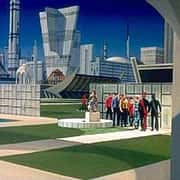
A Taste of Armageddon
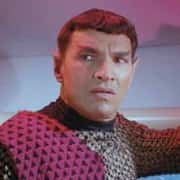
Balance of Terror
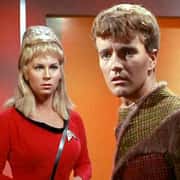
Court Martial
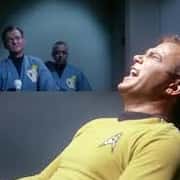
Dagger of the Mind

Errand of Mercy
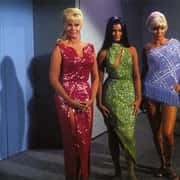
Mudd's Women
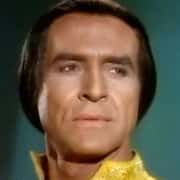
The Alternative Factor
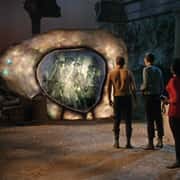
The City on the Edge of Forever

The Conscience of the King

The Corbomite Maneuver
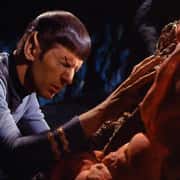
The Devil in the Dark
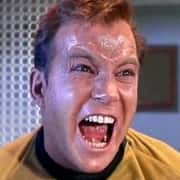
The Enemy Within
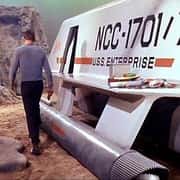
The Galileo Seven
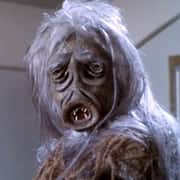
The Man Trap
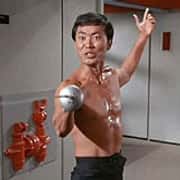
The Naked Time
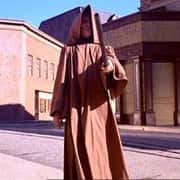
The Return of the Archons
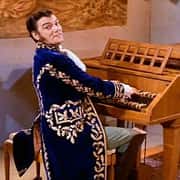
The Squire of Gothos
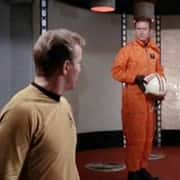
Tomorrow Is Yesterday
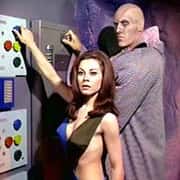
What Are Little Girls Made Of?
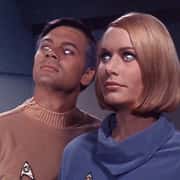
Where No Man Has Gone Before
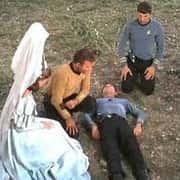
Shore Leave
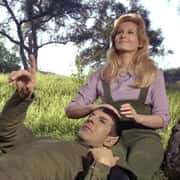
This Side of Paradise
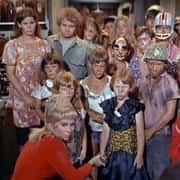
- Star Trek: The Original Series (NBC)
- Star Trek Franchise
- Entertainment
- Police & Law Enforcement
- Star Trek Universe
- Graveyard Shift
- Unspeakable Times
- Weird History
- Watchworthy
- Adventure Entertainment
- TV Episodes


Midnite Reviews
Detailed analysis of classic sci-fi movies and tv shows, star trek episode 79: turnabout intruder.
Technical Specs
Director: Herb Wallerstein
Writer: Arthur H. Singer
Cast: William Shatner, Leonard Nimoy, DeForest Kelley, Sandra Smith, Harry Landers, James Doohan, George Takei, Walter Koenig, Majel Barrett, Barbara Baldavin, David L. Ross, and John Boyer
Composer: Fred Steiner
Air Date: 6/3/1969
Stardate: 5928.5
Production #: 60043-79

The unofficial series finale, “Turnabout Intruder” provides a disappointing conclusion to the (live-action) television adventures of Kirk and company. Star Trek enthusiasts may nevertheless enjoy this effort given the inspiring manner with which Spock, McCoy, and many others react when their captain’s body is usurped by a deranged imposter.

Concluding Comments
“Turnabout Intruder” bids a bizarre farewell to one of the greatest and most influential science fiction series ever produced. That being said, a poignant character examination may appeal to Star Trek fans willing to overlook the politically incorrect themes underlying Arthur H. Singer’s narrative.
Overall Quality: 7/10
If you enjoyed this post, please click the follow button or enter your email address in the subscription box to stay tuned for more updates.
Please note: Comments that are malicious, offensive, or excessively profane will be removed. Off-topic messages belong in the About section.
One thought on “ Star Trek Episode 79: Turnabout Intruder ”
The last one. :-/
My brother never liked this one much..
Comments are closed.
Star Trek Episodes That Will Make You Love James T. Kirk
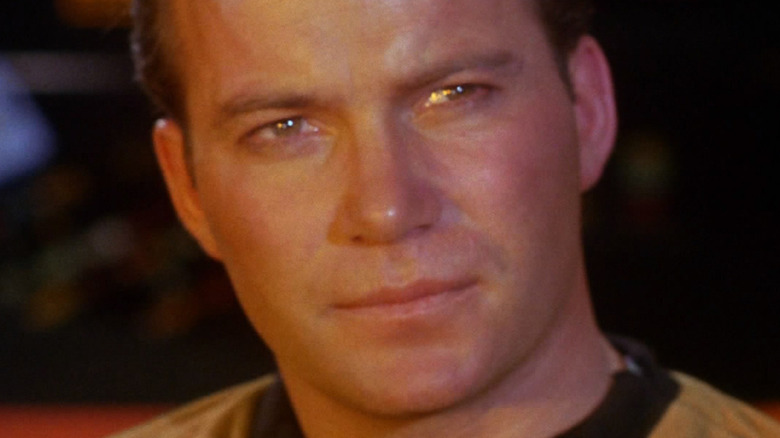
"Star Trek: Strange New Worlds," the new hit series on Paramount+, revisits the five year mission of the USS Enterprise as commanded by Captain Christopher Pike, played by the absolutely lovable Anson Mount. Pike has endeared himself to fans by being the space dad of our dreams, a sweetheart who leads the Enterprise family by consensus and is always ready to support his crew with a kind ear and a bowl of pasta mama. So, when his successor, James T. Kirk, makes a surprise guest appearance on the first season finale, "A Quality of Mercy," Kirk comes across a bit cold and stiff by comparison.
While new Kirk actor Paul Wesley may not have made a strong impression with his version of the character just yet, there are plenty of episodes of "Star Trek: The Original Series" that can serve as a great introduction to space sci-fi's most famous captain. While certainly a product of the time in which he was created, Jim Kirk as originally portrayed by William Shatner is a remarkable and textured leading man, as capable of warmth and compassion as Pike but also burdened with the expectations of stern, authoritative 1960s masculinity. With Pike now existing as a reimagined, refurbished midcentury man, Kirk becomes all the more fascinating by comparison.
Here's a selection of standout episodes that demonstrate what made James T. Kirk such a beloved and memorable character, and why he's still some Trekkies' favorite captain of the Enterprise.
Where No Man Has Gone Before
"Strange New Worlds" picks up the adventures of Captain Pike, Number One, and Lt. Spock, all originally created for the first Star Trek pilot in 1965. When this pilot was rejected and Pike actor Jeffrey Hunter declined to return for a second attempt, Star Trek creator Gene Roddenberry retooled the series around a new character, Captain James T. Kirk, portrayed by Canadian actor William Shatner. While this might be surprising to fans of "Strange New Worlds," Shatner's Kirk is actually a warmer, softer character than Hunter's Pike. The second pilot, "Where No Man Has Gone Before," introduces Kirk not only as a brave Starfleet Captain but as a caring friend, and presents him with a dilemma that pits these obligations against each other.
When we first meet James Kirk, he's not on giving orders on the bridge of the Enterprise, but invested in a friendly three-dimensional chess game against his first officer, Mr. Spock. As the story unfolds, Kirk confronts a challenge to another of his close friendships, when a mysterious space phenomenon endows his mentee Gary Mitchell with godlike powers and an arrogance to match. With Mitchell growing more powerful and more dangerous by the hour, can Kirk find a way to save both the Enterprise and his friend? If not, does he have the strength to do what's necessary?
While the triumvirate of "The Original Series" wouldn't be complete until the addition of Dr. Leonard "Bones" McCoy in the series proper, "Where No Man Has Gone Before" is also a first taste at the famous dynamic between Kirk and Spock, a constant push and pull between instinct and logic that would define both characters for decades to come.
The Corbomite Maneuver
All Starfleet captains, regardless of which series they're from, share certain noble characteristics. They're fearless, curious, and compassionate people, the finest examples of humanity even if they're not actually human themselves. Starfleet may prize truthfulness as its highest value, but there are times when scrupulous honesty can put a Captain or their crew at a disadvantage, and this is where James T. Kirk has the edge. When Kirk can't win the day by playing the rules, he's got no qualms against bending, breaking, or outright changing them to achieve victory.
In "The Corbomite Maneuver," the Enterprise is confronted by a massive alien craft whose captain, Balok, threatens to destroy them for accidentally intruding on his territory. Kirk faces an opponent who refuses to negotiate and has him both outmaneuvered and outgunned. He knows he can't beat Balok at his own game, but rather than admit defeat, he decides to try and bluff his way to victory, turning this from an interstellar chess match into poker. Kirk may not be holding the winning hand, but he doesn't need it so long as he has the confidence and cunning to convince his opponent otherwise.
Kirk shows off this talent for talking his way out of trouble numerous times throughout the series, but no episode better encapsulates his unique daring and charisma than "The Corbomite Maneuver," making it the most essential Kirk episode in all of Star Trek.
Balance of Terror
To fans of "Strange New Worlds," the classic 1966 episode "Balance of Terror" should be instantly familiar. This is the story to which Captain Pike is catapulted through time in the first season finale, "A Quality of Mercy." Here, the USS Enterprise is called to respond to an crisis on an old Earth border outpost, which has been destroyed in a sneak attack by their ancient enemy, the Romulan Empire . Just like in "A Quality of Mercy," the Enterprise must race to catch the cloaked Romulan vessel before it escapes into its home territory, but with Kirk in the captain's chair, the rest of the story plays out a bit differently.
"Balance of Terror" is a great submarine story in space that highlights the senselessness of military conflict, but it's also a great showcase for Jim Kirk as both a commander and as a human being. In times of overwhelming pressure, the crew of the Enterprise looks to their captain for stability and certainty, and it's Kirk's job to give it to them. Of course, deep down, he's as vulnerable and imperfect as everyone else, but he hides his self-doubt from his subordinates in order to protect both his image and their confidence.
The episode's true stroke of genius is when the perspective shifts to show us that the commander of the Romulan vessel is coping with that same stress. While Kirk may be more aggressive than Pike, he's still capable of seeing himself in his opponent. "Balance of Terror" challenges its audience to do the same, and recognize that one's true enemy is rarely the person across from them but the circumstances that put them at odds in the first place.
Though all of Star Trek's captains have seen their share of battle, none are as famous for throwing down as James T. Kirk. Like all good Starfleet officers, his goal is coexistence, not conquest, but he's also the last guy you'd want to challenge to a space battle or an old-fashioned fistfight. Kirk is unrelenting in any contest, armed with a sharp wit, a stiff punch, and a flagrant disregard for his own wardrobe.
Kirk finds himself locked in a number of life-and-death struggles throughout "The Original Series," and the most famous is his duel with the unnamed Gorn captain in the first season episode "Arena." After chasing his warship from the scene of a massacre at a Federation outpost, Kirk is trapped with his reptilian foe on the surface of a barren desert planet. Kirk has no weapons and no hope of defeating the Gorn hand-to-hand, and must use his intelligence and local resources to construct a means of victory. (This episode was released 20 years before the movie "Predator.") Of course, the Gorn of "The Original Series" isn't nearly as cool or scary than the reimagined version confronted by Pike's crew in "Strange New Worlds," but the campy aliens portrayed by stunt actors in rubber suits is part of the charm of classic Trek.
"Arena" may have the setup of a bloody action movie, but this is still Star Trek, and the episode's final message is one of peace and mercy. Kirk is a warrior, no question, but like all Starfleet heroes, he knows war is only ever a last resort.
A Taste of Armageddon
Not all of Jim Kirk's habits have aged terribly well, and one of them is nearly inseparable from the basic structure of "Star Trek." In the classic "Trek" formula, the alien cultures encountered by the Enterprise crew represent contemporary issues faced by the viewing audience, while Kirk and company represent an evolved future humanity that has already grown beyond them. Therefore, it's part of Kirk's narrative purpose to show up on some alien's doorstep and try to explain to them why their society is somehow broken. This often comes across as distastefully self-righteous, especially when he takes the job one step further and unilaterally upends an entire civilization so that they have no choice but to change their ways. No individual has the right to tell millions of people how to live their lives. However, Kirk's one-man revolutions are occasionally very cathartic as a power fantasy for viewers.
Nowhere is that more true than in "A Taste of Armageddon," in which Kirk and the Enterprise are declared as casualties in a simulated war between the planets Eminiar VII and Vendikar. The two worlds have been at war for centuries, so long that it's become a routine part of life. Rather than seek an end to their conflict, they've merely made it as convenient as possible, determining the death tolls of virtual bombings by computer and then ordering the citizens who have been "killed" to report to suicide booths. Kirk refuses to surrender his crew and decides to put a stop to this sanitized bloodbath once and for all, forcing Eminiar VII and Vendikar to choose between crafting a real peace or waging a real war.
Kirk may overstretch his authority, but he's never content to allow evil to triumph through his inaction.
The City on the Edge of Forever
If you mainly know Jim Kirk through cultural osmosis (or from the J.J. Abrams reboot), then you're likely aware of his reputation as a horndog. While it's true that Kirk has a lot of one-episode love interests over the course of the show's three seasons, the perception that he's led by his hormones has been greatly exaggerated through decades of parody and imitation. His behavior towards women doesn't always hold up terribly well through a modern lens — just as plenty of "romantic" storylines from the past can read as subtly or overtly predatory — but his fast and brief entanglements are a product of the show's format, not the character's intentions.
Jim Kirk might never find a partner who he loves more than the Enterprise (unless you count Spock), but there's one woman in particular who truly steals his heart. In the acclaimed episode "The City on the Edge of Forever," Kirk, Spock, and McCoy are thrown back in time to the early 1930s, where Jim meets a visionary social worker named Edith Keeler. Jim falls deeply in love with Edith for her generosity and brilliance, but destiny has other plans for both of them.
The romance with Edith allows us a glimpse at the quiet and tender side of Jim Kirk, the part of him that might have been satisfied living a more normal life away from the grave responsibilities of command. But, it's those very same responsibilities that keep Jim and Edith apart, as their respective roles in the future make their continued relationship impossible.
Mr. Spock may have gone on to feature in many stories without Captain Kirk — alongside the likes of Jean-Luc Picard, Michael Burnham, and Christopher Pike — but it's still very hard to imagine Captain Kirk without Mr. Spock. On "The Original Series," Kirk, Spock, and McCoy essentially act as three parts of a single character, with Spock representing pure logic, McCoy representing raw emotion, and Kirk representing the reason necessary to reconcile the two. The friendship between them is the beating heart of the show, and Kirk's loyalty to Spock is one of his most endearing characteristics as well as the source of his most shining moments.
In "Amok Time," Spock is struck by pon farr, the irresistible urge to return home to Vulcan to mate with his estranged wife, T'Pring. Since pon farr can be fatal if not satisfied, Kirk violates direct orders from Starfleet to rush Spock back to Vulcan. The situation gets more complicated when T'Pring announces that she's selected a new mate: Kirk. This twist leads the friends into mortal ritual combat, during which Kirk must find a way to save both himself and his friend, whose condition has driven him mad beyond reason.
Kirk may not let most of his crew as close to his heart as Christopher Pike does on "Strange New Worlds," but he'll still go to any lengths to protect them, and that goes double for Spock. Their bond is unbreakable by time or death, and is part of what makes them two of the greatest television characters of all time.
The Trouble with Tribbles
There's no denying that Jim Kirk is arrogant and self-important, and that this can be an obstacle to enjoying him as a character. So, it's no surprise that one of the most famous and beloved episodes of "Star Trek: The Original Series" shows Kirk being knocked down a peg and thrust into a truly embarrassing situation. In "The Trouble with Tribbles," the Enterprise is assigned to protect a crate full of grain bound for a disputed planet, a task for which Kirk believes he is utterly overqualified. The mission becomes further complicated when both the Enterprise and the nearby space station become infested with adorable, rapidly-multiplying critters called Tribbles. Add in a dust-up with the Klingons and the incessant complaining of an agricultural bureaucrat, and you're looking at James T. Kirk's most agonizing and humiliating workweek ever.
"The Trouble with Tribbles" is the first attempt to twist "Star Trek" into the shape of a workplace comedy, a genre in which many subsequent series have dabbled since. (The animated "Star Trek: Lower Decks" is basically "The Trouble with Tribbles: The Series.") Here, Kirk is a put-upon middle manager presiding over a fiasco that's outside his interests and beyond his control. Rarely have Kirk and company been more relatable than here, far from the high stakes and moral dilemmas of most episodes. It sucks, but they're trying their best to enjoy themselves at work.
It helps that William Shatner and the entire cast are in rare form in this episode, clearly relishing the chance to show off their versatility as comic actors. The success of "The Trouble with Tribbles" would assure that the franchise would afford them more such opportunities in the future, to varying degrees of success.
A Piece of the Action
If "The Trouble with Tribbles" is a story in which Captain Kirk is forced to take a silly situation seriously, "A Piece of the Action" lets Kirk — not just William Shatner, but Kirk himself — dive headfirst into the silliness. In this episode, the Enterprise makes contact with an alien planet and discovers that, thanks to the accidental influence of an Earth ship a century prior, its society has modeled itself into a caricature of 1920s Gangland Chicago. The people of Sigma Iotia II wear pinstripe suits, carry Tommy guns, and speak in the cartoonish slang of early James Cagney talkies.
Where Kirk spends "The Trouble with Tribbles" under the tiresome supervision of Federation bureaucrats, "A Piece of the Action" lets him tackle this bizarre scenario as he pleases, and he chooses to simply go with it. By the end of the episode, Kirk is dressed up in a period outfit and doing a funny voice, and he's got Spock doing it, too. While his strategy for repairing the cultural contamination of Sigma Iotia II once again sees him overreaching his authority by light years, it's undeniably fun to watch him confront an absurd problem by equally absurd means.
Moreover, "A Piece of the Action" represents a quality of the original "Star Trek" that so many of its descendants have struggled to recapture: It lets you have fun with the characters. "Star Trek" is and should be serious business a lot of the time, but ending the occasional episode on a punchline and a freeze frame can be a breath of fresh air that brings the audience a little closer to the characters.
Return to Tomorrow
If you're familiar with "Return to Tomorrow," you might find it a surprising inclusion on a list of episodes about Captain Kirk. After all, Jim spends much of the hour possessed by the spirit of another life-form, the ancient alien Sargon. In this story, Kirk, Spock, and astro-biologist Lt. Commander Ann Mulhall agree to allow three non-corporeal beings to inhabit their bodies while they construct their new, permanent robot forms. The plan goes awry, of course, putting all three officers' lives in jeopardy and leaving Jim Kirk's mind trapped in a glowing plastic sphere for a solid twenty minutes.
However, it's what Kirk does in the first half of the episode that solidifies it as one of his best, as he delivers a passionate speech about the value of embracing danger for the sake of discovery. Lending a helping hand to three stranded immortals has a value beyond simple decency, as the androids that Sargon plans to create represent a massive scientific breakthrough for the Federation. Kirk argues that this is exactly the sort of danger that he and all of Starfleet exists to face.
"Risk is our business," Kirk concludes. "That's what this starship is all about. That's why we're aboard her."
In the space of 100 seconds, Captain Kirk succinctly summarizes the spirit of adventure and curiosity that drives all of "Star Trek," a rousing call to action who all who are willing to take a chance on a better tomorrow.
Star Trek II: The Wrath of Khan
While his 79 episodes of "Star Trek: The Original Series" allowed audiences to explore multiple facets of Captain James T. Kirk, the conventions of 1960s television made it impossible for him to demonstrate any real growth. Kirk is always the same man at the beginning of every episode of "Star Trek," no matter what happened the week before. It wasn't until the feature film series, which began a decade after the TV show was canceled, that Kirk was afforded the luxury of deconstruction and evolution.
1982's "Star Trek II: The Wrath of Khan" finds a now Admiral Kirk suffering from a mid-life crisis. "The Wrath of Khan" takes each criticism one might have of Kirk on "The Original Series" and turns them into a new challenge. Because he's routinely cheated death, he doesn't know how to face it. Because he's married to his work, he's never met his son. And because he rides off into the sunset after each adventure without ever looking back, he's left a huge mess in his wake. When Khan, the antagonist from a classic episode that Kirk has all but forgotten, comes looking for revenge, Kirk must face the dire consequences of his arrogance.
Even 40 years later, "Wrath of Khan" remains the single essential film in the entire Star Trek franchise, not only for being a rousing adventure in its own right, but for humanizing one of television's most legendary characters better than any story before or since.
Star Trek IV: The Voyage Home
After three more sober installments of the feature film series, "Star Trek IV: The Voyage Home" was the first to deliberately engage in the light-hearted fun of the classic show's comedy episodes. The story sends Kirk, Spock, and company to the contemporary setting of 1984 San Francisco to retrieve a pair of humpback whales and bring them forward to save the future. In contrast to the rest of the films in the franchise, "The Voyage Home" has no deliberate violence, only an urgent mission of peace and a lot of silly, fish-out-of-water comedy.
William Shatner and Leonard Nimoy spend much of the film as a vaudeville-style double act, with Kirk trying to fake his way though the modern world and Spock making zero effort to blend in. This is Shatner and Nimoy at their most adorable and entertaining, playing off of each other with an ease that can only be achieved with years of experience working together. Shatner also enjoys terrific chemistry with Catherine Hicks as marine biologist Dr. Gillian Taylor, portraying Kirk at his sweetest and most charming.
If "Wrath of Khan" is the film that deconstructs James T. Kirk, then "The Voyage Home" is the film that puts him back together, restoring the sense of joy and adventure that has made him a beloved icon for over 50 years.
79 Years Ago, A Classic Star Trek Villain Was Created — Before Star Trek Even Existed
The Gorn are back in the Strange New Worlds Season 2 finale, but their origins go all the way back to 1944.
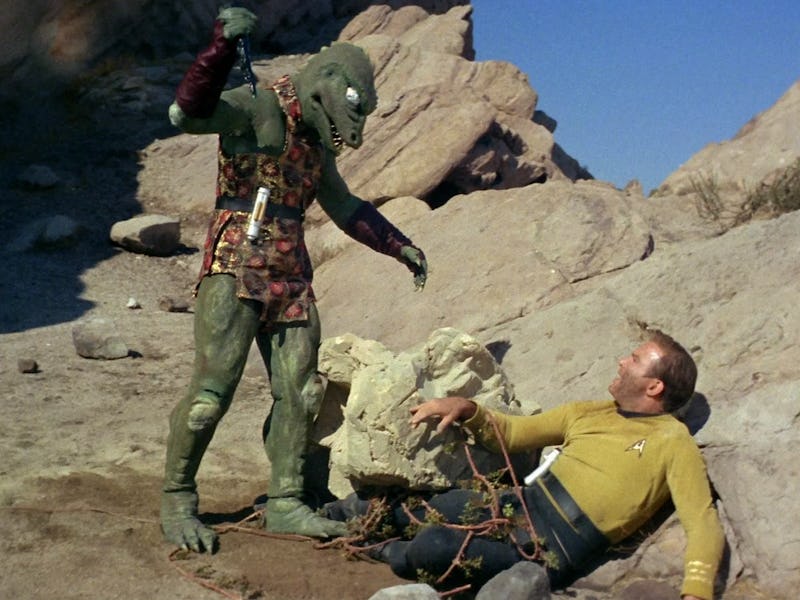
Everyone knows Captain Kirk first fought the Gorn in the classic Star Trek episode “Arena,” which aired on January 19, 1967. But when you do a deep dive into the origins of this episode, the bizarre truth is “Arena” and the Gorn predate the TV show. As Strange New Worlds continues to reinvent the Gorn and put the canon of “Arena” in a new light, it’s time to revisit a story that existed two decades before Star Trek even existed.
The storyline of “Arena” is familiar even to casual sci-fi fans: after chasing a Gorn spaceship that attacked a human colony, Kirk and the Gorn Captain are whisked to a “suitably prepared world” by a super-powered alien species called The Metrons. They want Kirk and the Gorn to duke it out hand-to-hand and settle their conflict forever. Kirk eventually cobbles together a working cannon using DIY gunpowder and wounds the Gorn. However, Kirk famously refuses to deliver a fatal blow, professing his desire to let his enemy live. This gesture of mercy makes the Metrons believe humans aren’t so bad, and everyone lives happily ever after.
This endpoint with the Gorn is in the future for Pike and his Strange New Worlds crew, but the sci-fi concept of “Arena” actually predates Star Trek . In 1967, Original Series producer Gene Coon shared writing credit with author Fredric Brown on “Arena,” because Coon accidentally ripped Brown off when he wrote the script.
“Arena” Before Star Trek
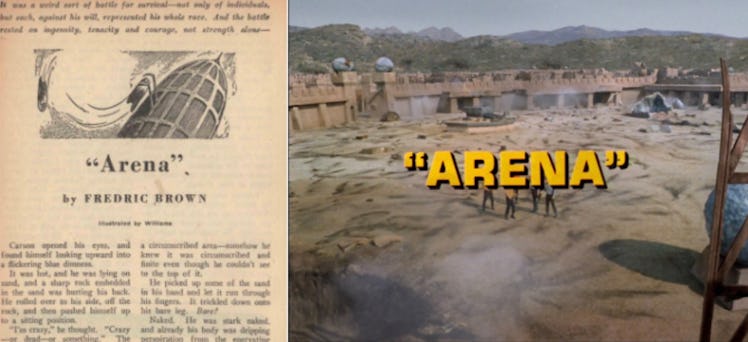
Fredric Brown’s “Arena” in 1944 and the Star Trek “Arena” in 1967.
Because Gene L. Coon was essentially what we’d now call a showrunner, he often wrote scripts when the show ran low on new stories. “Arena” was an example of a script Coon wrote very quickly to get Star Trek back on track. When script researcher Joan Pearce gave “Arena” its legal review, she noticed it was very similar to a 1944 short story by Fredric Brown, also called “Arena.” Coon accidentally plagiarized chunks of Brown’s story, so Brown was offered a story credit.
Just how similar are the stories? In the June 1944 issue of Astounding , “Arena” opens with a space pilot named Carson who’s found himself on an alien world covered in blue sand. Carson is naked and has to quickly figure out how to survive, all while battling an alien from a group called the Outsiders. Carson’s adversary is something he calls a Roller because it’s a metal ball with tentacles. At one point, the Roller throws a lizard creature at Carson, which makes the story seem similar to Trek’s “Arena.”

An interior illustration for “Arena” in Astounding.
If you squint, Carson is similar to Captain Kirk, and his ingenuity and ability to adapt allows him to defeat the Roller and the Outsiders. In the 1940s, ’50s, and ’60s, this type of story was common in Astounding . Influential editor John Campbell favored stories in which men defeated impossible odds simply because they were smarter and stronger. Had Campbell been in charge of shepherding the Trek version of “Arena,” you can bet it would have ended with Kirk slaying the Gorn, not sparing him.
Gorn, but not forgotten
While the original “Arena” has a bit of 1940s machismo, it’s a fun, fascinating read outside of its relationship to the much more famous Star Trek episode . Brown’s action is quick, the world-building is nimble, and there’s something legitimately gripping about the story that the Trek “Arena” lacks.
In Brown’s “Arena,” you’ll find yourself frightened by the fight-or-flight reality of Carson’s battle with the Roller. When we watch the 1967 Star Trek “Arena” today, we’re more impressed with the philosophy than the action. While the design of Way Chang’s Gorn costume is amazing, it’s not like anyone can really watch Kirk fight the Gorn with a straight face. The best way to enjoy “Arena” is to enjoy the brazenness of the themes that classic Star Trek often presented. The best Original Series scripts are like this; they feel like pulpy sci-fi stories from decades prior, but with a humanist twist.
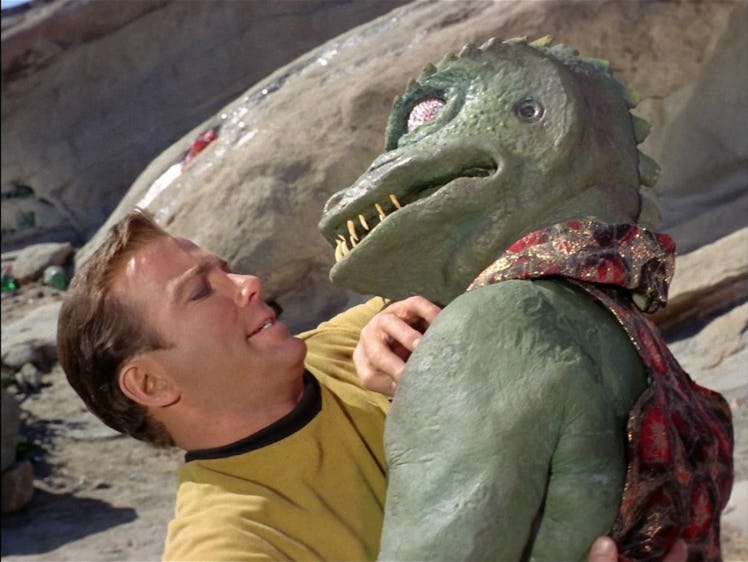
Kirk versus the Gorn in “Arena.”
In the 1944 “Arena,” Carson brutally stabs the Roller, and we learn this was kind of a Matrix-ish battle in which the physical combat was a metaphysical representation of an entire conflict between space fleets. Carson later awakens and realizes his actions have caused the entire Outsider fleet to be turned to dust.
The stakes in Trek’s “Arena” are way more literal, as the Metrons have told Kirk and the Gorn that the outcome of their fight will resolve the overall conflict between their people. What makes “Arena” so special is that it’s an episode about a physical fight that ends with Kirk laying down his weapons. And so, while it has the trappings of the 1944 “Arena,” its message is the opposite.
In a way, the conflict with the Gorn on Strange New Worlds is closer to the 1944 “Arena” than the Star Trek “Arena.” Strange New Worlds presents a battle with the Gorn that feels dangerous and frightening, and at this point in the Trek timeline, the idea of showing the Gorn mercy feels foolish. When Spock and Chapel fight a Gorn in zero gravity amid the wreckage of the USS Cayuga , they’re not thinking about making peace with it. Spock taking out the Gorn in “Hegemony” makes him more like Carson than Kirk.
In the final pages of James Blish’s novelization of Star Trek’s “Arena” (a third version of the story!) Kirk feels like he’s not ready to talk to Spock about his experience fighting the Gorn. In all three versions, the hero keeps some of the experience to himself. In the 1944 version, Carson stays quiet out of self-preservation. But for Kirk, there’s a sense of sanctification, of knowing he did the right thing and not needing to brag about it. And in that small, specific way, the Trek “Arena” is still the best version of the story, because it does something sci-fi couldn’t in 1944; let the hero be kind and humble.

This article was originally published on Aug. 12, 2023

Star Trek: Lower Decks is ending, but at least Strange New Worlds will journey on
Star Trek: Lower Decks
Star Trek: Lower Decks is, depending on how you look at it, the most ambitious TV show that Star Trek has ever done. Informed by an incredibly deep love for (and knowledge of) the vast universe of Star Trek lore, the animated series proves that “Star Trek comedy” is something that can actually exist (beyond episodes of Deep Space Nine where Quark runs around in a dress, anyways), showing the up-until-now only ambiguously demonstrated fact that it’s possible for Trek to have a genuine sense of humor about itself. And now, sadly, it’s ending, as Variety reports that the show’s upcoming fifth season will be its last.
Created by Rick & Morty writer Mike McMahan, Lower Decks last aired new episodes last October, continuing to tell the story of the U.S.S. Cerritos, one of those Starfleet ships that’s usually doing the other jobs while vessels like the Enterprise are out saving the universe. The series stars Tawny Newsome, Jack Quaid, Noël Wells, and Eugene Cordero, playing four lower-ranking members of the Cerritos crew who end up bonding as friends. The show’s fifth (and now final) season is expected to air before the end of 2024.
It’s not all grim news in Star Trek land, though: Lower Decks’ Paramount+ sibling, Strange New Worlds , has been renewed for a fourth season, ensuring that the other most joyful Star Trek show currently running will get at least one more run of shows. Starring Anson Mount as Trek pilot character Christopher Pike, and Ethan Peck as a younger version of Spock, the show is a deliberate throwback to the early days of the franchise. It’s also a genuine blast: Quick-moving, smart, and fun, it’s the kind of show that can, say, accommodate a bona fide crossover with Lower Decks , showing that the two series’ loving but reverential attitudes toward Trek canon arepleasantly simpatico.
For the latest news, Facebook , Twitter and Instagram .
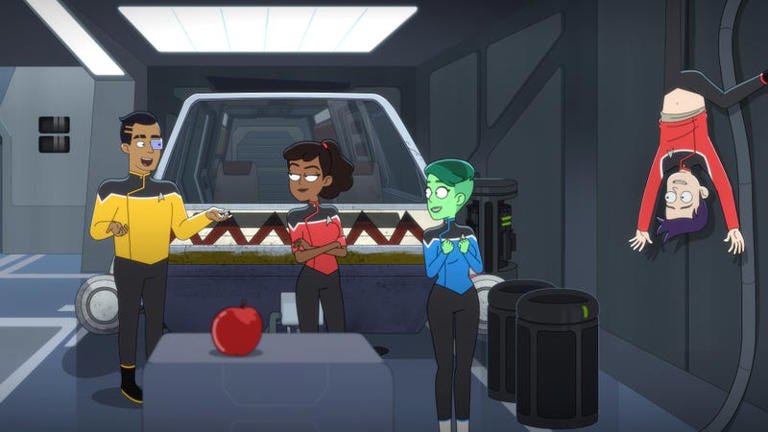
Screen Rant
Star trek: discovery season 5 episode 4 ending explained.
Moll and L'ak send Burnham, Rayner and Stamets hurtling through their past, present, and future as Star Trek: Discovery's treasure hunt continues.
WARNING: Contains SPOILERS for Star Trek: Discovery, season 5, episode 4, "Face the Strange".
- Captain Burnham and Commander Rayner navigate through time to stop the time bug, showcasing their growth and teamwork.
- A Voyager connection reveals the menacing Krenim "time bug" and its catastrophic effects on the USS Discovery's crew and timeline.
- Burnham reflects on her journey as she faces challenges from her past while navigating through alternate futures in "Face the Strange."
Captain Michael Burnham (Sonequa Martin-Green) and Commander Rayner (Callum Keith Rennie) find themselves hurtling through the USS Discovery's past, present, and future in Star Trek: Discovery season 5, episode 4, "Face the Strange". Written by Sean Cochran and directed by Lee Rose, "Face the Strange" demonstrates how far Burnham and Commander Paul Stamets (Anthony Rapp) have come since Discovery season 1 . It's also a chance for Burnham and her new Number One, Rayner, to finally work as a team, as they literally race against time to get Discovery 's hunt for the Progenitors' treasure back on track.
"Face the Strange" reveals that Moll (Eve Harlow) planted a Krenim " time bug " on Ensign Adira Tal (Blu del Barrio) at the end of Star Trek: Discovery season 5, episode 3 . Having worked its way into the USS Discovery's systems, the time bug traps the crew in their own history, randomly cycling the ship through the past, present, and future, freeing Moll and L'ak to retrieve the next clue . Burnham, Rayner, and Stamets are unaffected and work together to get the USS Discovery back to the 32nd century in time to stop Moll and L'ak from completing the next step in Discovery 's treasure hunt.
Star Trek: Discovery Season 5 Returning Cast & New Character Guide
How burnham, rayner & stamets beat star trek: discovery's time bug explained.
The time bug in Star Trek: Discovery is a particularly nasty piece of temporal technology, which proves hard for Burnham, Rayner, and Stamets to beat. Their first attempt to nullify the device fails, because time inside the surrounding field is moving at a rapid pace. Anything that enters the field to remove the time bug will cease to exist within seconds , forcing Stamets to come up with a far riskier strategy.
the warp bubble is what protects the crews of Star Trek 's starships from the effects of relativity...
The trick to beating the time bug is to reduce the flow of time in the surrounding field , but to do that, the USS Discovery has to break the warp bubble and throw relativity out of sync. As they travel faster than the speed of light, the warp bubble is what protects the crews of Star Trek 's starships from the effects of relativity . Abruptly breaking the warp bubble means that the time bug has less time to readjust to relative time outside the USS Discovery. This would weaken the surrounding field for long enough for Rayner to remove the time bug.
The main issue with Commander Paul Stamets ' plan was that the time-traveling trio were in the worst possible time period when it comes to Burnham's standing aboard the USS Discovery. The time bug's final cycle took Burnham, Rayner and Stamets to an early point in Star Trek: Discovery season 1, when Michael was still seen as a dangerous mutineer. For Stamets' plan to succeed, Burnham had to make her way to the bridge, fight and incapacitate her younger self, then successfully convinced the bridge crew to follow the orders of their future captain .
A line of dialog places these scenes at some point between episodes 3 and 4 of Star Trek: Discovery season 1, as Commander Landry is said to still be alive.
Star Trek: Discovery's Time Bug Is A Voyager Connection
Commander Rayner reveals that the time bug is a " Krenim chronophage " left over from Star Trek 's Temporal Wars . The Krenim are a technologically advanced species first introduced in Star Trek: Voyager 's season 4 two-parter, "Year of Hell." The USS Voyager's first encounter with the Krenim went so badly wrong that it created an alternate timeline that descimated the majority of the ship's crew .
This forced Captain Kathryn Janeway (Kate Mulgrew) to make the ultimate sacrifice to restore history. Hailing from the Delta Quadrant, the Krenim had devastating temporal weapons that were capable of removing entire species from existence. While Star Trek: Discovery 's time bug is much smaller, it can still have a devastating impact on its victims , as shown by what will happen if Moll and L'ak get their hands on the Progenitors' technology.
Voyager Is Why Star Trek Is Replacing Discovery’s Spore Drive
Burnham and stamets’ time travel shows how much they've changed on star trek: discovery.
Burnham and Stamets are forced to relive some painful moments from their pasts, but these incidents remind viewers just how far the Star Trek: Discovery characters have come. Stamets hilariously draws on his angrier, snarkier past self from Discovery season 1, which helps him swiftly empty engineering. It's a fun callback to the person that Stamets used to be, before his tardigrade DNA made him more mellow, making him a better husband to Dr. Hugh Culber (Wilson Cruz) and a father figure to Adira. However, Stamets' tartigrade DNA has one drawback; he still experiences the pain of being impaled during the Battle of Control .
Burnham also gets a welcome reminder of how far she's come, courtesy of the Krenim time bug and some words of encouragement from Rayner. Rayner reminds her that she never gave up on her path from prisoner to starship captain , and so she shouldn't give up when faced with their bleak alternate future. Captain Burnham stirring the crew of the USS Discovery on the same day that her younger self came aboard as a prisoner is a strong affirmation of her journey between Star Trek: Discovery seasons 1 and 5.
Burnham's awkwardness around Book seems more rooted in her suppressing her attraction than trying not to change the future
Burnham also gets a chance to reflect on her relationship with Booker (David Ajala), when she meets his past self, fresh out of the shower. Burnham's awkwardness around Book seems more rooted in her suppressing her attraction than trying not to change the future. It's another hint that Burnham and Book's Star Trek: Discovery love story isn't over yet.
Star Trek: Discovery Finally Solves Its Biggest Short Trek Mystery
In the fan-favorite Short Trek , a soldier, Craft (Aldis Hodge) was picked up by the USS Discovery after his escape pod had drifted through space for a month. Craft formed a bond with Zora (Annabelle Wallis) who had been left behind by the USS Discovery a thousand years earlier. For years, fans speculated over where "Calypso" fitted into the Star Trek: Discovery timeline, something that the showrunners promised would come further down the line. Now, Discovery season 5, episode 5 "Face the Strange" provides the answer. "Calypso" takes place in an alternate version of the 42nd century, a thousand years after the Progenitors' technology had fallen into the wrong hands .
Star Trek Needs To Bring Back Short Treks
Burnham and Rayner's jump into the future reveals that Star Trek: Deep Space Nine 's Breen got hold of the Progenitors' technology and used it to destroy Starfleet and the Federation. As the USS Discovery hangs in space, Burnham and Rayner look out at a devastated Federation Headquarters, as Zora pleads with them to change the future. The use of a calypso version of Doris Day's "Que Sera Sera" is Star Trek: Discovery 's subtle confirmation that it's this catastrophe that left Zora abandoned for a thousand years before Star Trek: Short Treks .
Did Star Trek: Discovery Retcon Airiam’s Season 2 Sacrifice?
While convincing the crew of the USS Discovery to help with her plan to return to the 32nd century, Captain Burnham reveals that Lt. Commander Airiam (Hannah Cheeseman) will sacrifice her life to save her crew mates. Airiam accepts Burnham's future knowledge, because she knows that she would sacrifice her life in those circumstances. Airiam's knowledge of her own future is what eventually convinces her to follow Burnham's orders by breaking the warp bubble . In normal circumstances, knowledge given to her by a time-traveling Burnham would mean that Airiam will sacrifice her life in Star Trek: Discovery season 2 because she knows she has to.
However, due to the nature of the Krenim time bug, and Stamets' solution, Burnham telling Airiam about her tragic future doesn't retcon Star Trek: Discovery season 2. By removing the time bug before the next loop, Burnham, Rayner and Stamets negate everything that they did, meaning that, for example, young Burnham won't remember her fight with her future self. This means that Airiam will still make the decision to sacrifice her life in Discovery season 2, independently, not because she was inspired to do so by Captain Burnham .
Rayner Is Finally “Connecting” With USS Discovery's Crew
Callum Keith Rennie's Commander Rayner continues to go from strength to strength in Star Trek: Discovery season 5. Following Burnham's orders to " connect " with the Discovery crew in the previous episode, Rayner demonstrates how much he was paying attention during his brisk one-on-one meetings. Not only does Rayner give Burnham the encouragement she needs not to give up, he and Stamets appear to bond over being " old dogs " who specialize in " gruff candor ".
Why I'm On Rayner's Side In Star Trek: Discovery Season 5
Rayner's most notable connection is with Gen Rhys, whose theory about Moll and L'ak he brusquely dismisses at the start of the episode . Thrown back into time when Rhys was just a lieutenant, Rayner gets through to the young officer by bonding with him over a love of Constitution-class starships. Rayner's connection with Rhys is enough to convince the officer to lower his phaser and let him and Stamets proceed with their plan. Back in the 32nd century, Rayner finally acknowledges the value of Rhys' tactical assessment that Moll and L'ak would just follow Discovery to the next clue .
Rayner also tells Rhys that he's lost his family, teasing more about the new Star Trek: Discovery character's backstory.
Where Have Moll And L’ak Gone In Star Trek: Discovery Season 5, Episode 5?
The Krenim time bug caused the USS Discovery crew to lose six hours to Moll and L'ak in Star Trek: Discovery season 5, episode 4 . Returned to Tzenkethi space in the 32nd century, Lt. Commander Joann Owosekun (Oyin Oladejo) picks up Moll and L'ak's trail, but it quickly stops dead , meaning that they've seemingly disappeared. A starship trail that drops dead just before an episode called "Mirrors" would certainly play into Star Trek: Discovery season 5's Mirror Universe theory . Perhaps the reason that Moll and L'ak's trail stops dead is because they've phased into another reality altogether.
It's possible that Moll and L'ak picked up more than a Romulan puzzle box...
Alternatively, given Star Trek: Discovery season 5's Romulan connection, their ship could have used an interphasic cloak, first seen in the Star Trek: The Next Generation episode "The Next Phase". Interphasic cloaking technology effectively turned Lt. Geordi La Forge (LeVar Burton) and Ensign Ro Laren (Michelle Forbes) into ghosts, unable to be seen by their crewmates. It's possible, therefore, that Moll and L'ak picked up more than a Romulan puzzle box in Star Trek: Discovery 's season 5 premiere, meaning that they could have a considerable tactical advantage over Burnham and the crew in the next stage of the treasure hunt.
Star Trek: Discovery streams Thursdays on Paramount+.
- More to Explore
- Series & Movies
Published Apr 12, 2024
Star Trek: Lower Decks to Conclude with Fifth and Final Season
The hit original animated series will arrive later this fall.
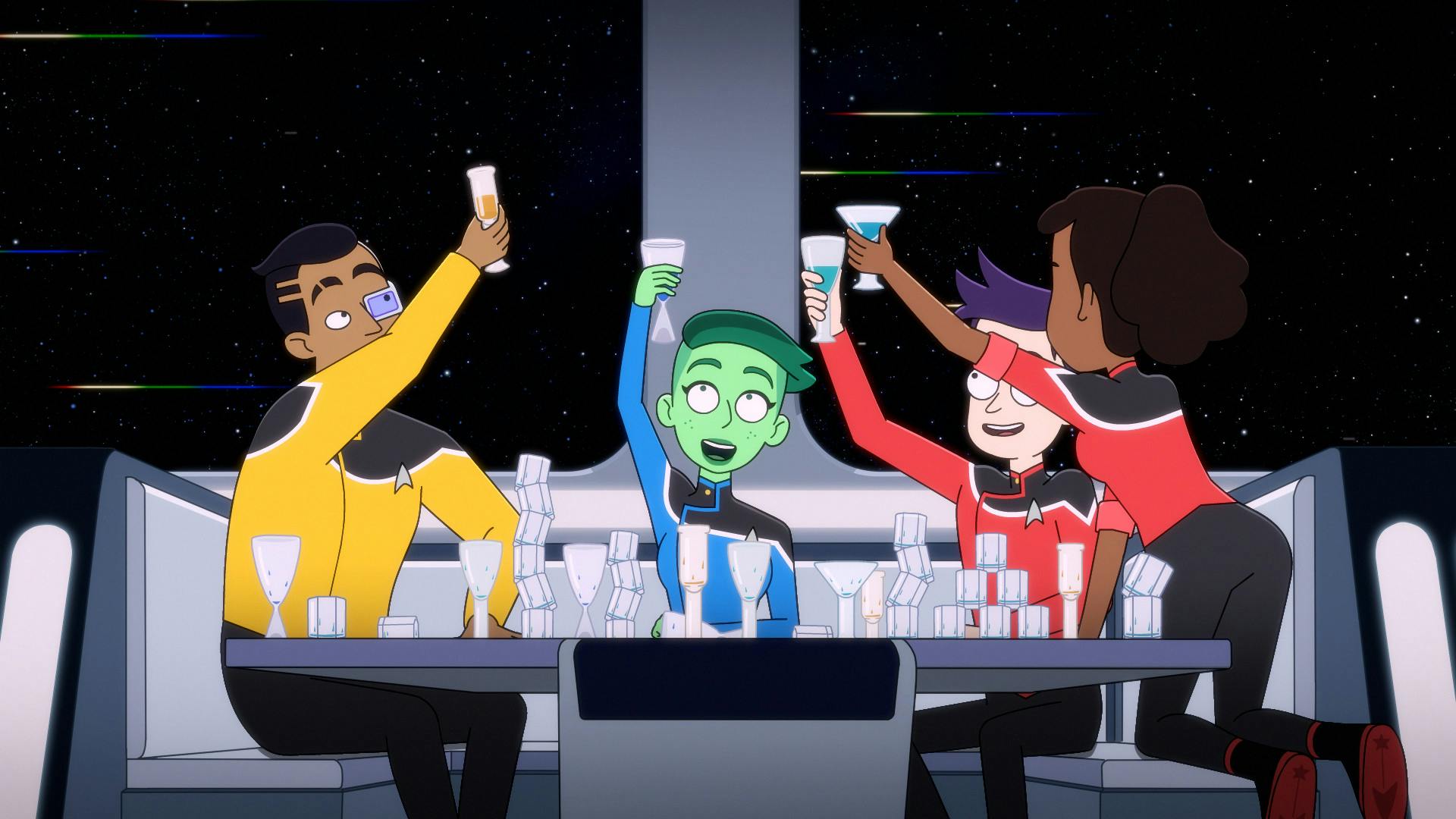
StarTrek.com
Star Trek: Lower Decks will conclude later this fall with its fifth and final season.
Series creator Mike McMahan and executive producer Alex Kurtzman confirm the news in a touching tribute to the series and its fans:
To the fans,
We wanted to let you know that this fall will be the fifth and final season of Star Trek: Lower Decks . While five seasons of any series these days seems like a miracle, it’s no exaggeration to say that every second we've spent making this show has been a dream come true. Our incredible cast, crew and artists have given you everything they have because they love the characters they play, they love the world we've built, and more than anything we all love love love Star Trek . We’re excited for the world to see our hilarious fifth season which we're working on right now, and the good news is that all previous episodes will remain on Paramount+ so there is still so much to look forward to as we celebrate the Cerritos crew with a big send-off.
Finally, thank you for always being so creative and joyful, for filling convention halls and chanting LOWER DECKS!" We remain hopeful that even beyond Season 5, Mariner, Boimler, Tendi, Rutherford and the whole Cerritos crew will live on with new adventures.
LLAP Mike McMahan and Alex Kurtzman
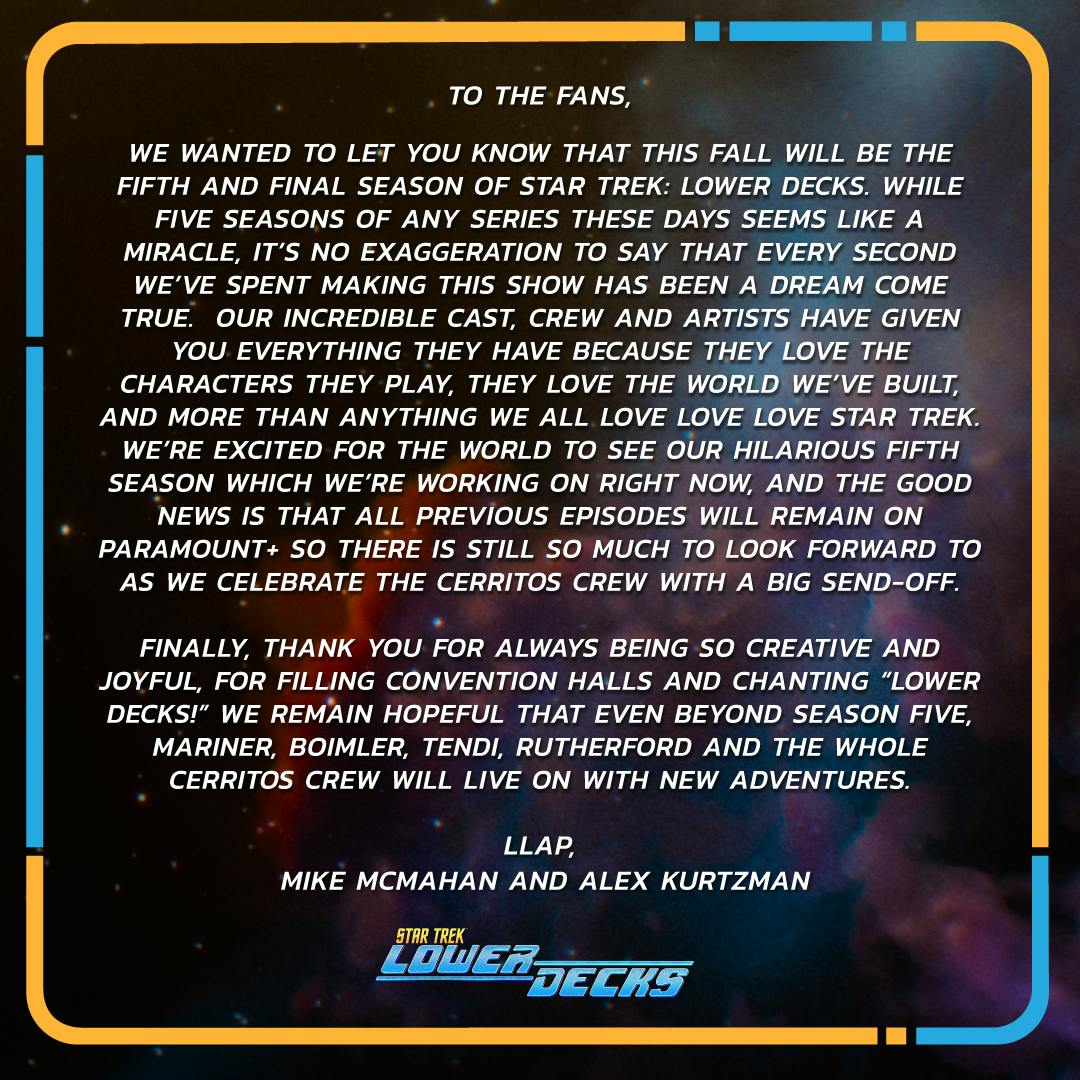
Star Trek: Lower Decks is an animated comedy series that focuses on the support crew serving on one of Starfleet’s least important ships, the U.S.S. Cerritos . The crew residing in the “lower decks” of the U.S.S. Cerritos includes Beckett Mariner, voiced by Tawny Newsome; Brad Boimler, voiced by Jack Quaid; D'Vana Tendi, voiced by Noël Wells; and Sam Rutherford, voiced by Eugene Cordero. The Starfleet characters that comprise the U.S.S. Cerritos ’ Bridge crew include Captain Carol Freeman, voiced by Dawnn Lewis; Commander Jack Ransom, voiced by Jerry O’Connell; and Doctor T’Ana, voiced by Gillian Vigman.
The series is produced by CBS’ Eye Animation Productions, CBS Studios’ animation arm; Secret Hideout; and Roddenberry Entertainment. Executive producers include Alex Kurtzman, Mike McMahan, Aaron Baiers, Rod Roddenberry and Trevor Roth. Titmouse, the Emmy Award-winning independent animation production company, serves as the animation studio for the series.
Get Updates By Email
Star Trek: Lower Decks streams exclusively on Paramount+ in the U.S. and is distributed by Paramount Global Content Distribution. In Canada, it airs on Bell Media’s CTV Sci-Fi Channel. The series will also be available to stream on Paramount+ in the UK, Canada, Latin America, Australia, Italy, France, the Caribbean, Germany, Austria, Switzerland, Ireland and South Korea.

Advertisement
Supported by
Original ‘Star Trek’ Enterprise Model Is Found After Being Missing for Decades
The 33-inch model surfaced on eBay after disappearing around 1979. An auction house is giving it to the son of Gene Roddenberry, the creator of “Star Trek.”
- Share full article

By Emily Schmall
The first model of the U.S.S. Enterprise, the starship that appeared in the opening credits of the original “Star Trek” television series , has been returned to Eugene Roddenberry Jr., the son of the creator of the series, decades after it went missing.
“After a long journey, she’s home,” Mr. Roddenberry wrote on social media on Thursday.
For die-hard Trekkies, the model’s disappearance had become the subject of folklore, so an eBay listing last fall, with a starting bid of $1,000, didn’t go unnoticed.
“Red alert,” someone in an online costume and prop-making forum wrote, linking to the listing.
Mr. Roddenberry’s father, Gene Roddenberry, created the television series, which first aired in 1966 and ran for three seasons. It spawned numerous spinoffs, several films and a franchise that has included conventions and legions of devoted fans with an avid interest in memorabilia.
The seller of the model was bombarded with inquiries and quickly took the listing down.
The seller contacted Heritage Auctions to authenticate it, the auction house’s executive vice president, Joe Maddalena, said on Saturday. As soon as the seller, who said he had found it in a storage unit, brought it to the auction house’s office in Beverly Hills, Calif., Mr. Maddalena said he knew it was real.
“That’s when I reached out to Rod to say, ‘We’ve got this. This is it,’” he said, adding that the model was being transferred to Mr. Roddenberry.
Mr. Roddenberry, who is known as Rod, said on Saturday that he would restore the model and seek to have it displayed in a museum or other institution. He said reclaiming the item had only piqued his interest in the circumstances about its disappearance.
“Whoever borrowed it or misplaced it or lost it, something happened somewhere,” he said. “Where’s it been?”
It was unclear how the model ended up in the storage unit and who had it before its discovery.
The original U.S.S. Enterprise, a 33-inch model, was mostly made of solid wood by Richard C. Datin, a model maker for the Howard Anderson Company, a special-effects company that created the opening credits for some of the 20th century’s biggest TV shows .
An enlarged 11-foot model was used in subsequent “Star Trek” television episodes, and is now part of the permanent collection of the Smithsonian National Air and Space Museum , where it was donated by Paramount Studios in 1974.
Mr. Roddenberry, who said he gave the seller a “reward” for its recovery but did not disclose the terms, assembled a group of “Star Trek” production veterans, model makers and restoration specialists in Beverly Hills to authenticate the find.
The group included a “Star Trek” art supervisor, Michael Okuda, and his wife, Denise, an artist on “Star Trek” television series and films, and Gary Kerr, a “Trek x-pert” who served as technical consultant for the Smithsonian during a 2016 restoration of the 11-foot model.
“We spent at least an hour photographing it, inspecting the paint, inspecting the dirt, looking under the base, the patina on the stem, the grain in the wood,” Mr. Roddenberry said.
“It was a unanimous ‘This is 100 percent the one,’” he said.
Gene Roddenberry, who died in 1991 , kept the original model, which appeared in the show’s opening credits and pilot episode, on his desk.
Mr. Kerr compared the model to 1960s photos he had of the model on Mr. Roddenberry’s desk.
“The wood grain matched exactly, so that was it,” he said on Saturday.
The model went missing after Mr. Roddenberry lent it to the makers of “Star Trek: The Motion Picture,” which was released in 1979, Mr. Maddalena said.
“This is a major discovery,” he said, likening the model to the ruby slippers from “The Wizard of Oz,” a prop that was stolen in 2005 and recovered by the F.B.I. in 2018, and that Heritage Auctions is selling.
While the slippers represent hope, he said, the starship Enterprise model “represents dreams.”
“It’s a portal to what could be,” he said.
Emily Schmall covers breaking news and feature stories and is based in Chicago. More about Emily Schmall
Explore More in TV and Movies
Not sure what to watch next we can help..
As “Sex and the City” became more widely available on Netflix, younger viewers have watched it with a critical eye . But its longtime millennial and Gen X fans can’t quit.
Hoa Xuande had only one Hollywood credit when he was chosen to lead “The Sympathizer,” the starry HBO adaptation of a prize-winning novel. He needed all the encouragement he could get .
Even before his new film “Civil War” was released, the writer-director Alex Garland faced controversy over his vision of a divided America with Texas and California as allies.
Theda Hammel’s directorial debut, “Stress Positions,” a comedy about millennials weathering the early days of the pandemic , will ask audiences to return to a time that many people would rather forget.
If you are overwhelmed by the endless options, don’t despair — we put together the best offerings on Netflix , Max , Disney+ , Amazon Prime and Hulu to make choosing your next binge a little easier.
Sign up for our Watching newsletter to get recommendations on the best films and TV shows to stream and watch, delivered to your inbox.

IMAGES
VIDEO
COMMENTS
The series originally aired from September 1966 through June 1969 on NBC. [1] This is the first television series in the Star Trek franchise, and comprises 79 regular episodes over the series' three seasons, along with the series' original pilot episode, "The Cage". The episodes are listed in order by original air date, [2] which match the ...
Star Trek (1966-1969) TV-PG | 50 min | Action, Adventure, Sci-Fi. A powerful being claiming to be the Greek god Apollo appears and demands that the crew of the Enterprise disembark onto his planet to worship him. Director: Marc Daniels | Stars: William Shatner, Leonard Nimoy, DeForest Kelley, Michael Forest.
'Star Trek' had its share of brilliant influential classics like 'Space Seed,' 'Amok Time,' 'The Corbomite Maneuver,' and 'Charlie X,' but it had its stinkers too so we're ranking all 79 episodes ...
Lists of. Star Trek. episodes. Twelve television series make up the Star Trek franchise: The Original Series, The Animated Series, The Next Generation, Deep Space Nine, Voyager, Enterprise, Discovery, Short Treks, Picard, Lower Decks, Prodigy, and Strange New Worlds. All series in total amount to 903 episodes across 47 seasons of television.
Only 79 episodes were created for the original series, with many gems of sci-fi entertainment (and some, not-so-much). ... The hands-down best episode of "Star Trek" is a riveting tale of time ...
The O.G. (Original Geekdom) of the Star Trek universe remains beloved by many Trek fans over and above any other series and -although I had seen most of these episodes countless times before- in watching them again for this ranking, I understood the love.. Underneath the thriftily constructed sets and bright uniforms designed to highlight this new thing called "color TV," underneath ...
Star Trek: The Original Series (referred to as Star Trek prior to any spin-offs) is the first Star Trek series. The first episode of the show aired on 6 September 1966 on CTV in Canada, followed by a 8 September 1966 airing on NBC in America. ... The series' 79 episodes were digitally remastered with all new visual effects and music. The ...
Star Trek TV series. Star Trek is an American science fiction television series created by Gene Roddenberry that follows the adventures of the starship USS Enterprise (NCC-1701) and its crew. It acquired the retronym of Star Trek: The Original Series ( TOS) to distinguish the show within the media franchise that it began.
79 Episodes. DeForest Kelley. Dr. McCoy 79 Episodes. James Doohan. Scott 79 Episodes. George Takei. Sulu 79 Episodes. Nichelle Nichols ... Star Trek (AKA Star Trek The Original Series, AKA STTOS) is a series that has had a dramatic influence across much of the science fiction genre, and as some have suggested, influenced culture around the ...
The iconic series follows the crew of the starship U.S.S. Enterprise as it completes its missions in space in the 23rd century. Captain James T. Kirk -- along with science officer Spock, ship Dr. "Bones" McCoy, Ensign Pavel Chekov, communications officer Lt. Nyota Uhura, helmsman Lt. Hikaru Sulu, and chief engineer Lt. Cmdr. Montgomery "Scotty ...
The original Star Trek series carries many memorable episodes, but only 21 have made the cut here as the best of the best. ... "You know. 1966? 79 episodes, about 30 good ones," said Philip J. Fry ...
Star Trek: The Original Series - the seaons, the key episodes. Season 1 - In the 1960s, TV was a different beast. Serialization (and thus continuity) was essentially non-existent. Each story plays out over a single episode only (with one exception in three years of Star Trek), thereby not allowing for much character development each season of Star Trek's original run is really barely ...
Watch Star Trek: The Original Series on Amazon. Phew, that was complicated. On with the routes. Route 1: The foundations of Star Trek There are no story arcs in Star Trek (films 2-4 excepted ...
Star Trek: Created by Gene Roddenberry. With Leonard Nimoy, William Shatner, DeForest Kelley, Nichelle Nichols. In the 23rd Century, Captain James T. Kirk and the crew of the U.S.S. Enterprise explore the galaxy and defend the United Federation of Planets.
The Lists. Re-watching (and in some cases, watching) all 700+ episodes of Star Trek took an inordinate amount of time over the past few years, so there's no way I wasn't going to comment on everything, including both spoilers… and a certain amount of irreverence. If you're not ready for potential spoilers and snark, stick to the links ...
Star Trek Movies Star Trek: The Motion Picture (1979) After an aborted attempt at a second TV series (Star Trek: Phase II), Paramount Pictures brought Trek to the big screen in a lavish, $40 ...
The episode proved to be so good, it led to the 1982 film "Star Trek II: Wrath of Khan," arguably the best "Trek" movie of all time. —J.O. Original airdate: Feb. 16, 1967
In the Futurama episode Where No Fan Has Gone Before, the wisecracking robot Bender describes Star Trek as having "79 episodes — about 30 good ones." And, if we're being honest, Bender's not ...
Below is a complete Star Trek: The Original Series episode list that spans the show's entire TV run. Photos from the individual Star Trek: The Original Series episodes are listed along with the Star Trek: The Original Series episode names when available, as are the dates of the original airing of the episode.
This is a ranked list of every episode of the original Star Trek television series that aired from 1966-1969. The rankings take into account the overall IMDb ratings as well as IMDb's Top 1000 voters' ratings. ... Star Trek (79) Starship (79) Starship Crew (79) United Federation Of Planets (79) Reference To Captain James T. Kirk (78) 2260s (56 ...
There are no inadequacies. STAR TREK: THE ORIGINAL SERIES follows the 23rd century adventures of Captain James T. Kirk and the U.S.S. Enterprise, a powerful interstellar spacecraft dispatched by Starfleet to explore the galaxy and seek out new life and civilizations. Watch Now. Stream Star Trek: The Original Series free and on-demand with Pluto TV.
The unofficial series finale, "Turnabout Intruder" provides a disappointing conclusion to the (live-action) television adventures of Kirk and company. Star Trek enthusiasts may nevertheless enjoy this effort given the inspiring manner with which Spock, McCoy, and many others react when their captain's body is usurped by a deranged imposter.
While his 79 episodes of "Star Trek: The Original Series" allowed audiences to explore multiple facets of Captain James T. Kirk, the conventions of 1960s television made it impossible for him to ...
Everyone knows Captain Kirk first fought the Gorn in the classic Star Trek episode "Arena," which aired on January 19, 1967. But when you do a deep dive into the origins of this episode, the ...
Star Trek loves a good time loop and here are 5 of the best. Time loop stories are a classic science fiction premise Star Trek excels at. Star Trek: Enterprise and Voyager had excellent time loop episodes, but The Next Generation's "Cause and Effect" is the best. Star Trek: Discovery had two time loop episodes, "Magic to Make the Sanest Man Go ...
Star Trek: Lower Decks is, depending on how you look at it, the most ambitious TV show that Star Trek has ever done. Informed by an incredibly deep love for (and knowledge of) the vast universe of ...
Captain Michael Burnham (Sonequa Martin-Green) and Commander Rayner (Callum Keith Rennie) find themselves hurtling through the USS Discovery's past, present, and future in Star Trek: Discovery season 5, episode 4, "Face the Strange". Written by Sean Cochran and directed by Lee Rose, "Face the Strange" demonstrates how far Burnham and Commander Paul Stamets (Anthony Rapp) have come since ...
Star Trek: Lower Decks is an animated comedy series that focuses on the support crew serving on one of Starfleet's least important ships, the U.S.S. Cerritos.The crew residing in the "lower decks" of the U.S.S. Cerritos includes Beckett Mariner, voiced by Tawny Newsome; Brad Boimler, voiced by Jack Quaid; D'Vana Tendi, voiced by Noël Wells; and Sam Rutherford, voiced by Eugene Cordero.
April 20, 2024. The first model of the U.S.S. Enterprise, the starship that appeared in the opening credits of the original "Star Trek" television series, has been returned to Eugene ...
The Original Series logo. Star Trek is an American media franchise based on the science fiction television series created by Gene Roddenberry.The first television series, simply called Star Trek and now referred to as The Original Series, debuted in 1966 and aired for three seasons on NBC.The Star Trek canon includes eight live-action television series, three animated series and one short-form ...